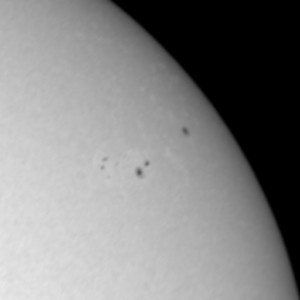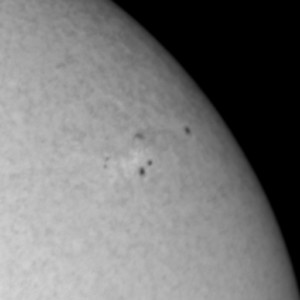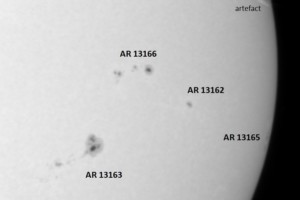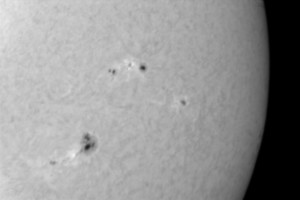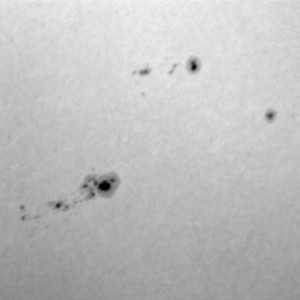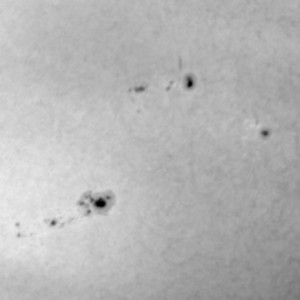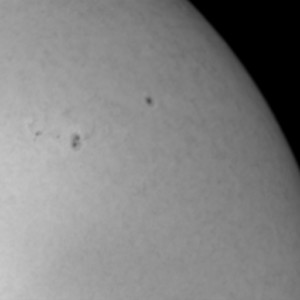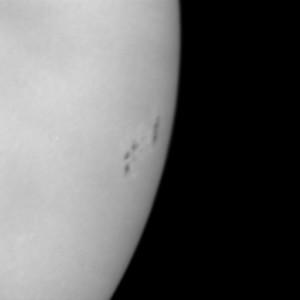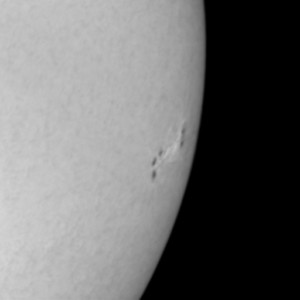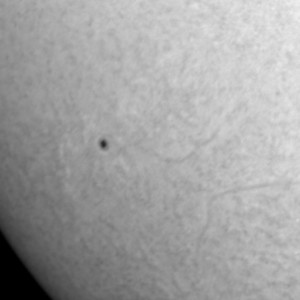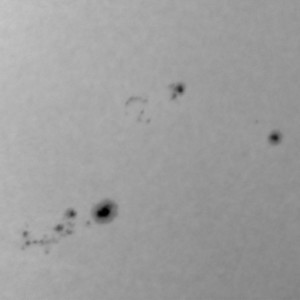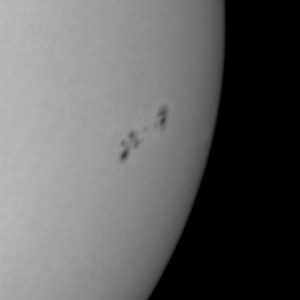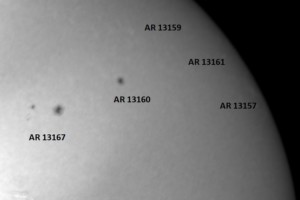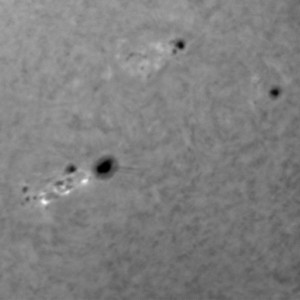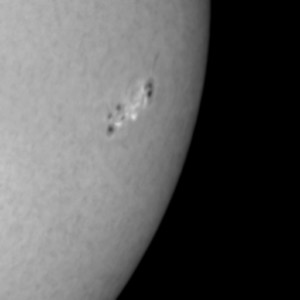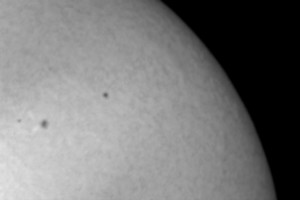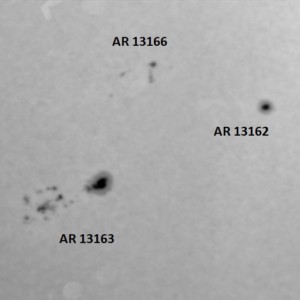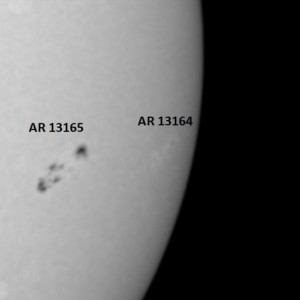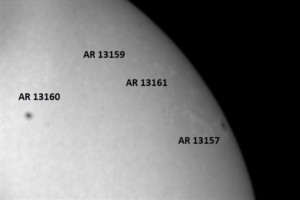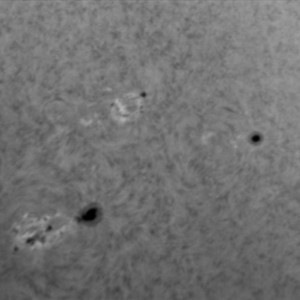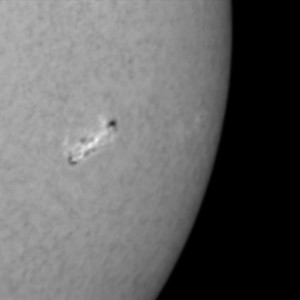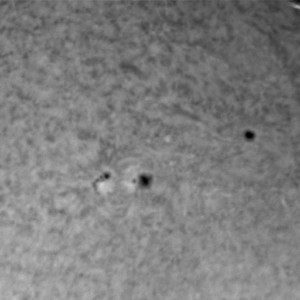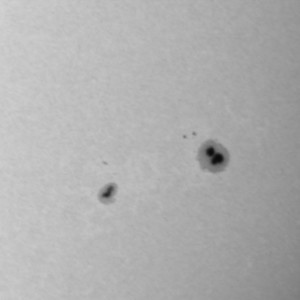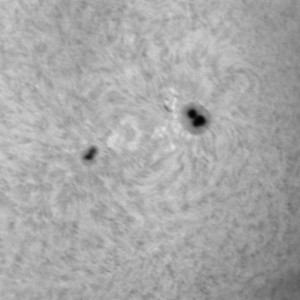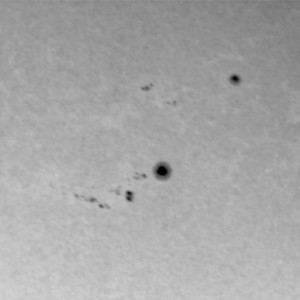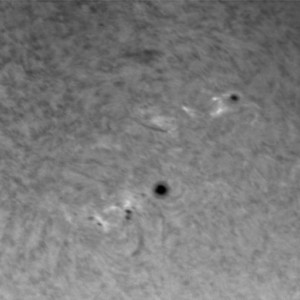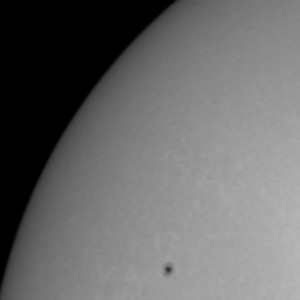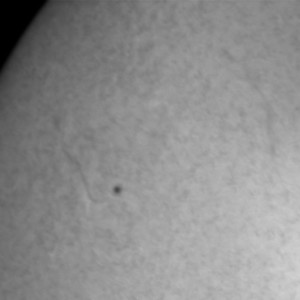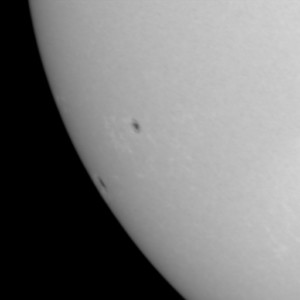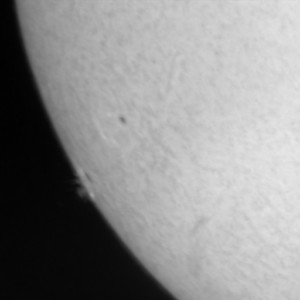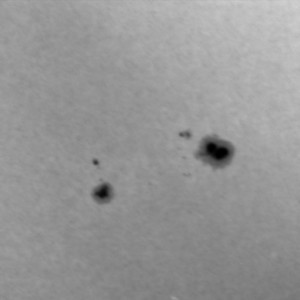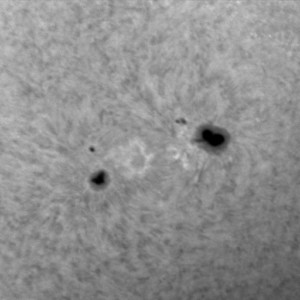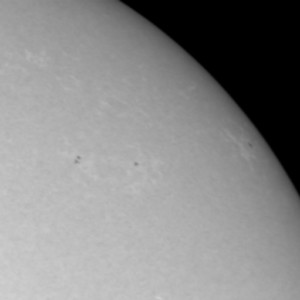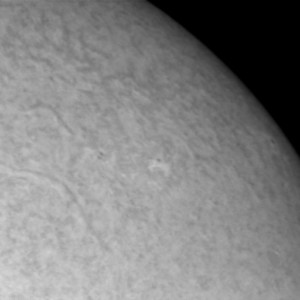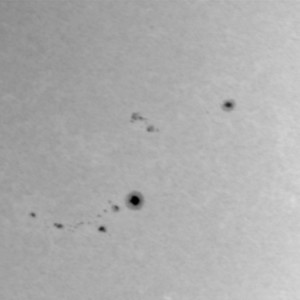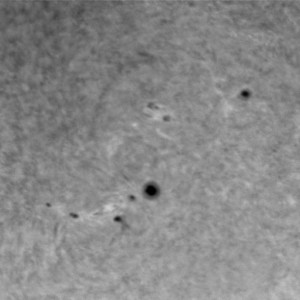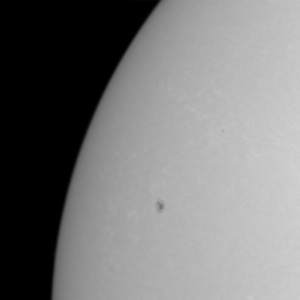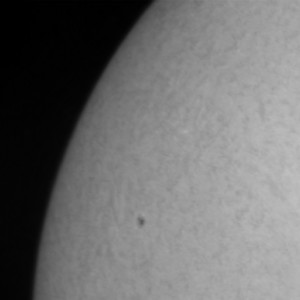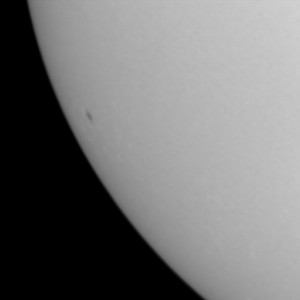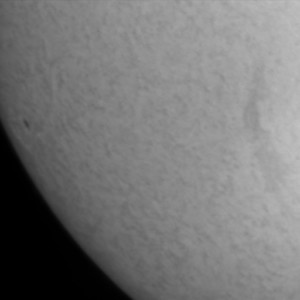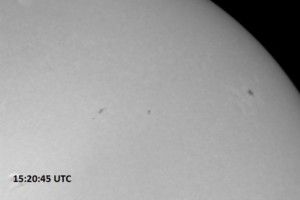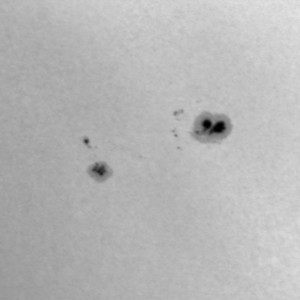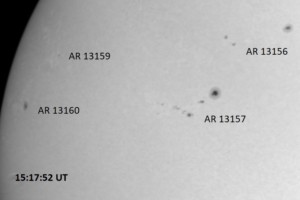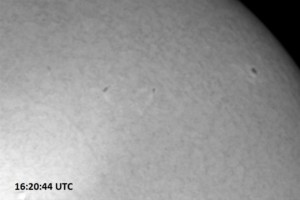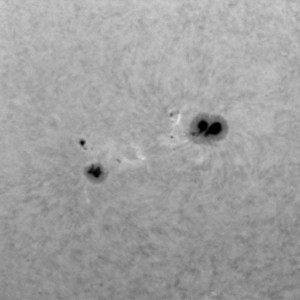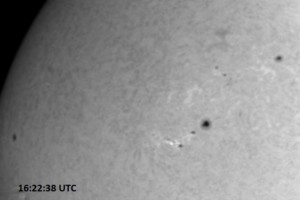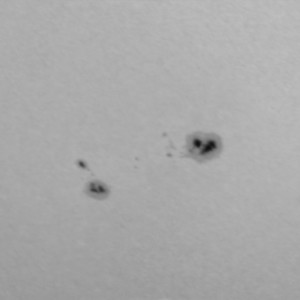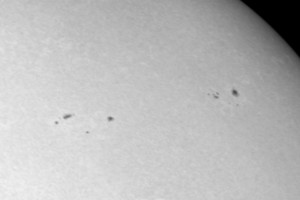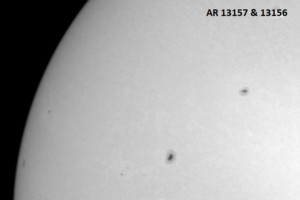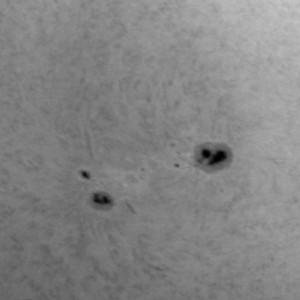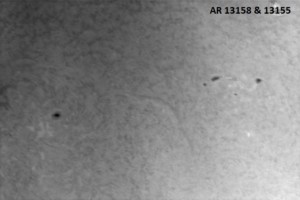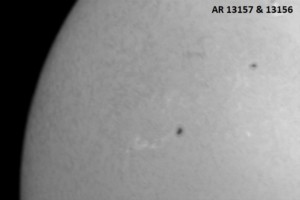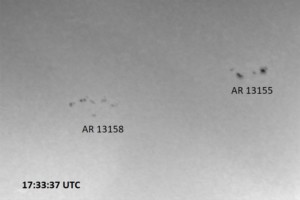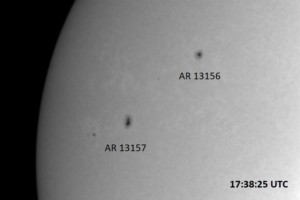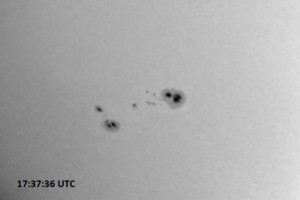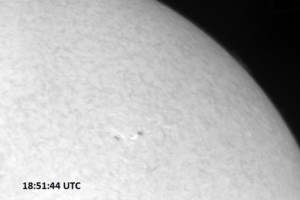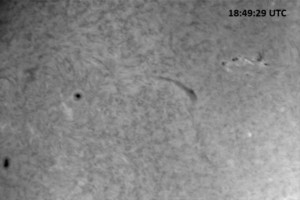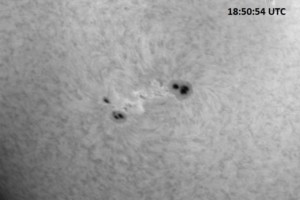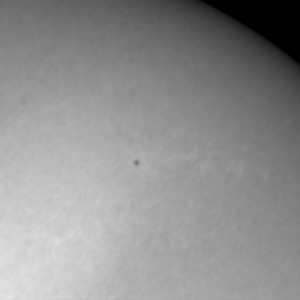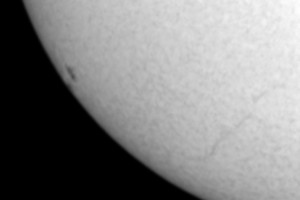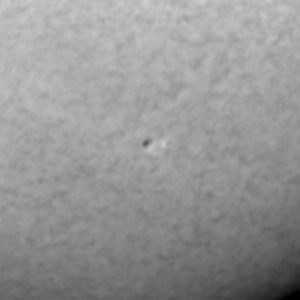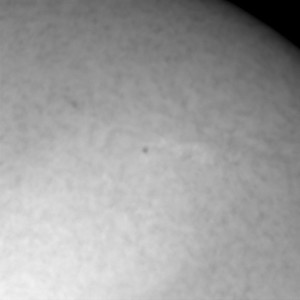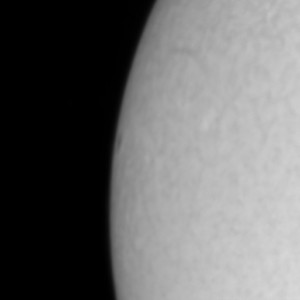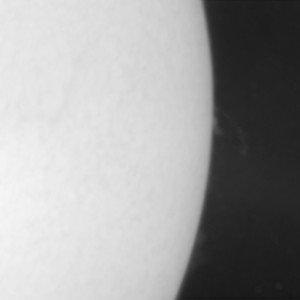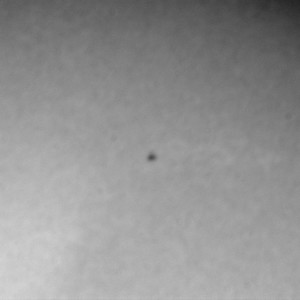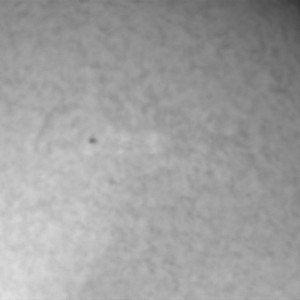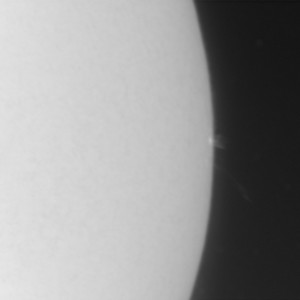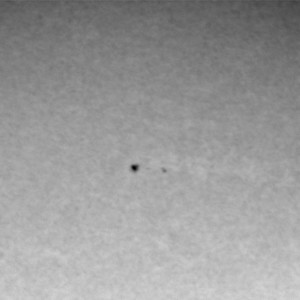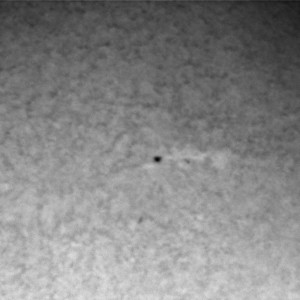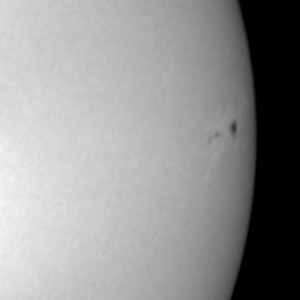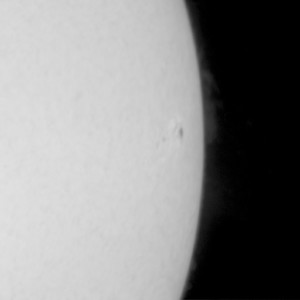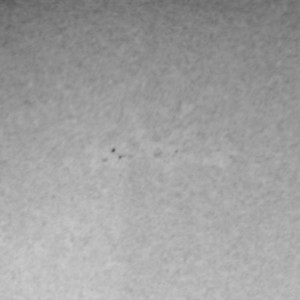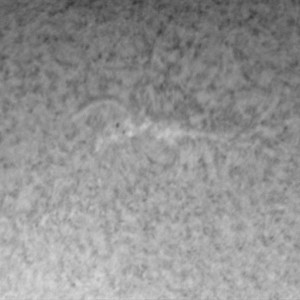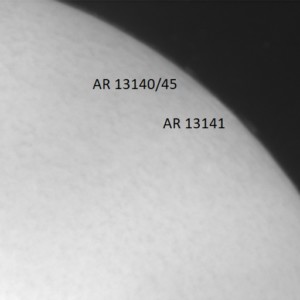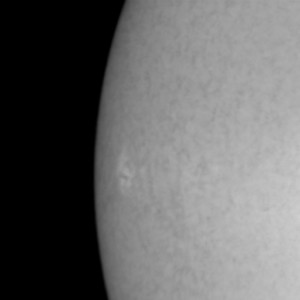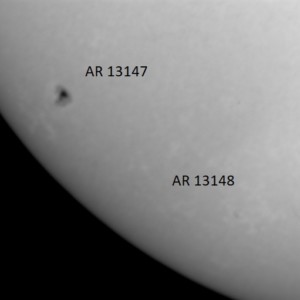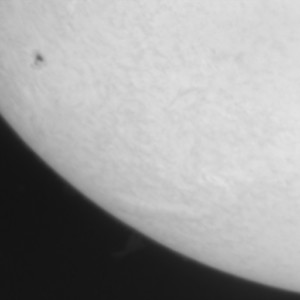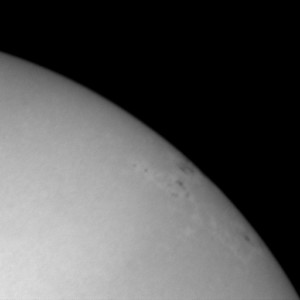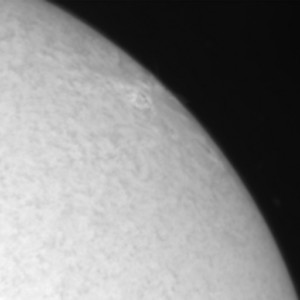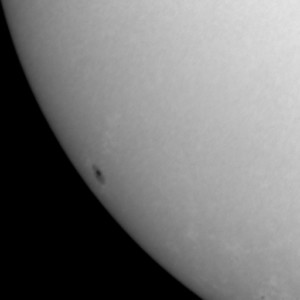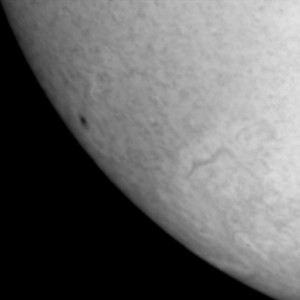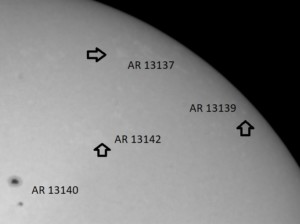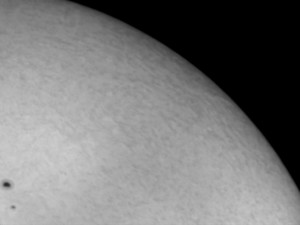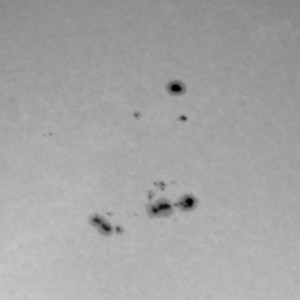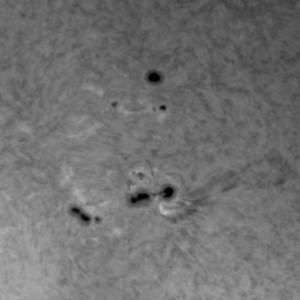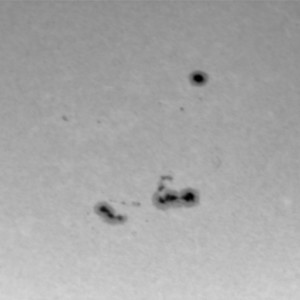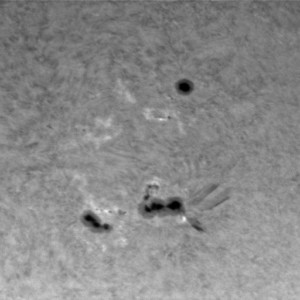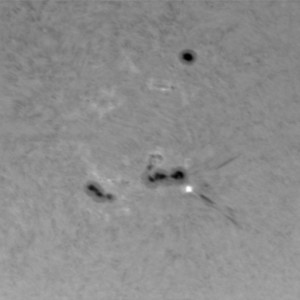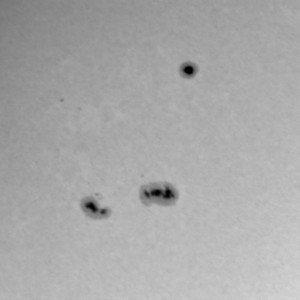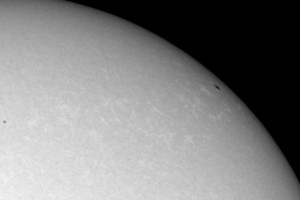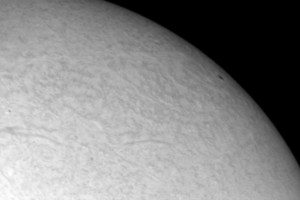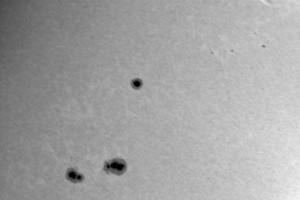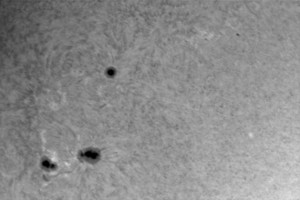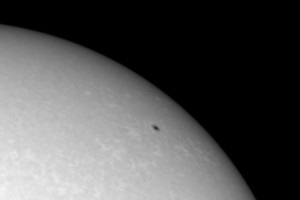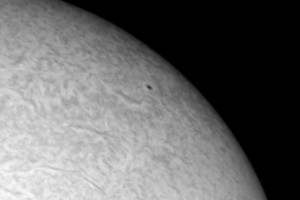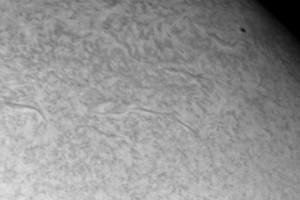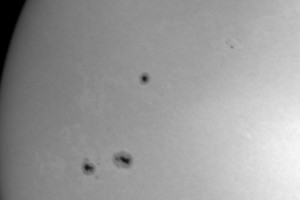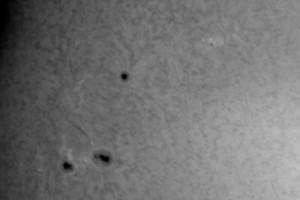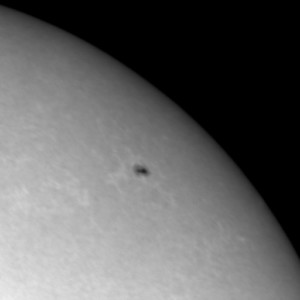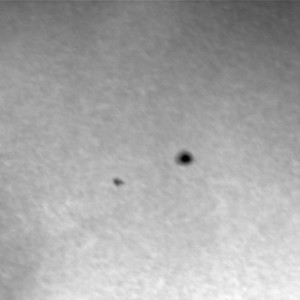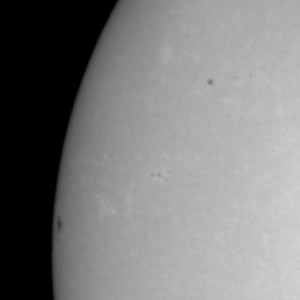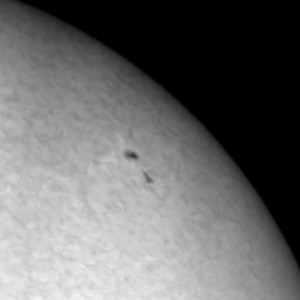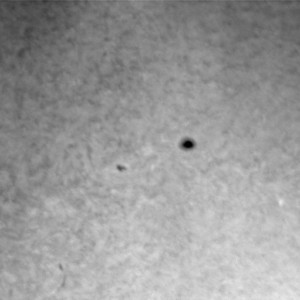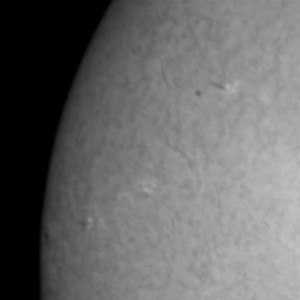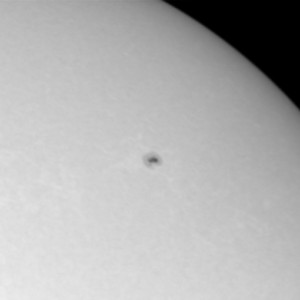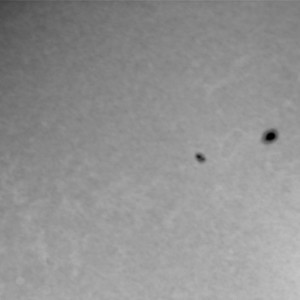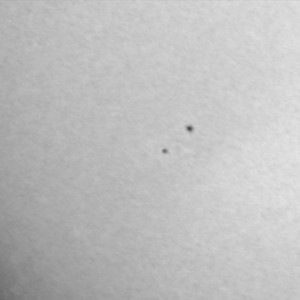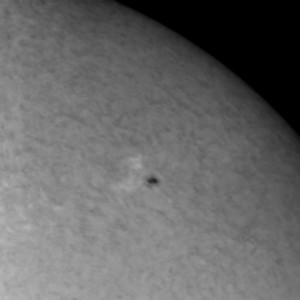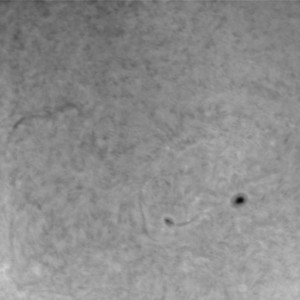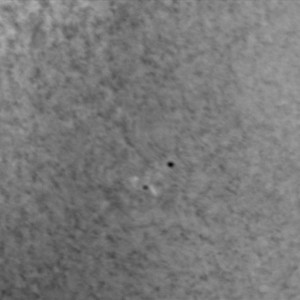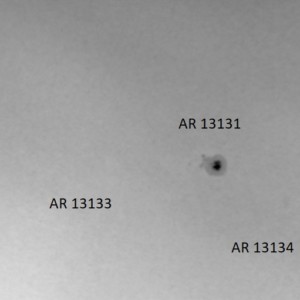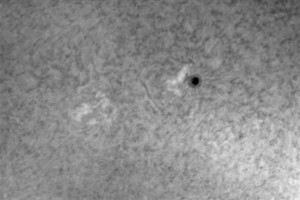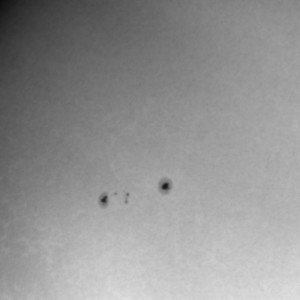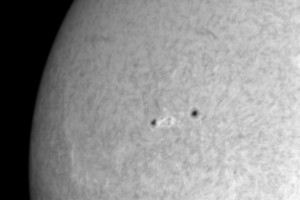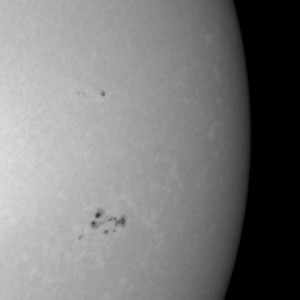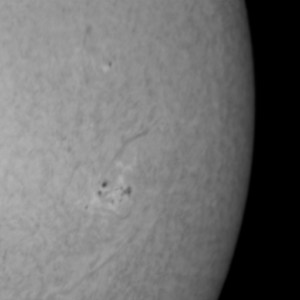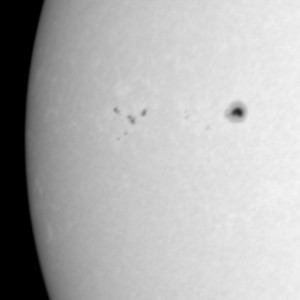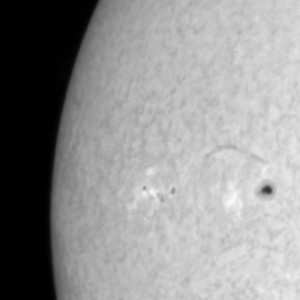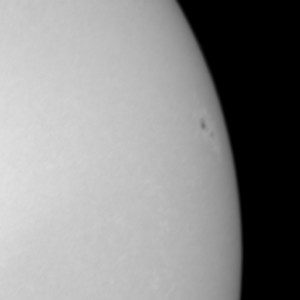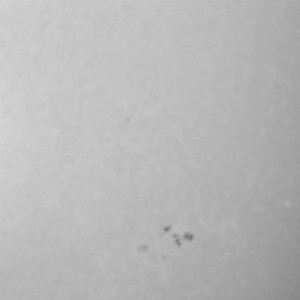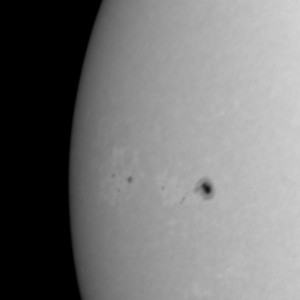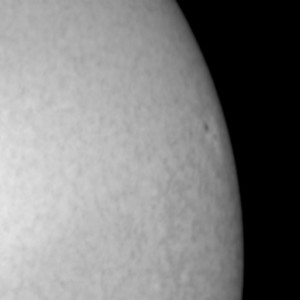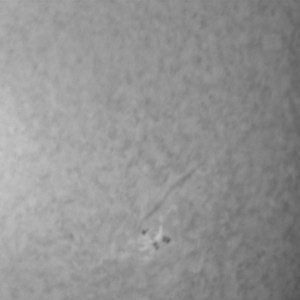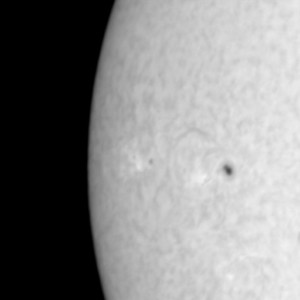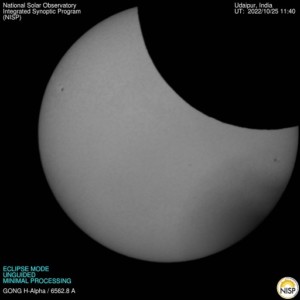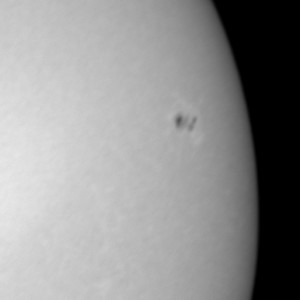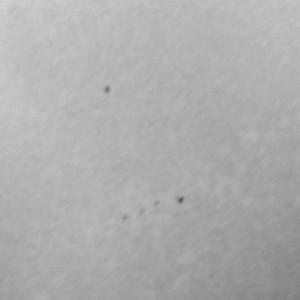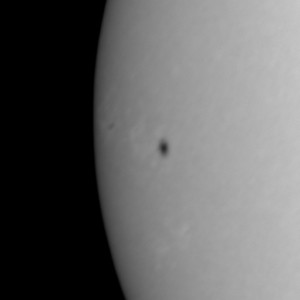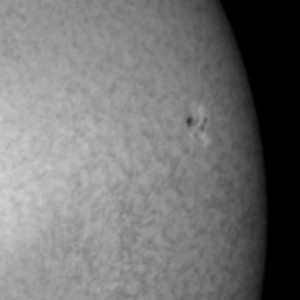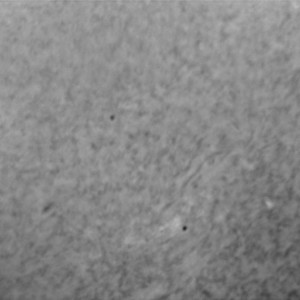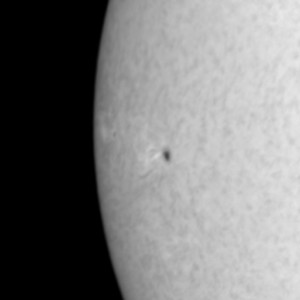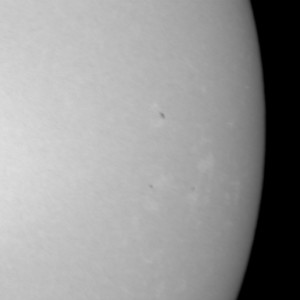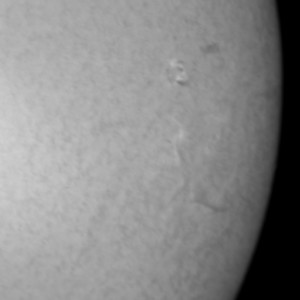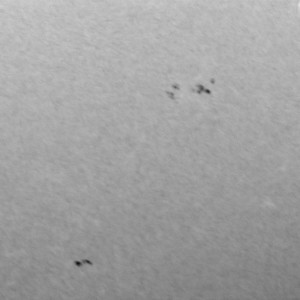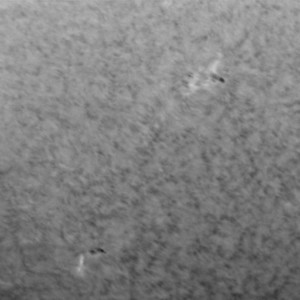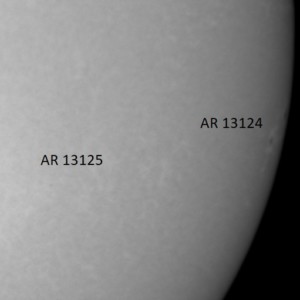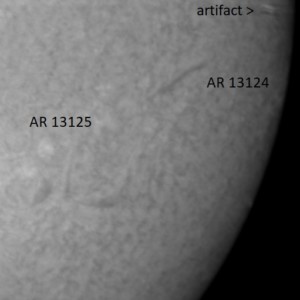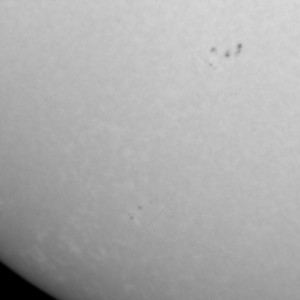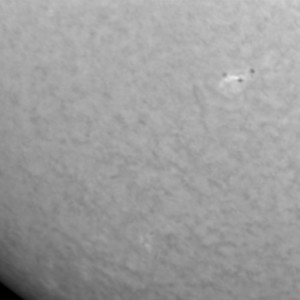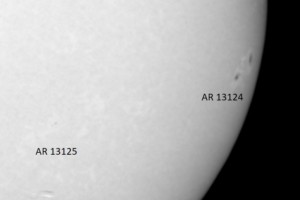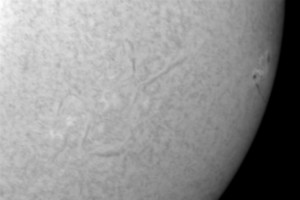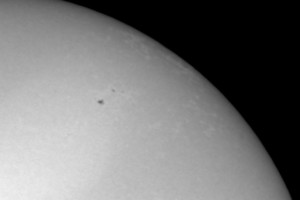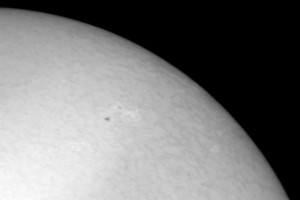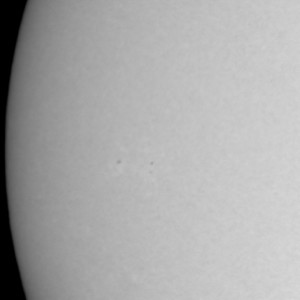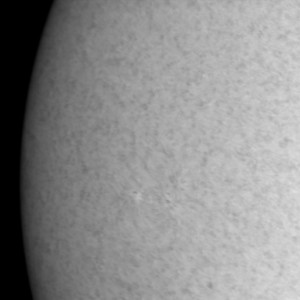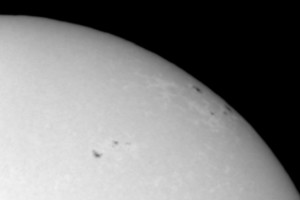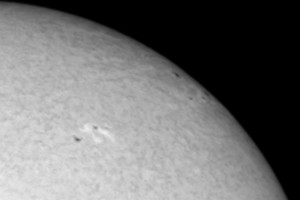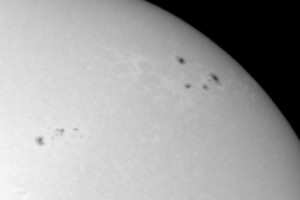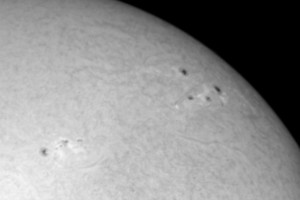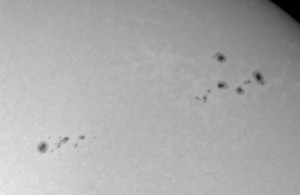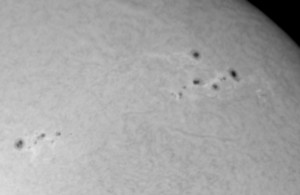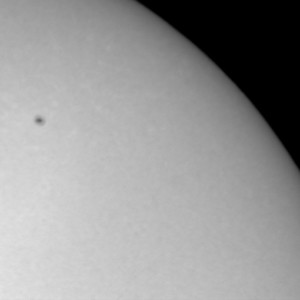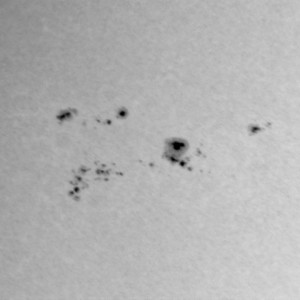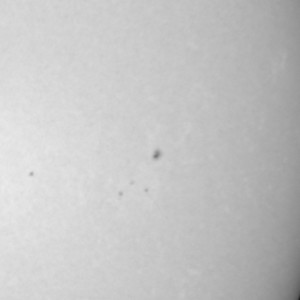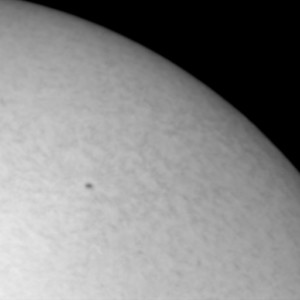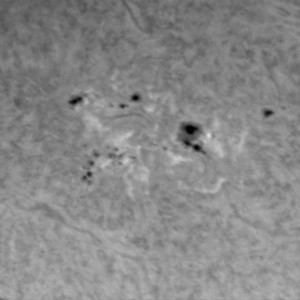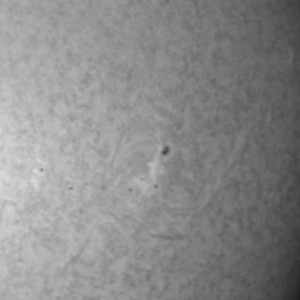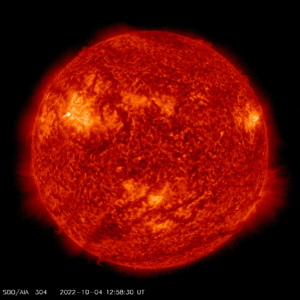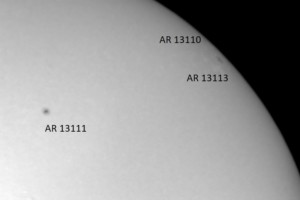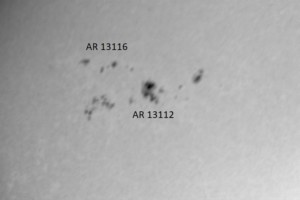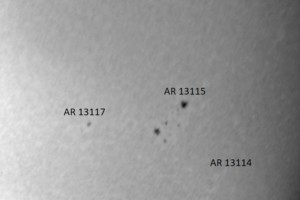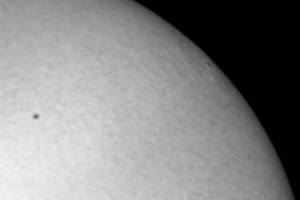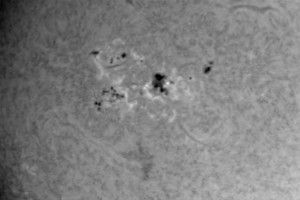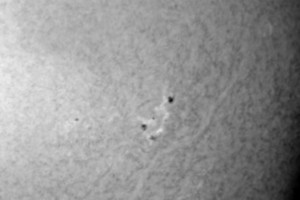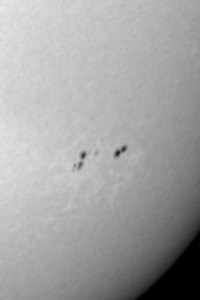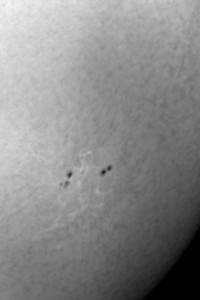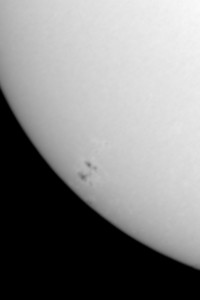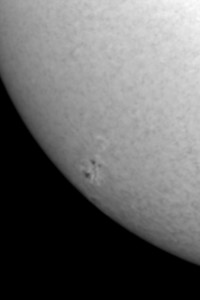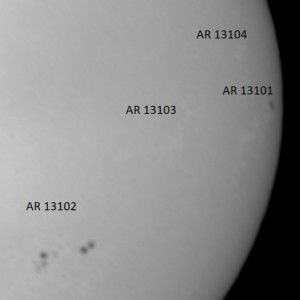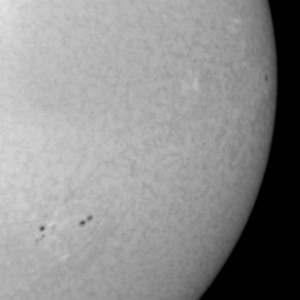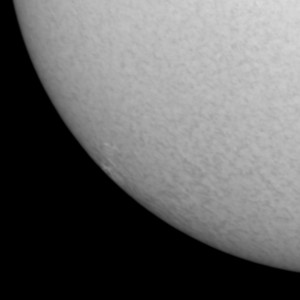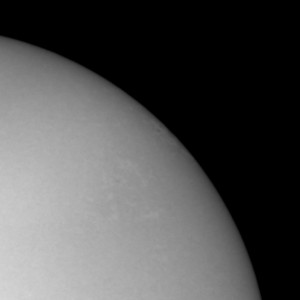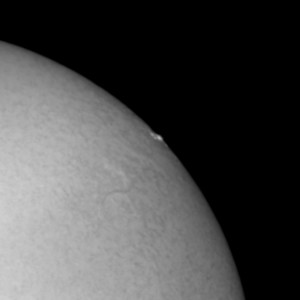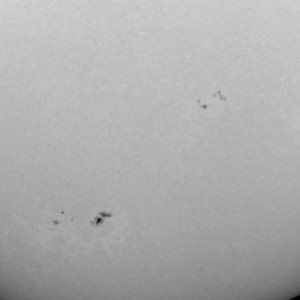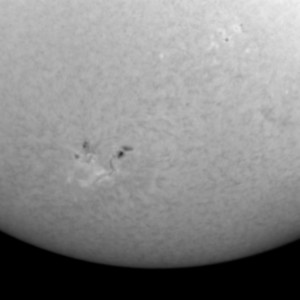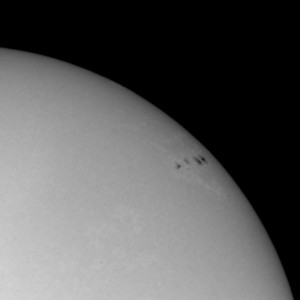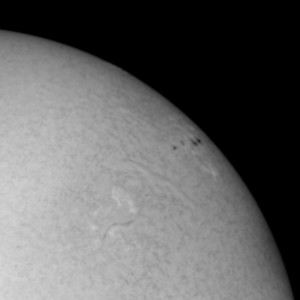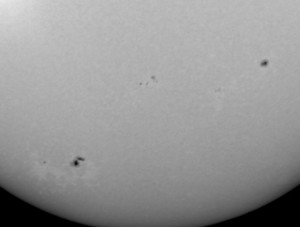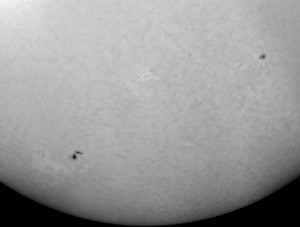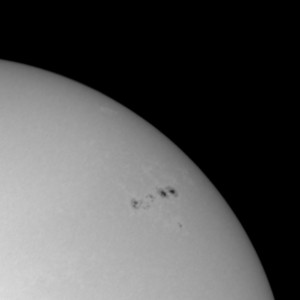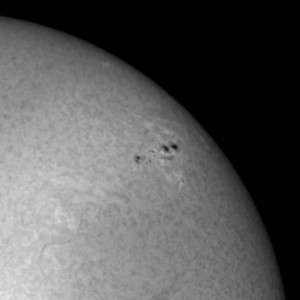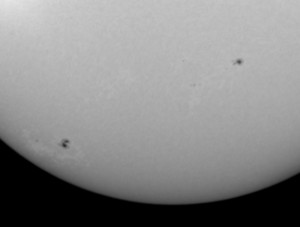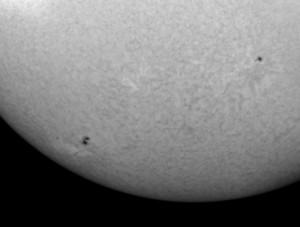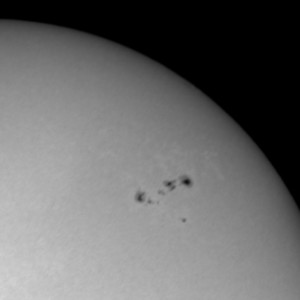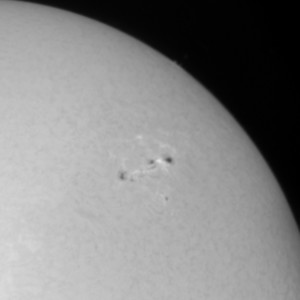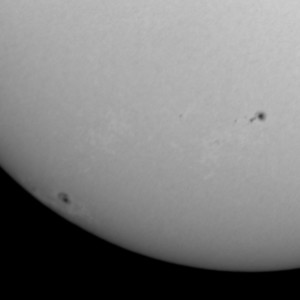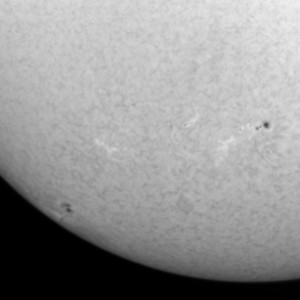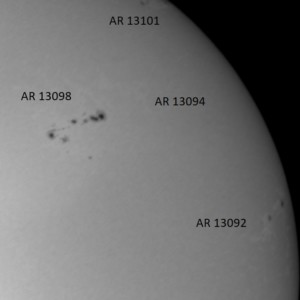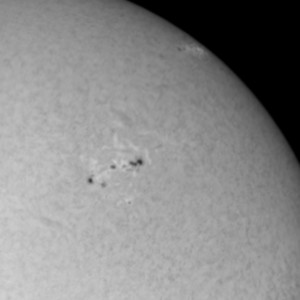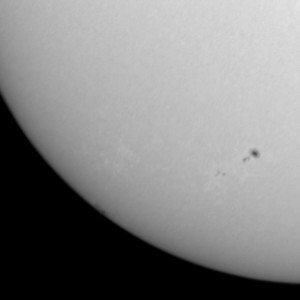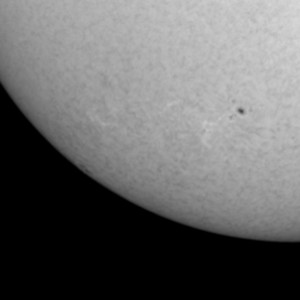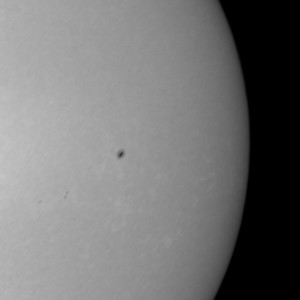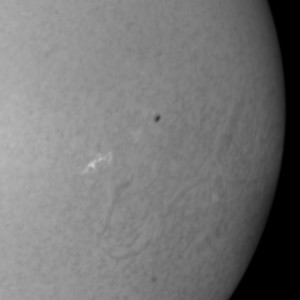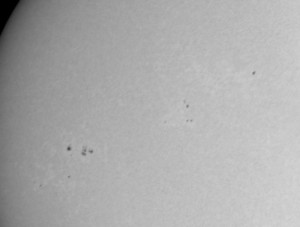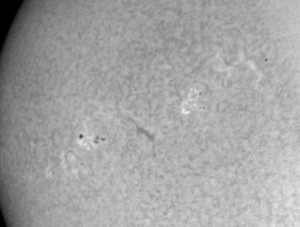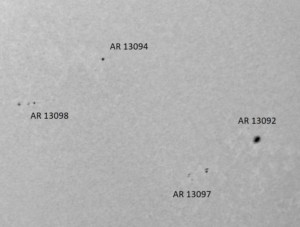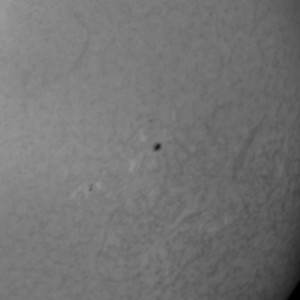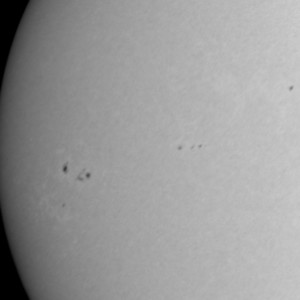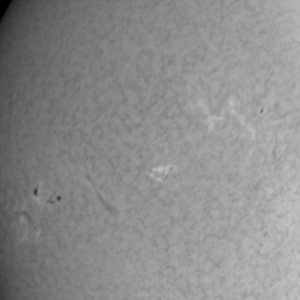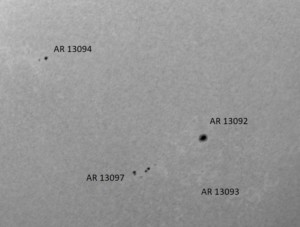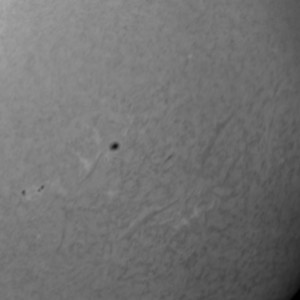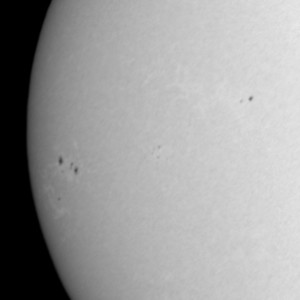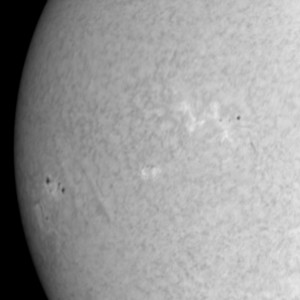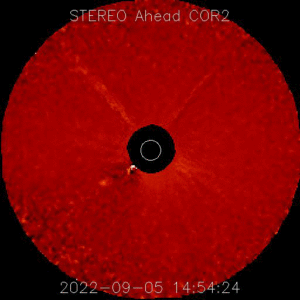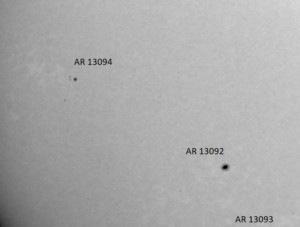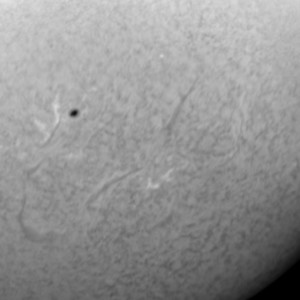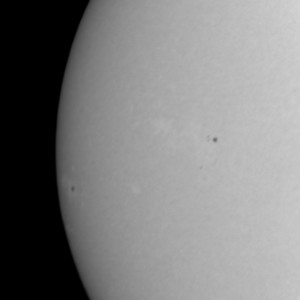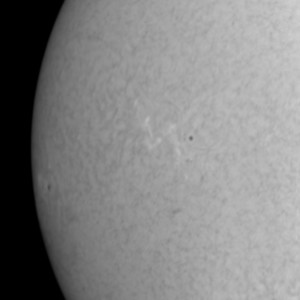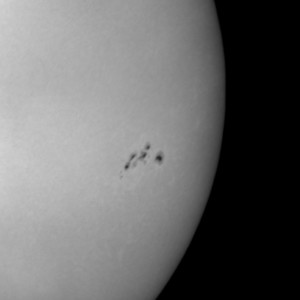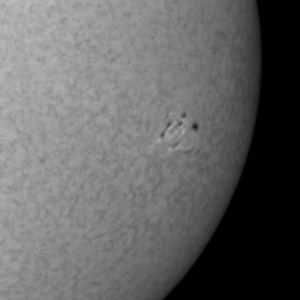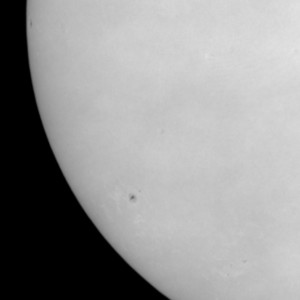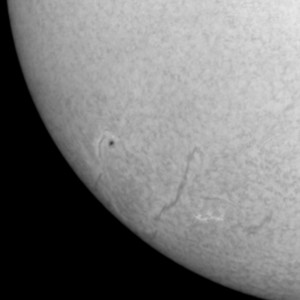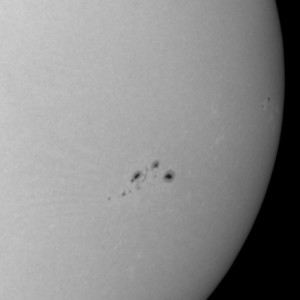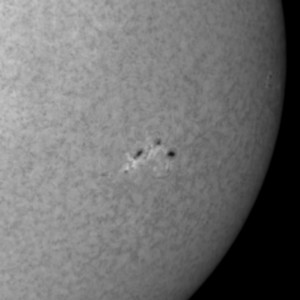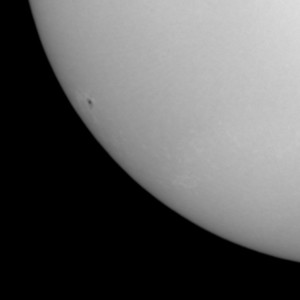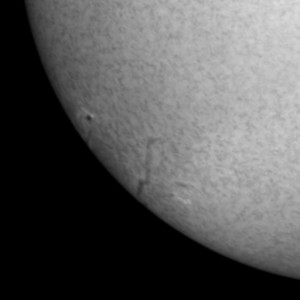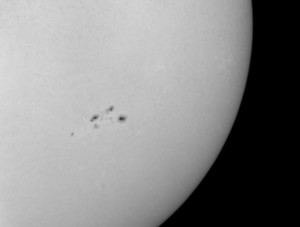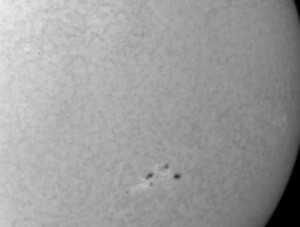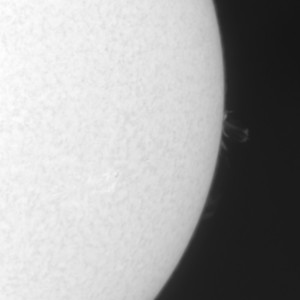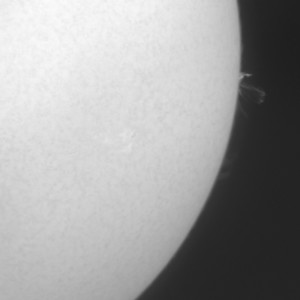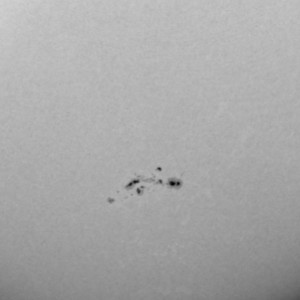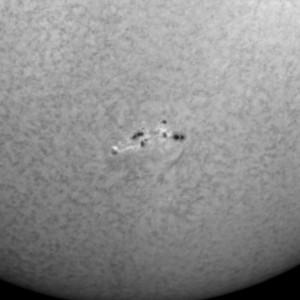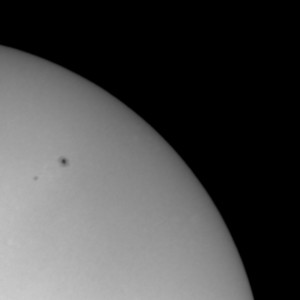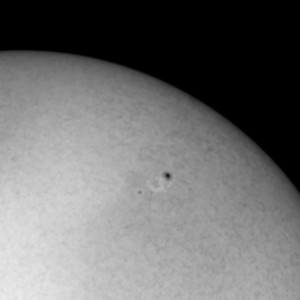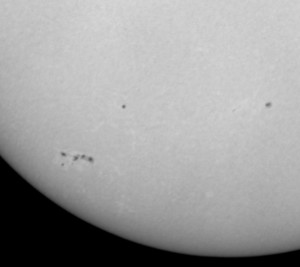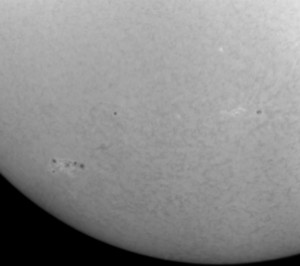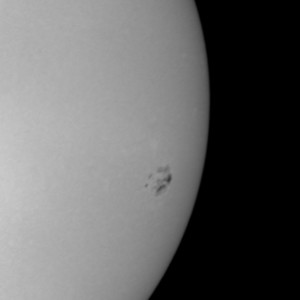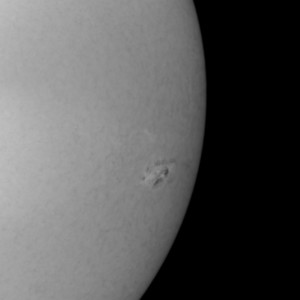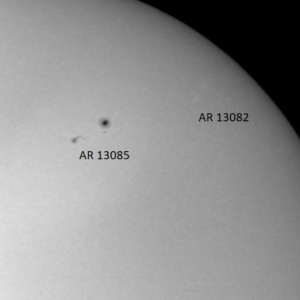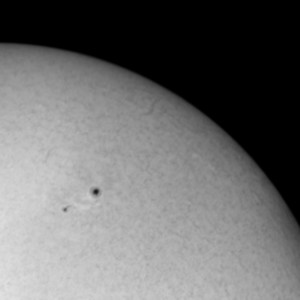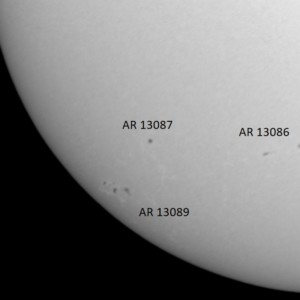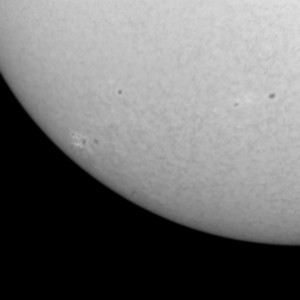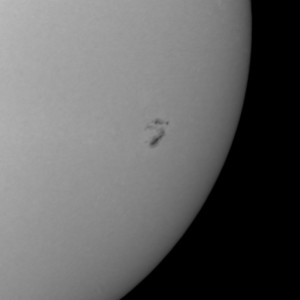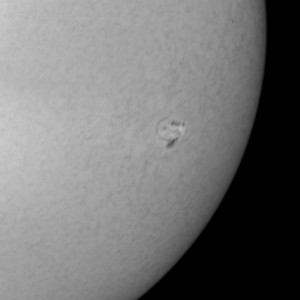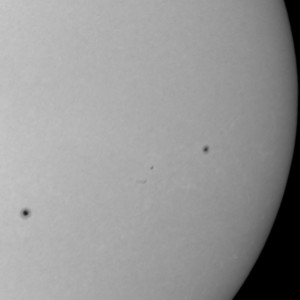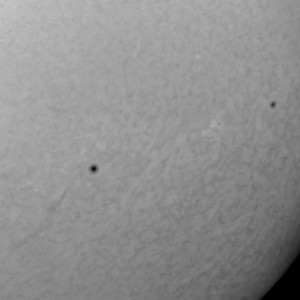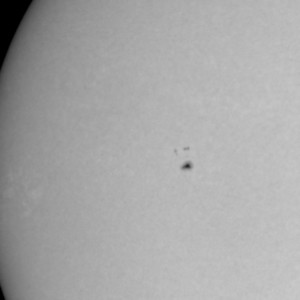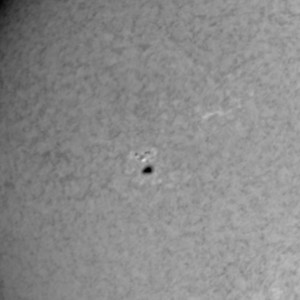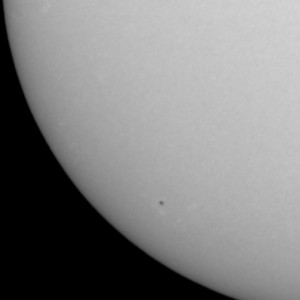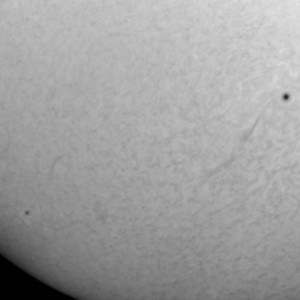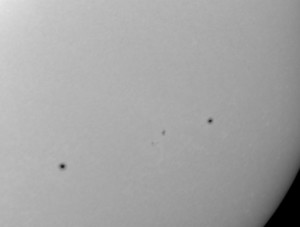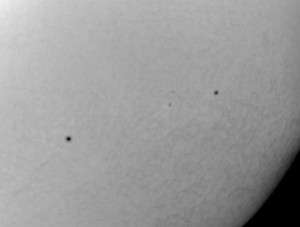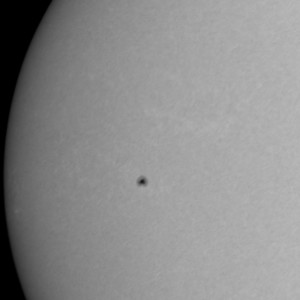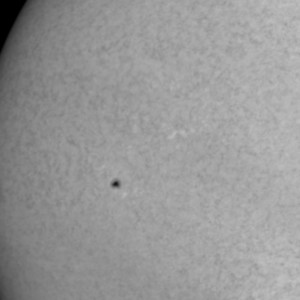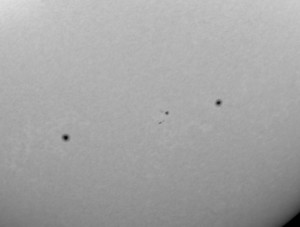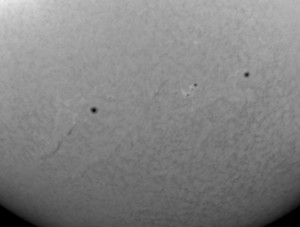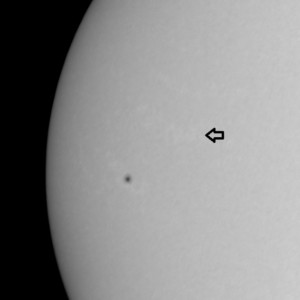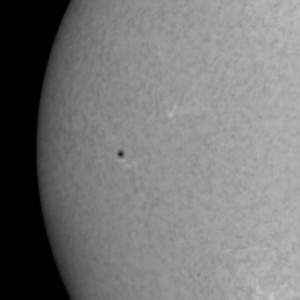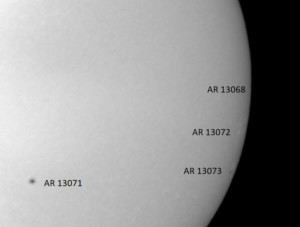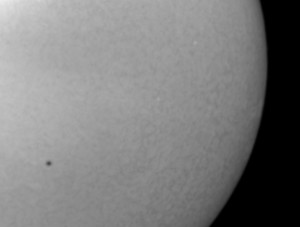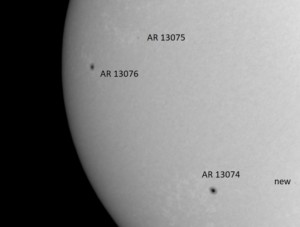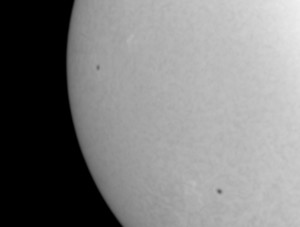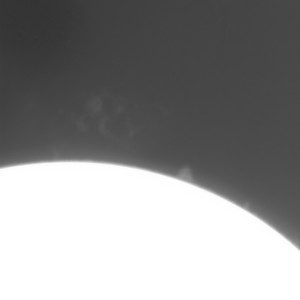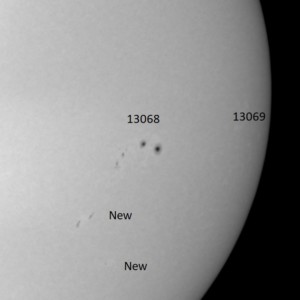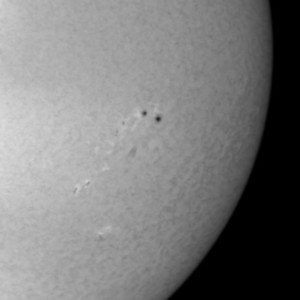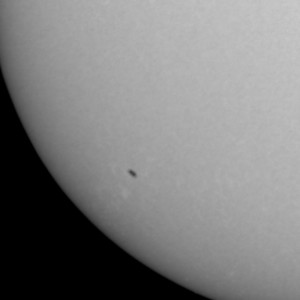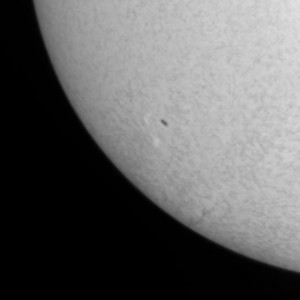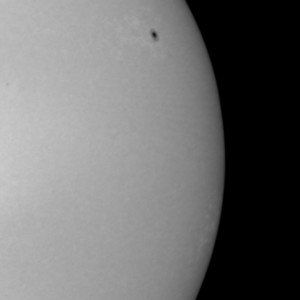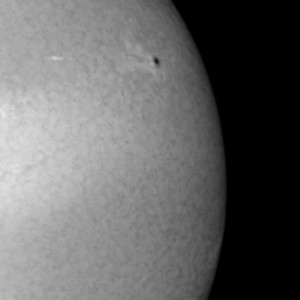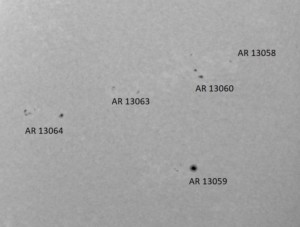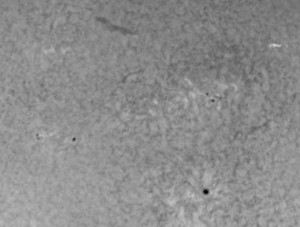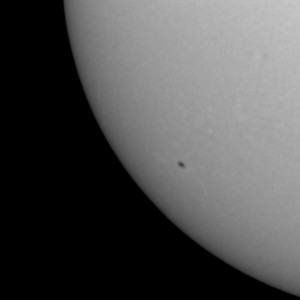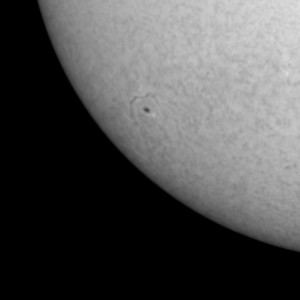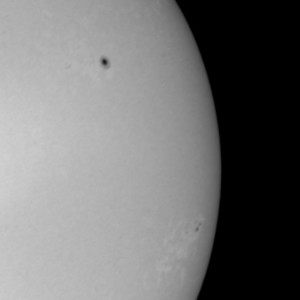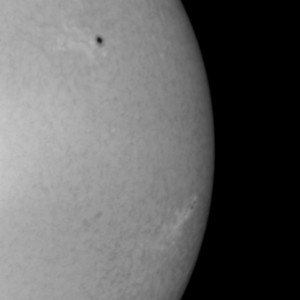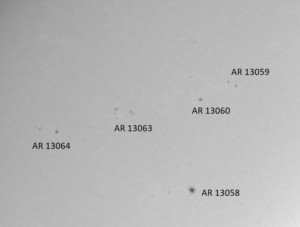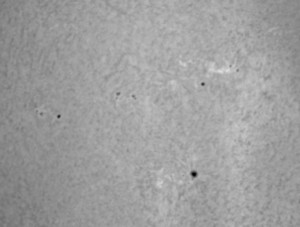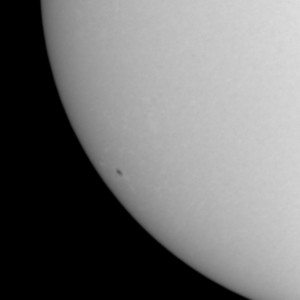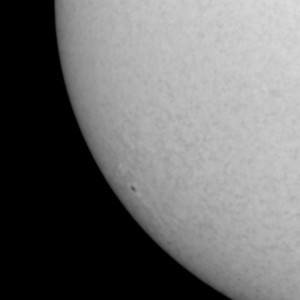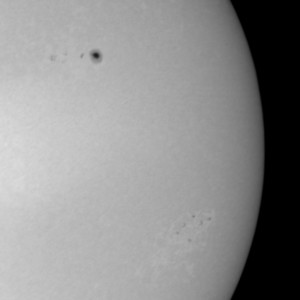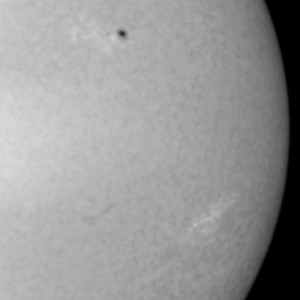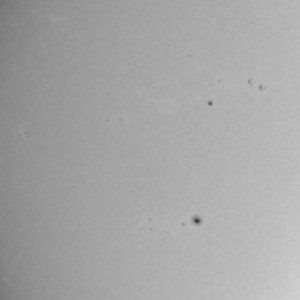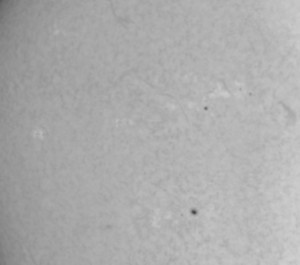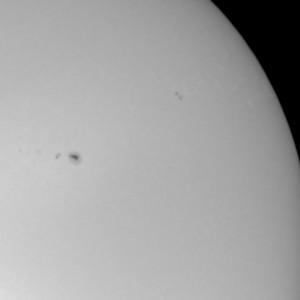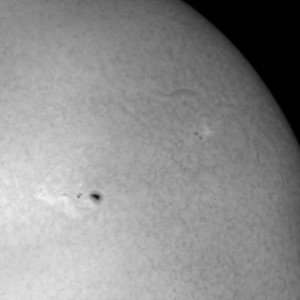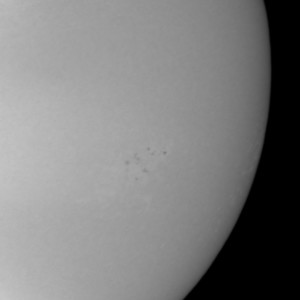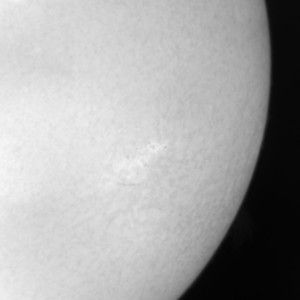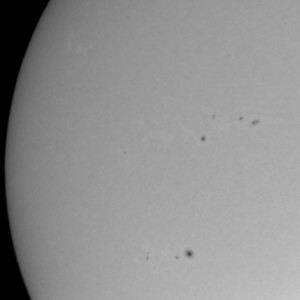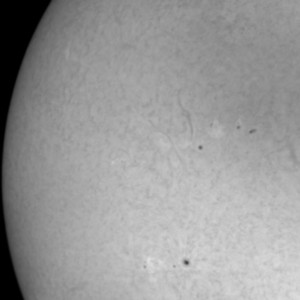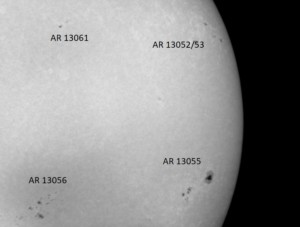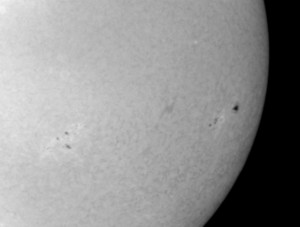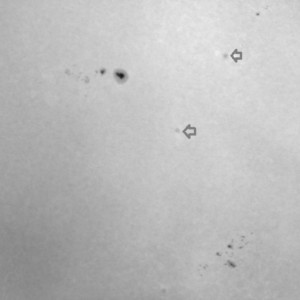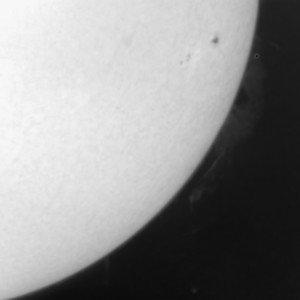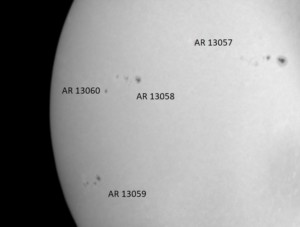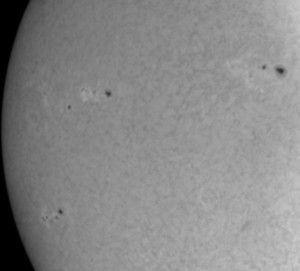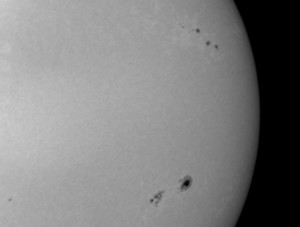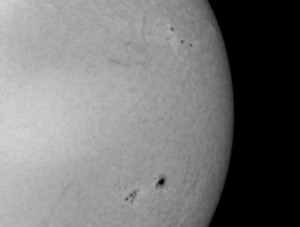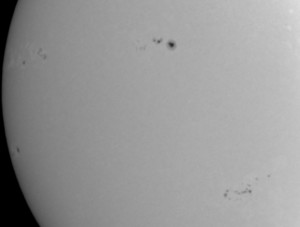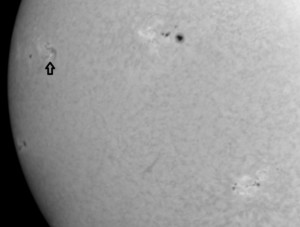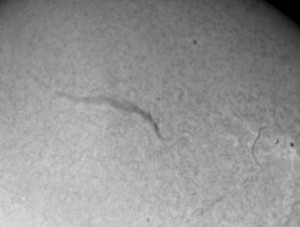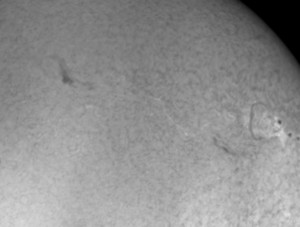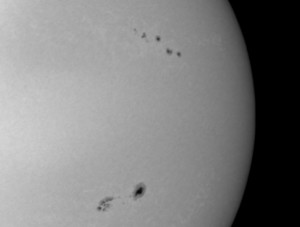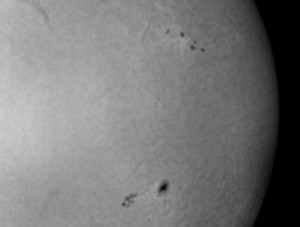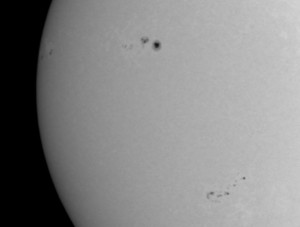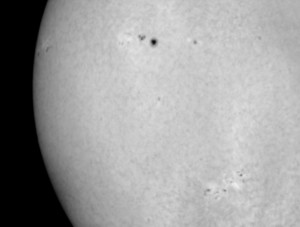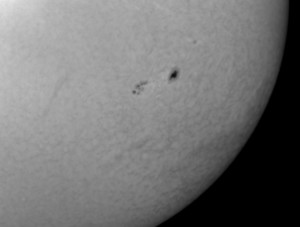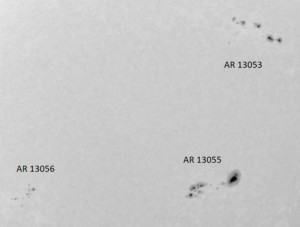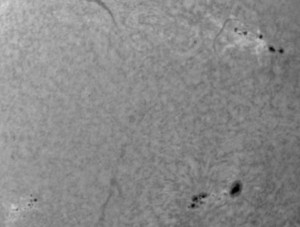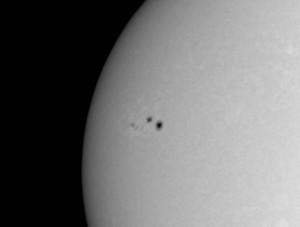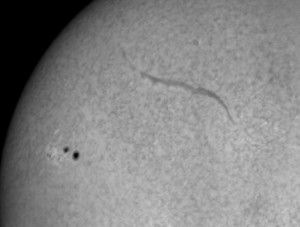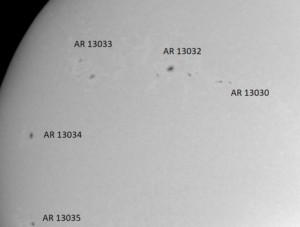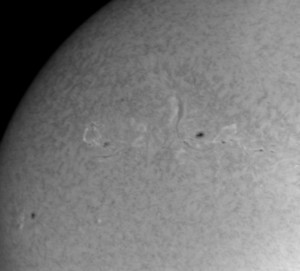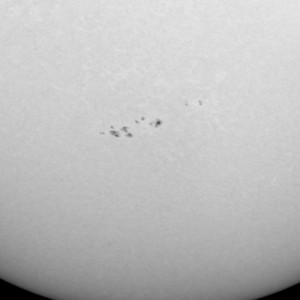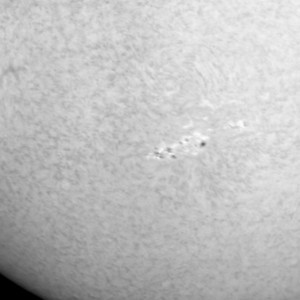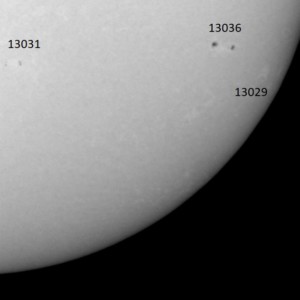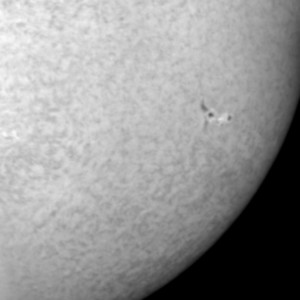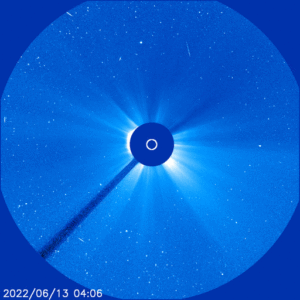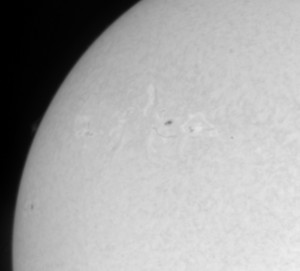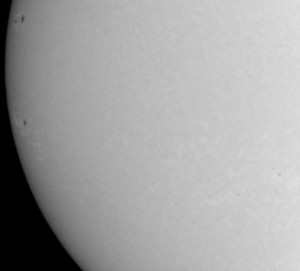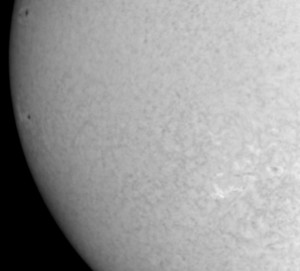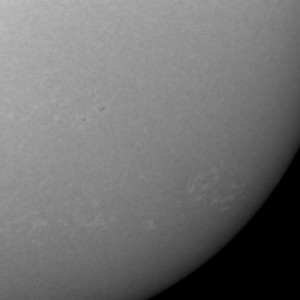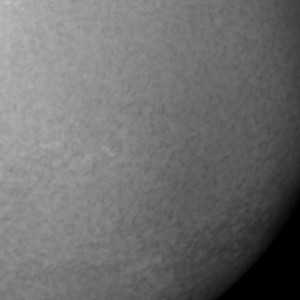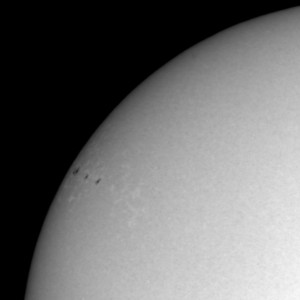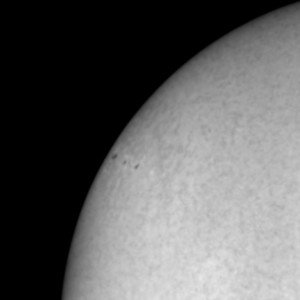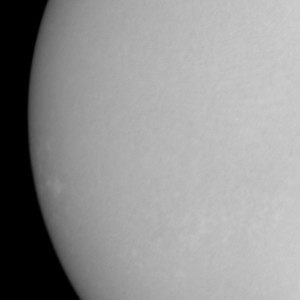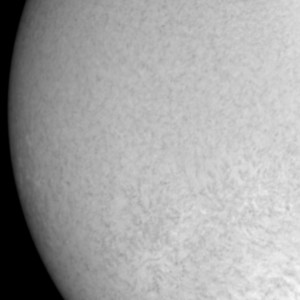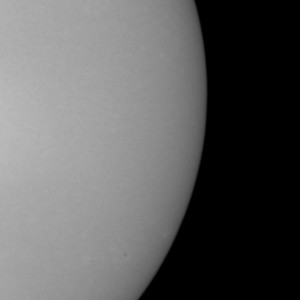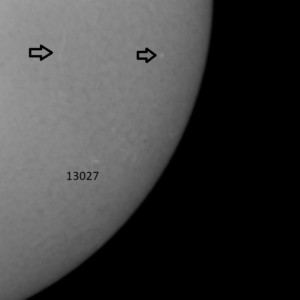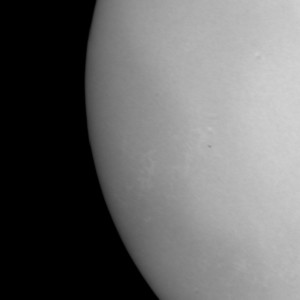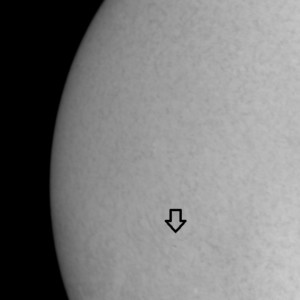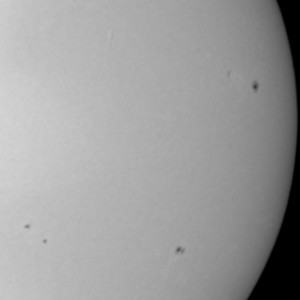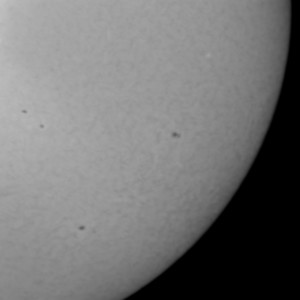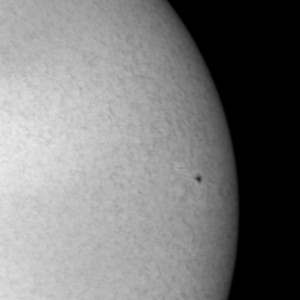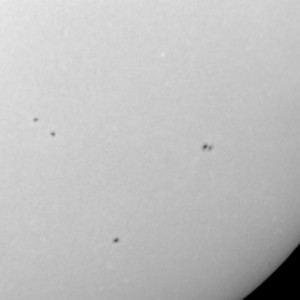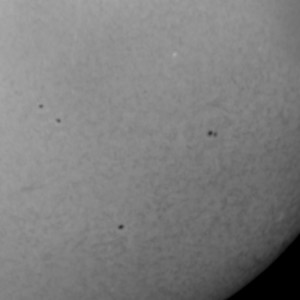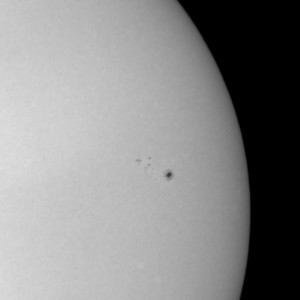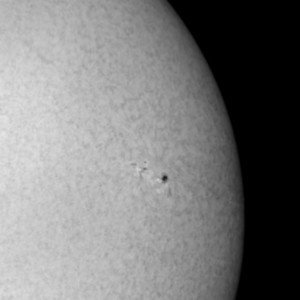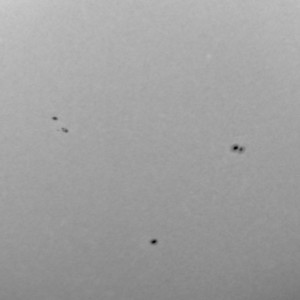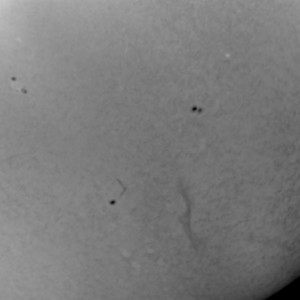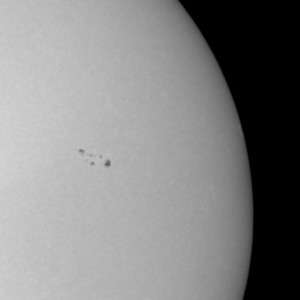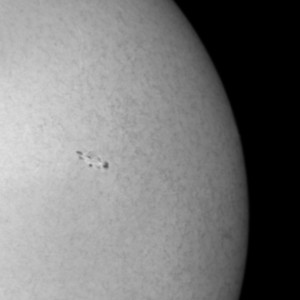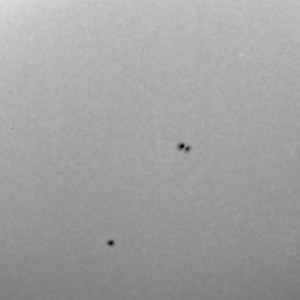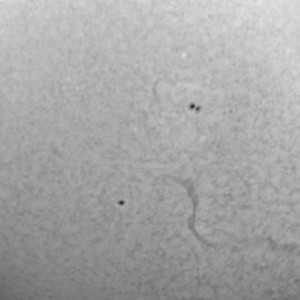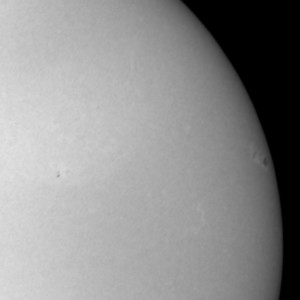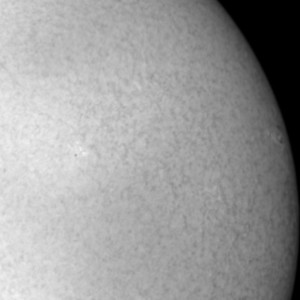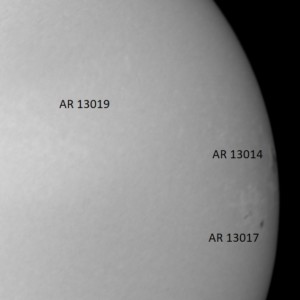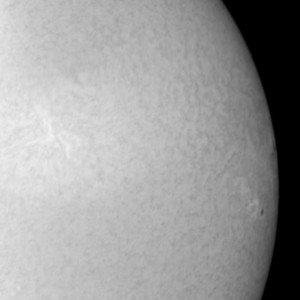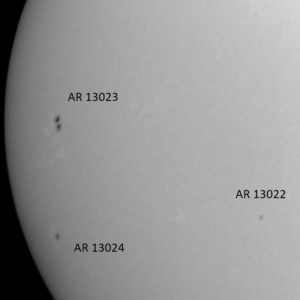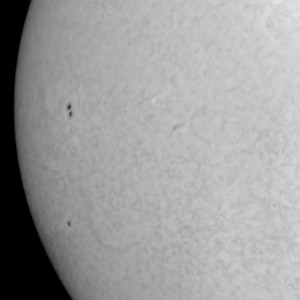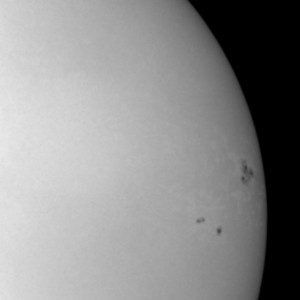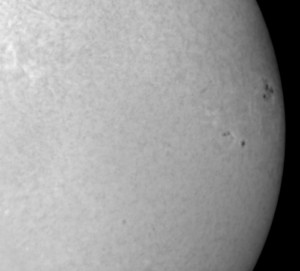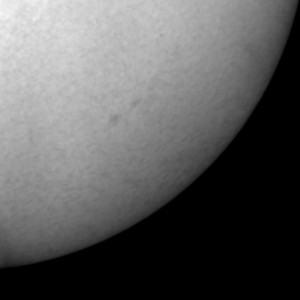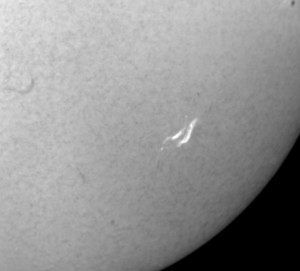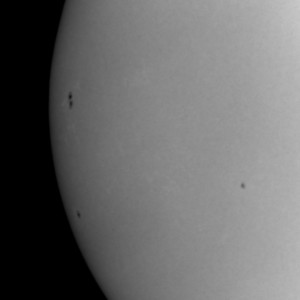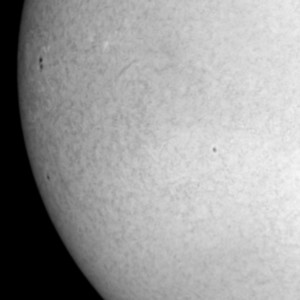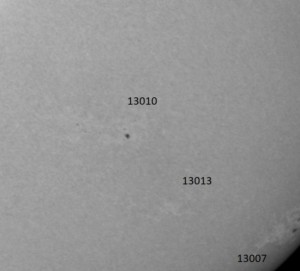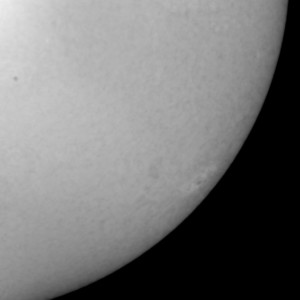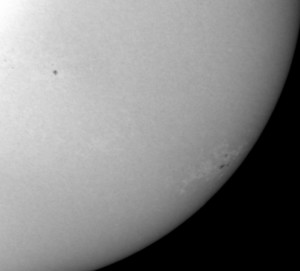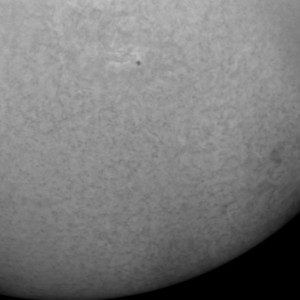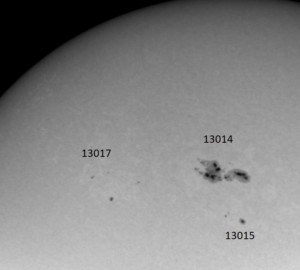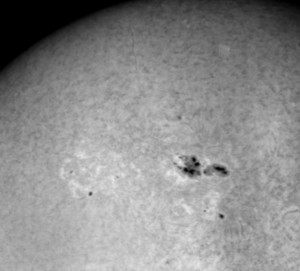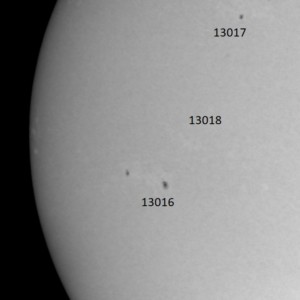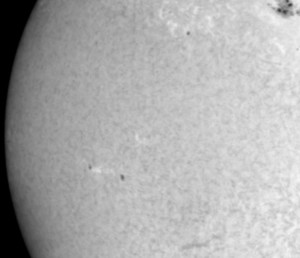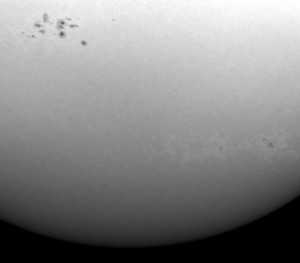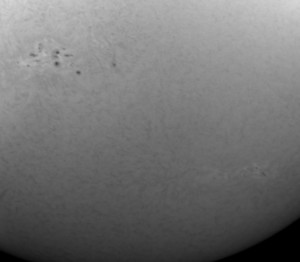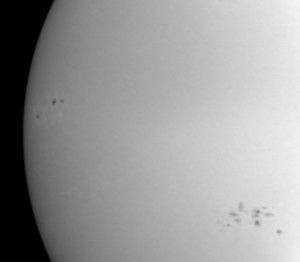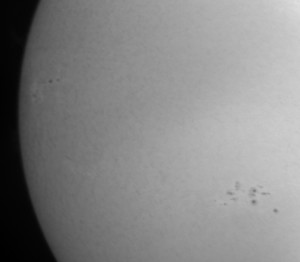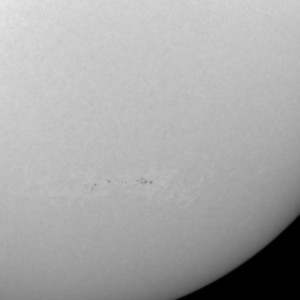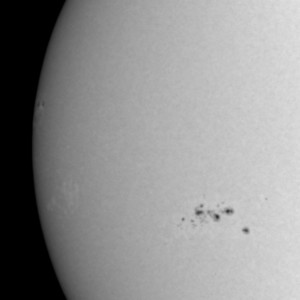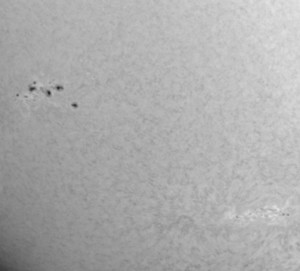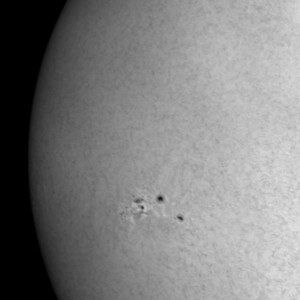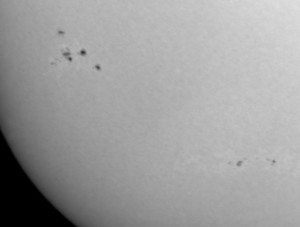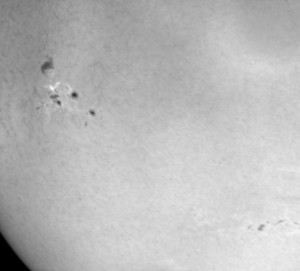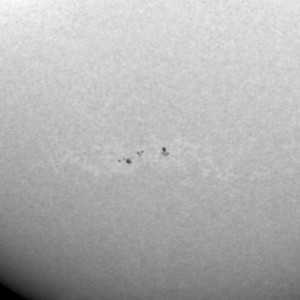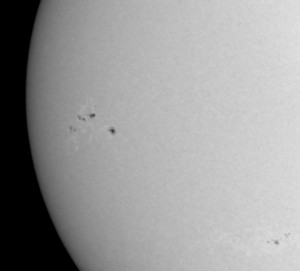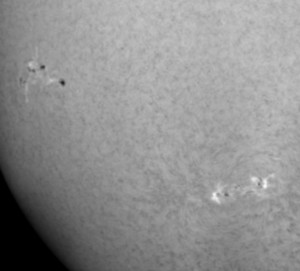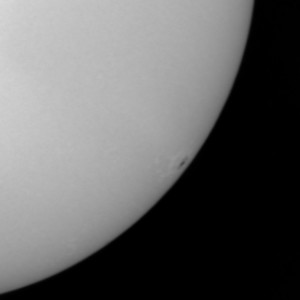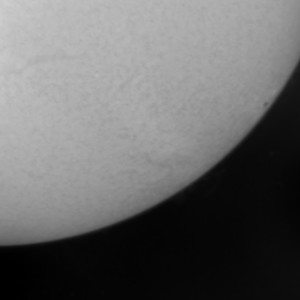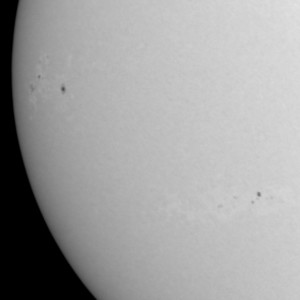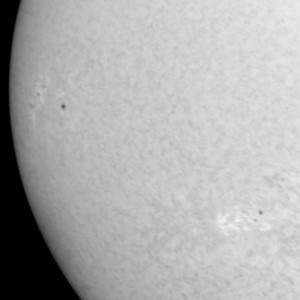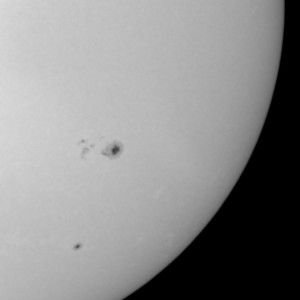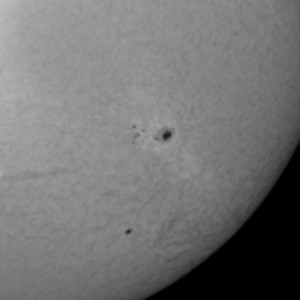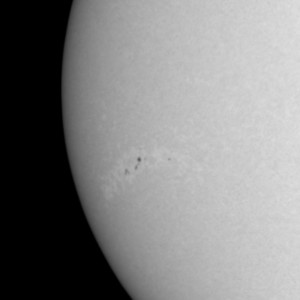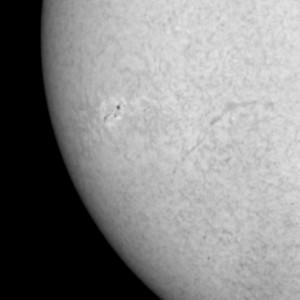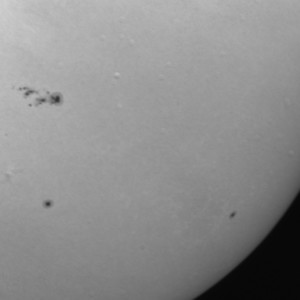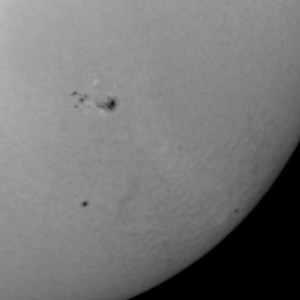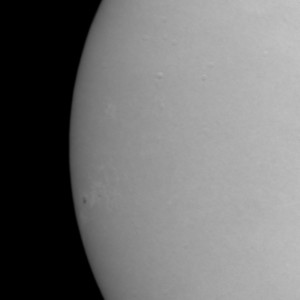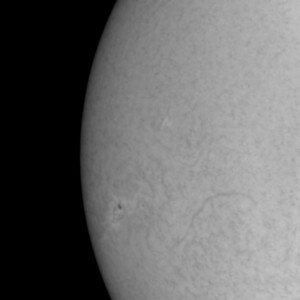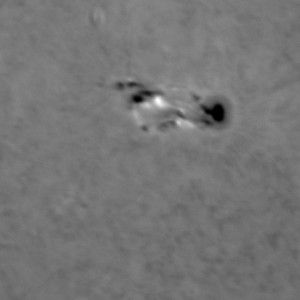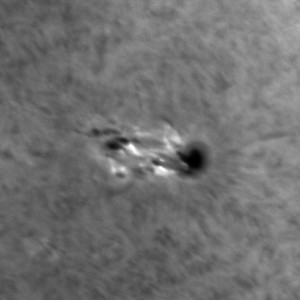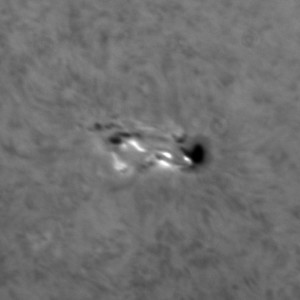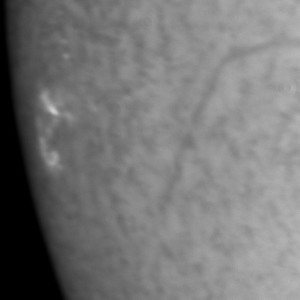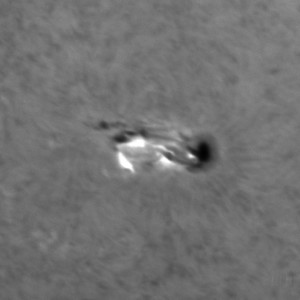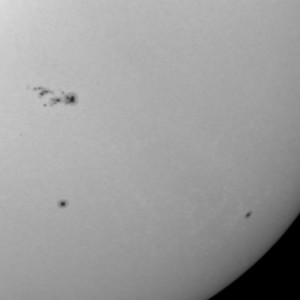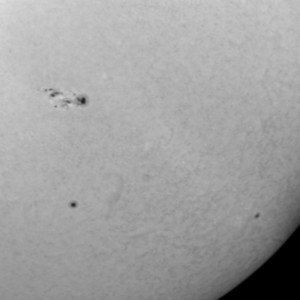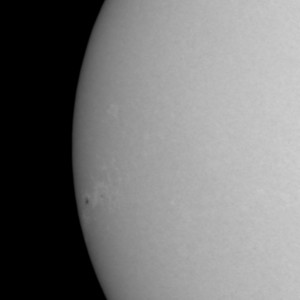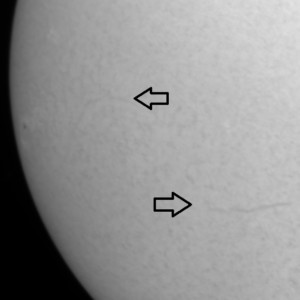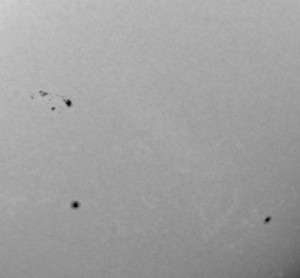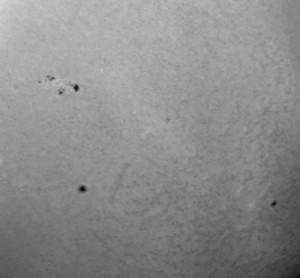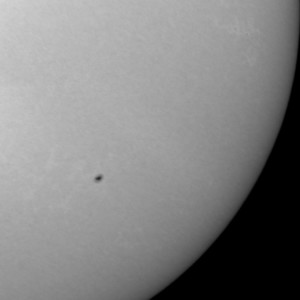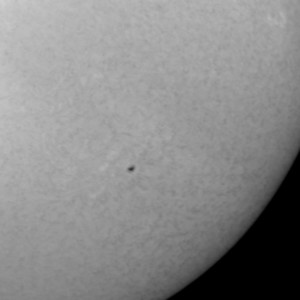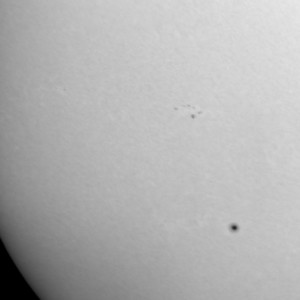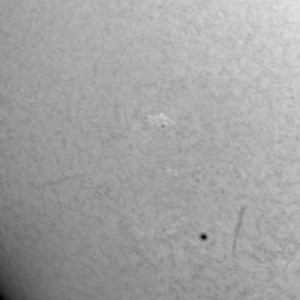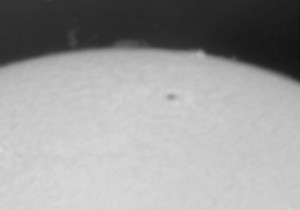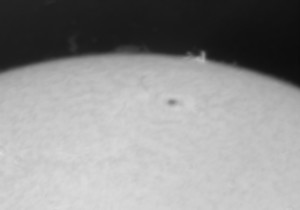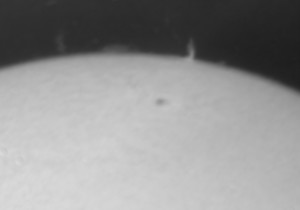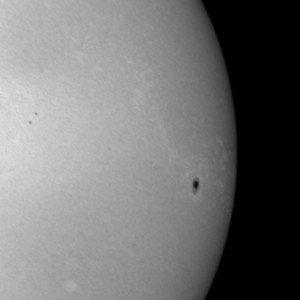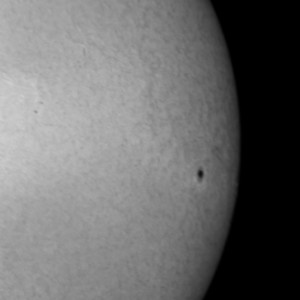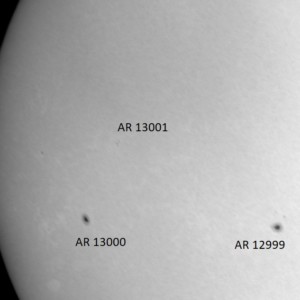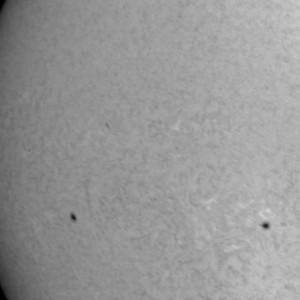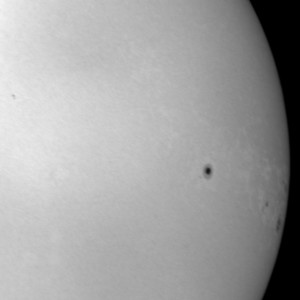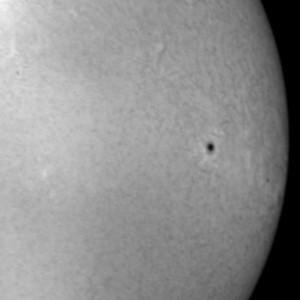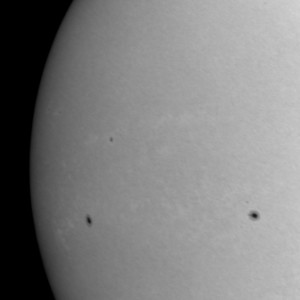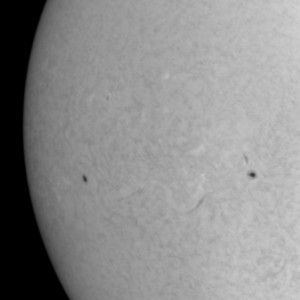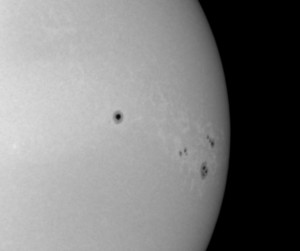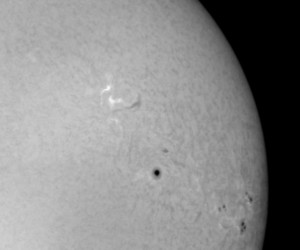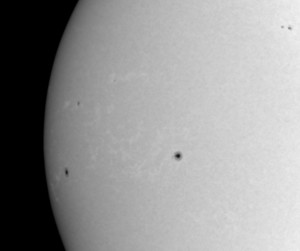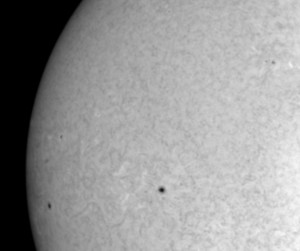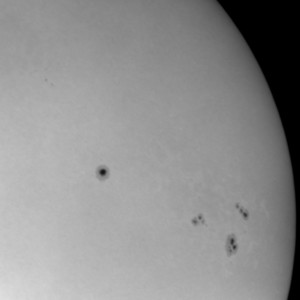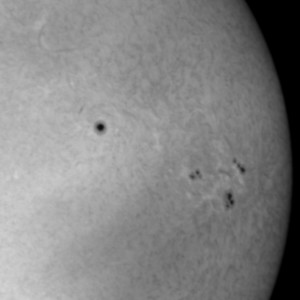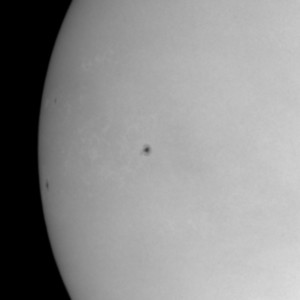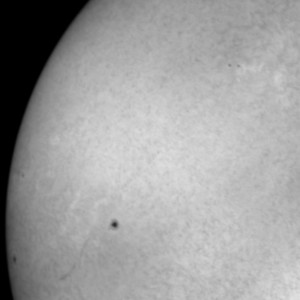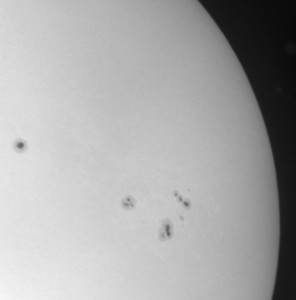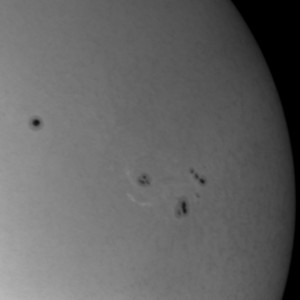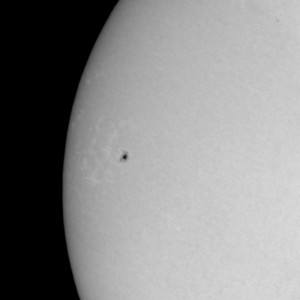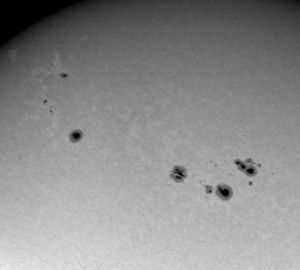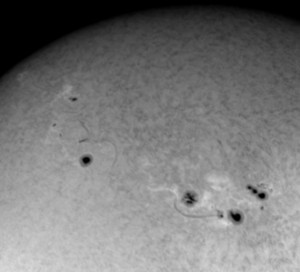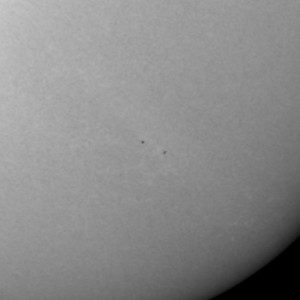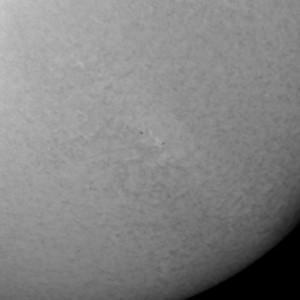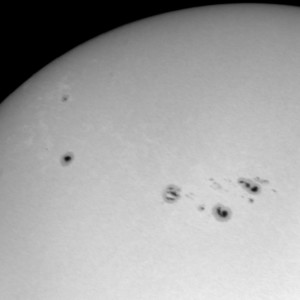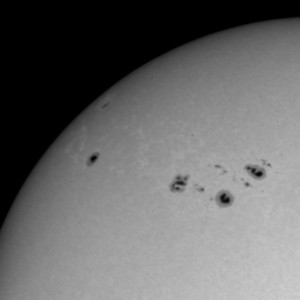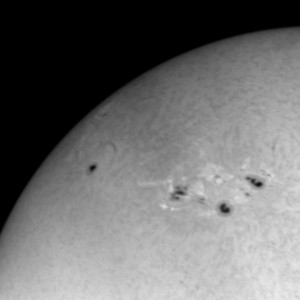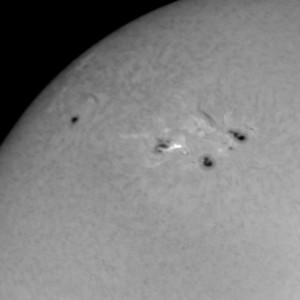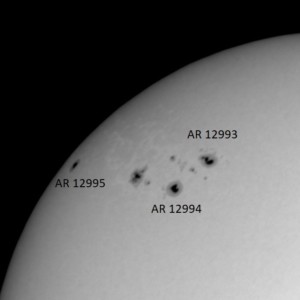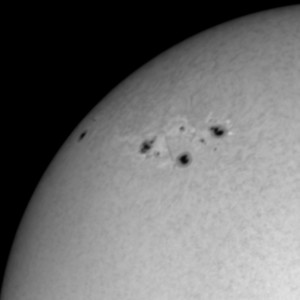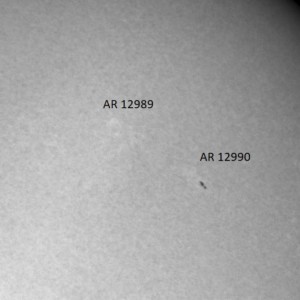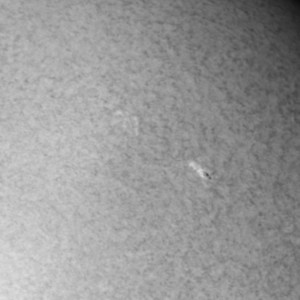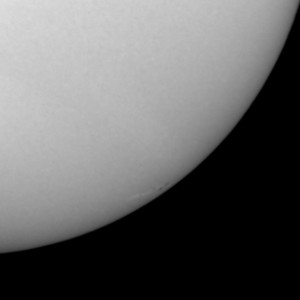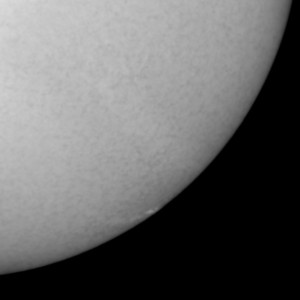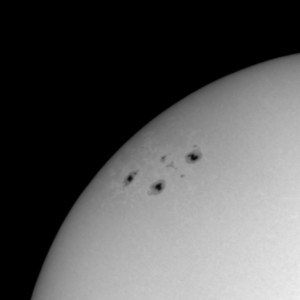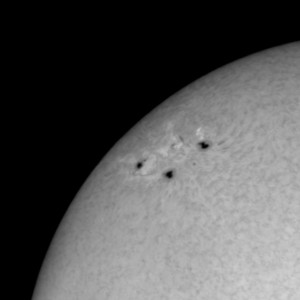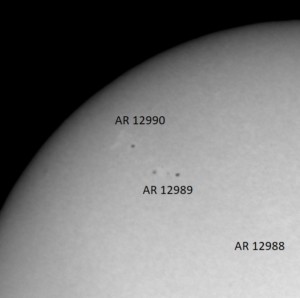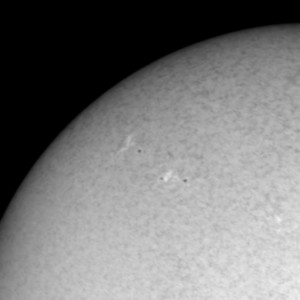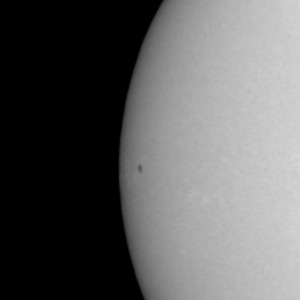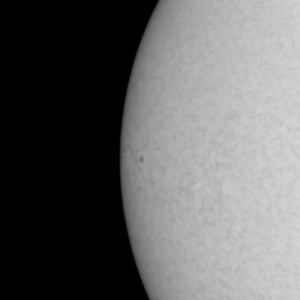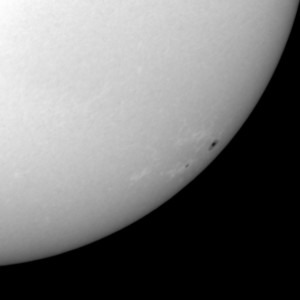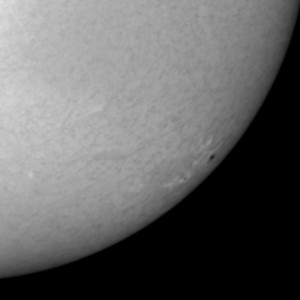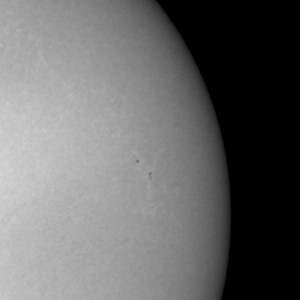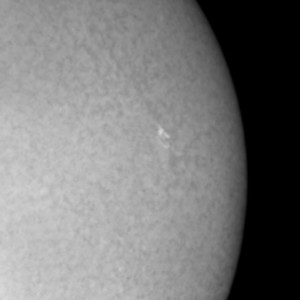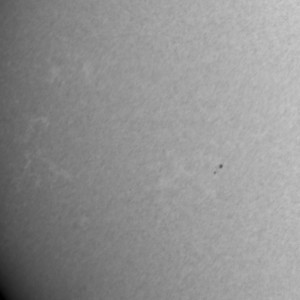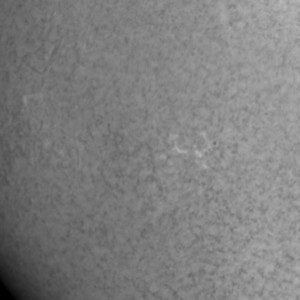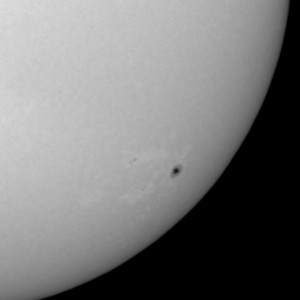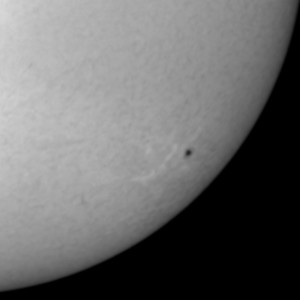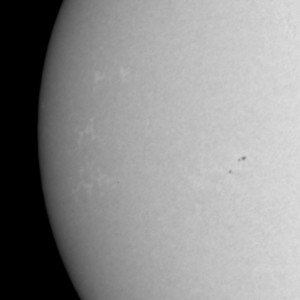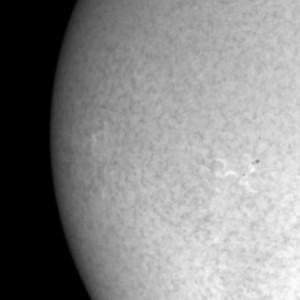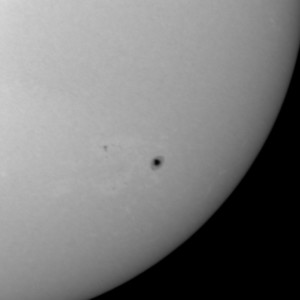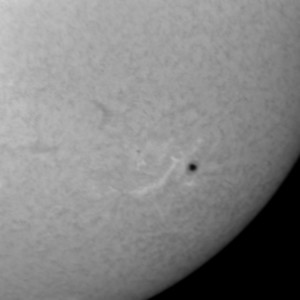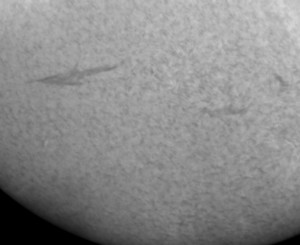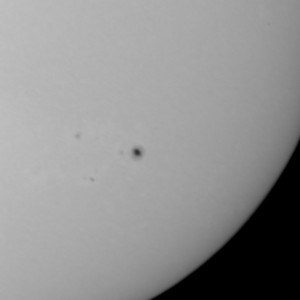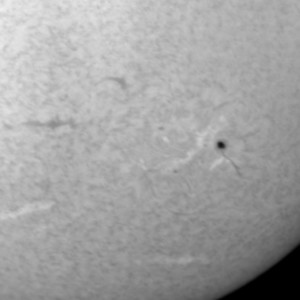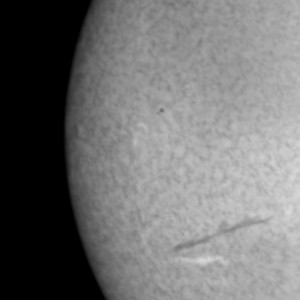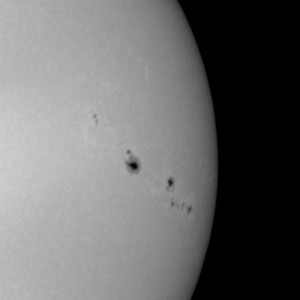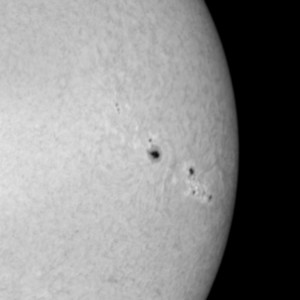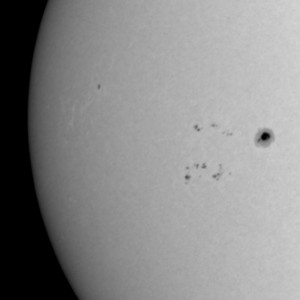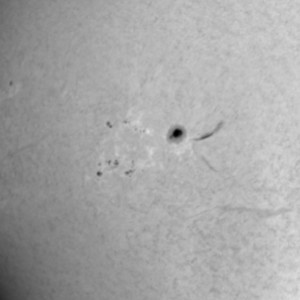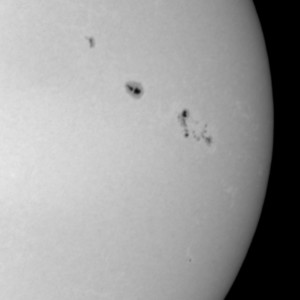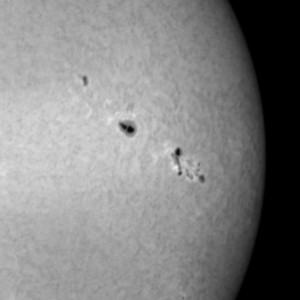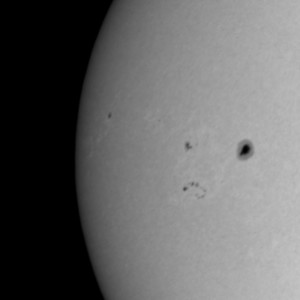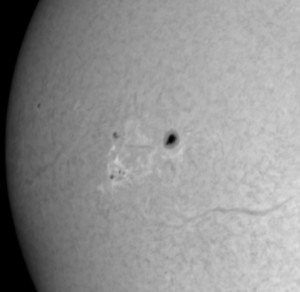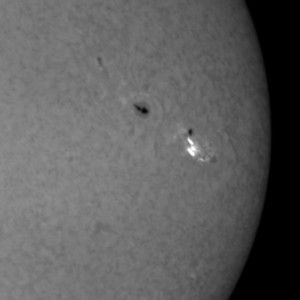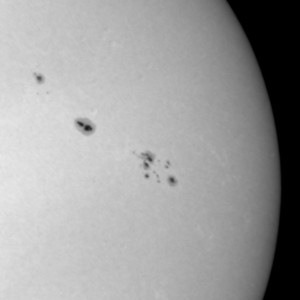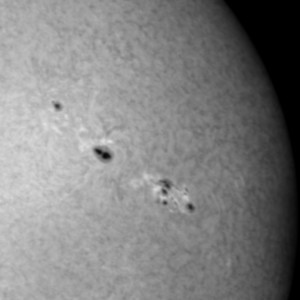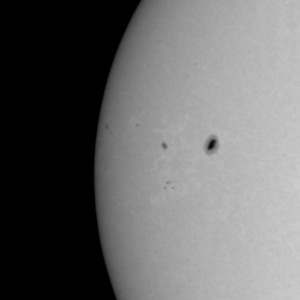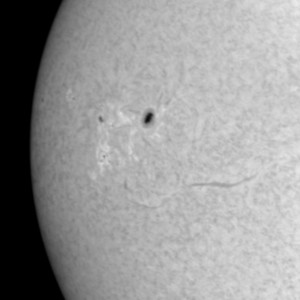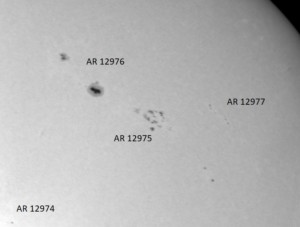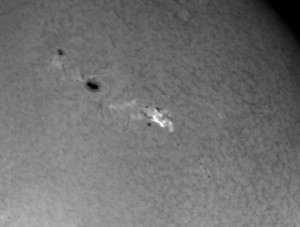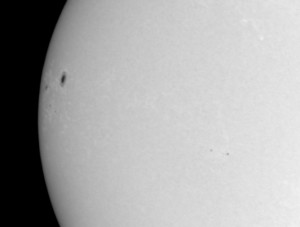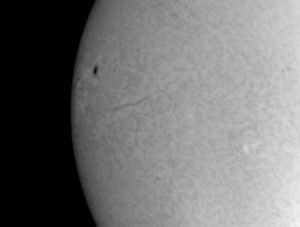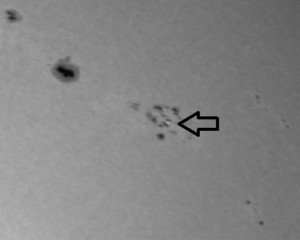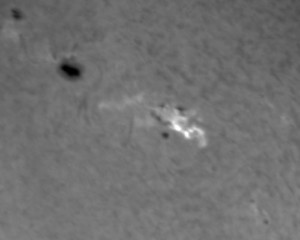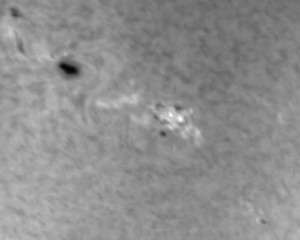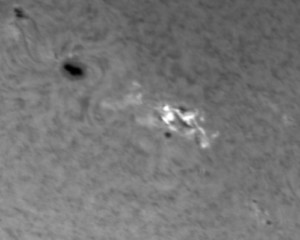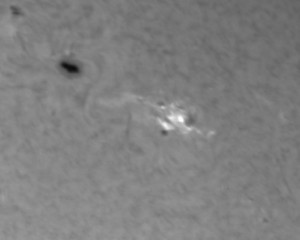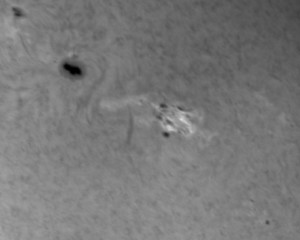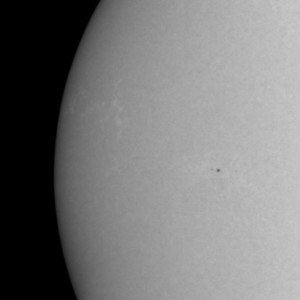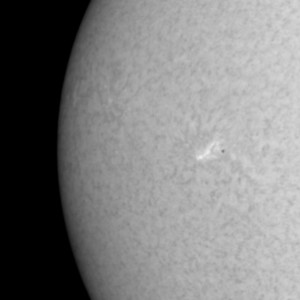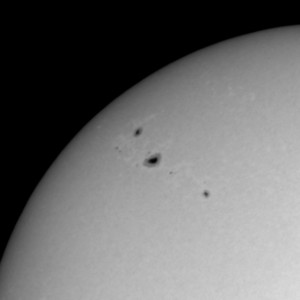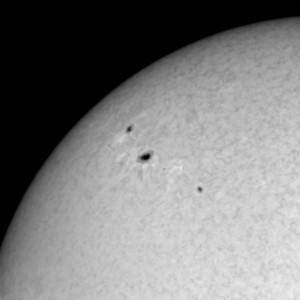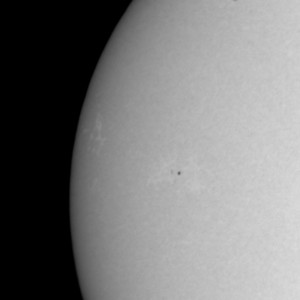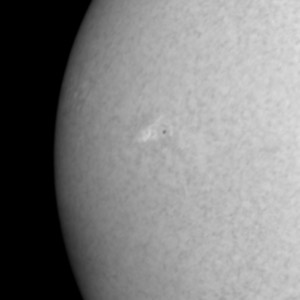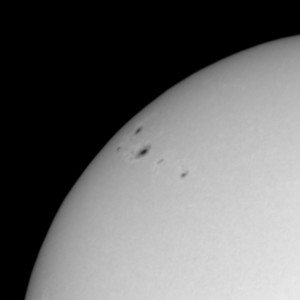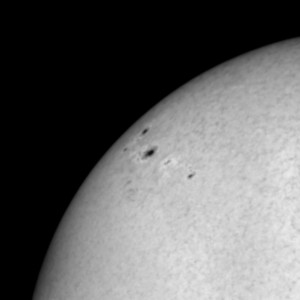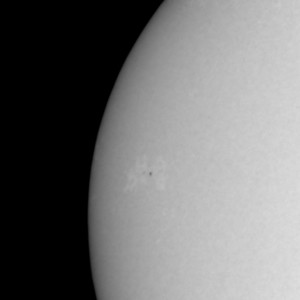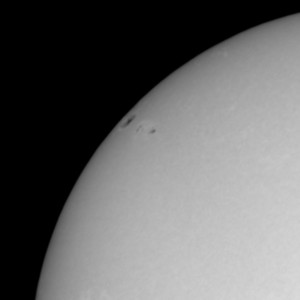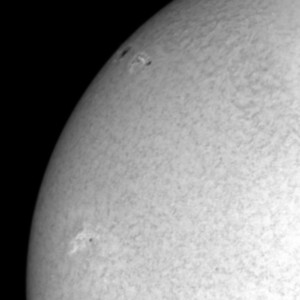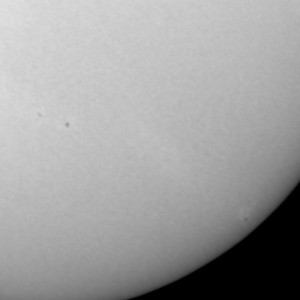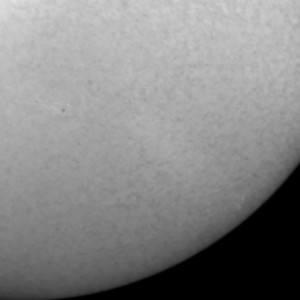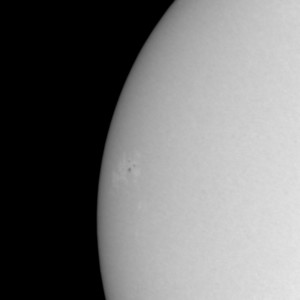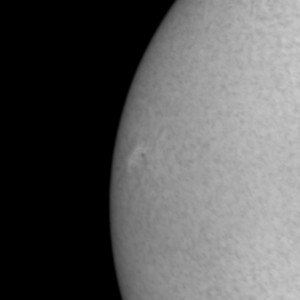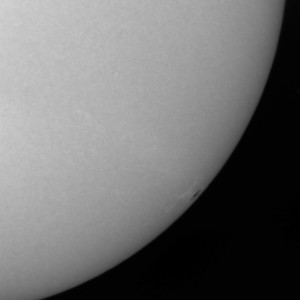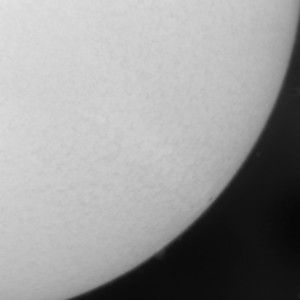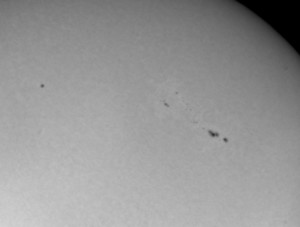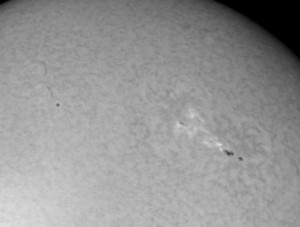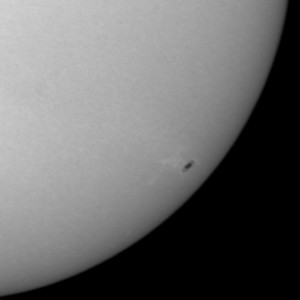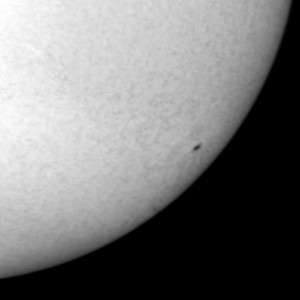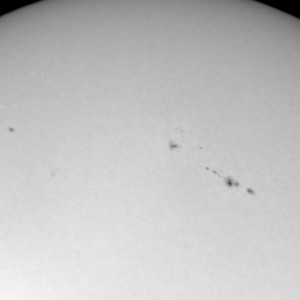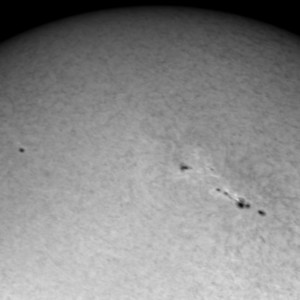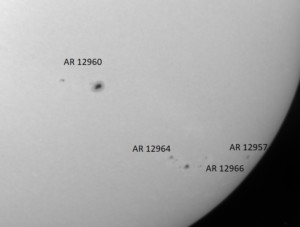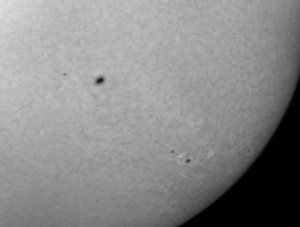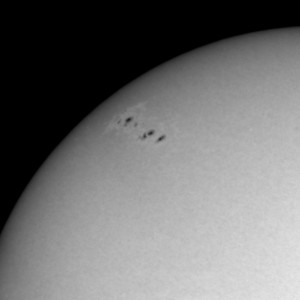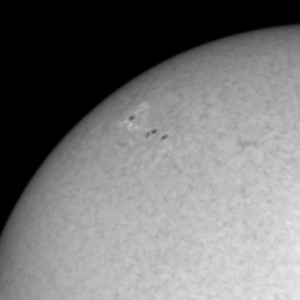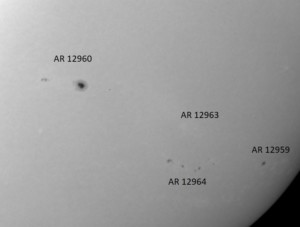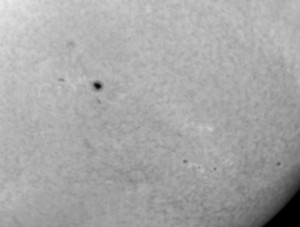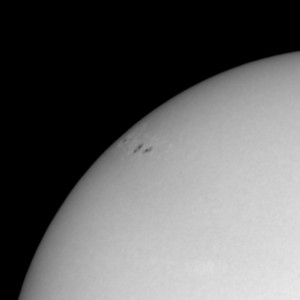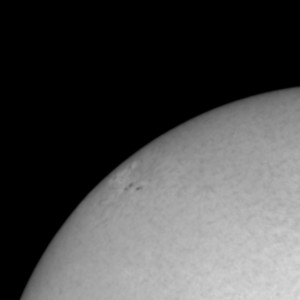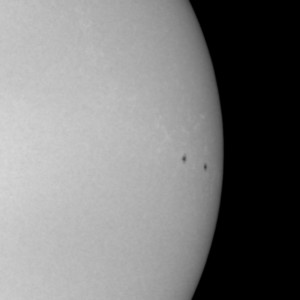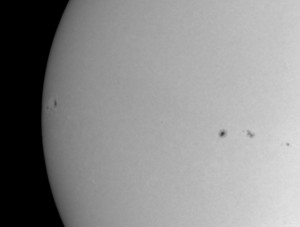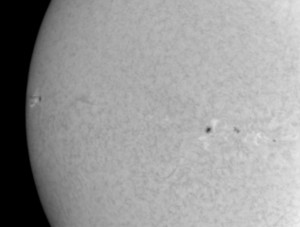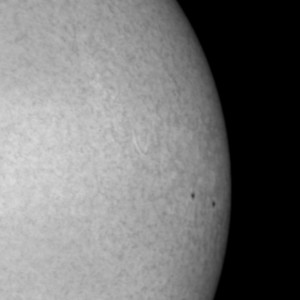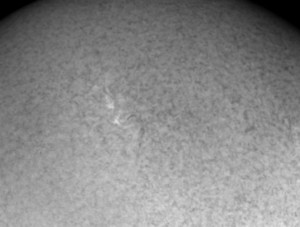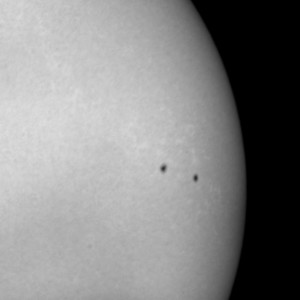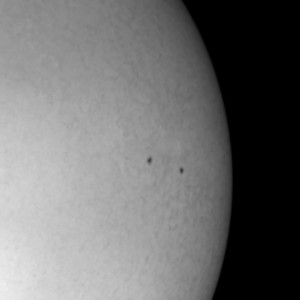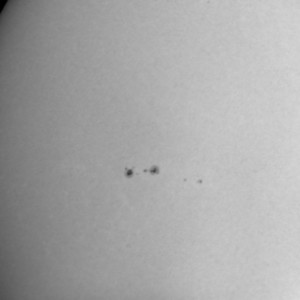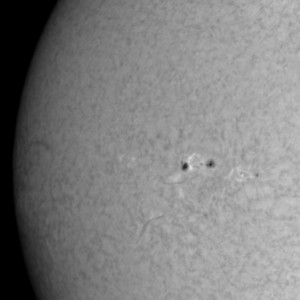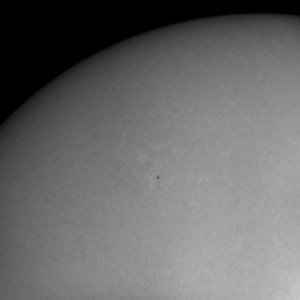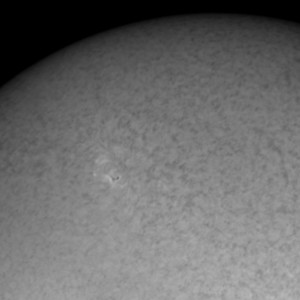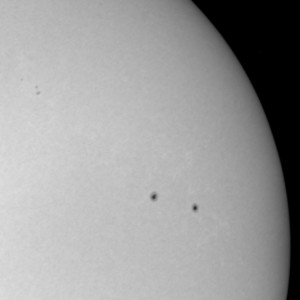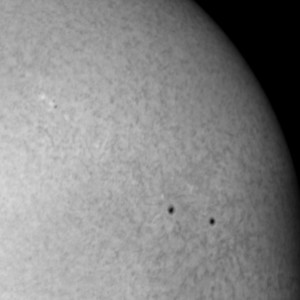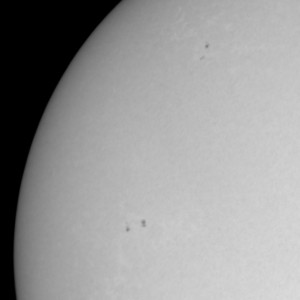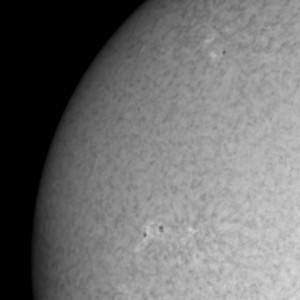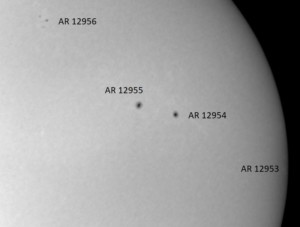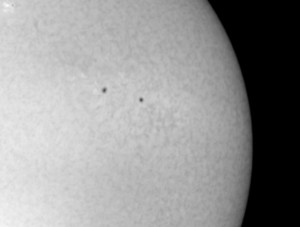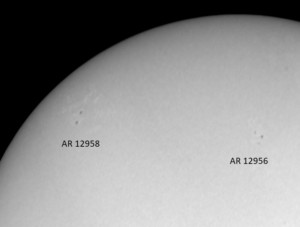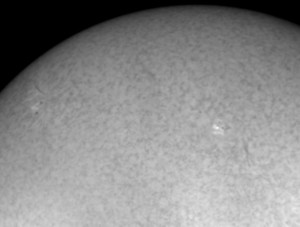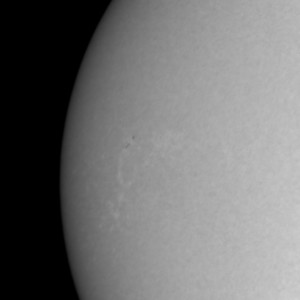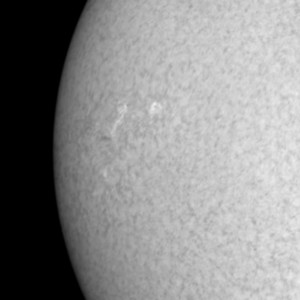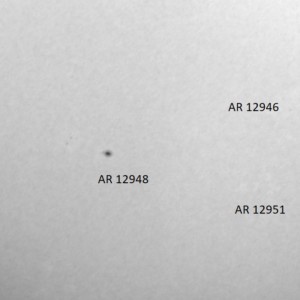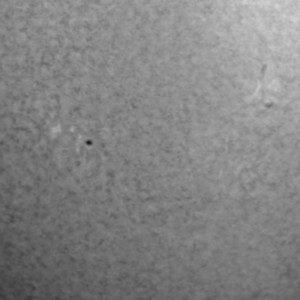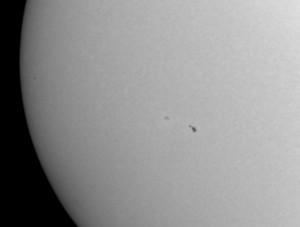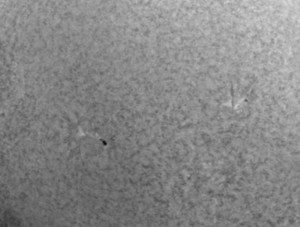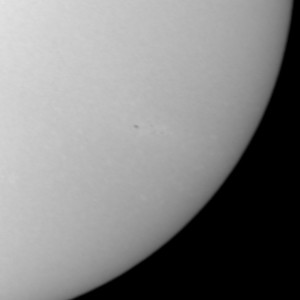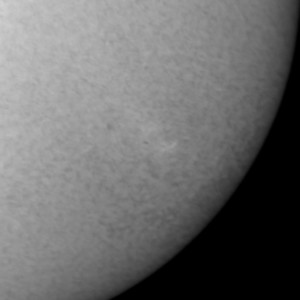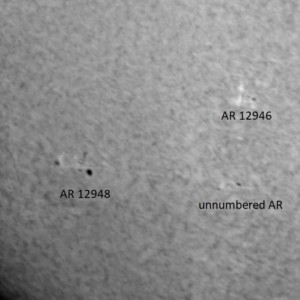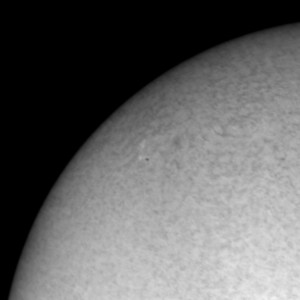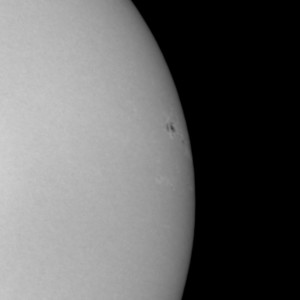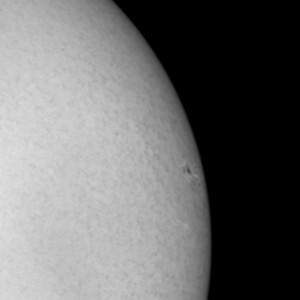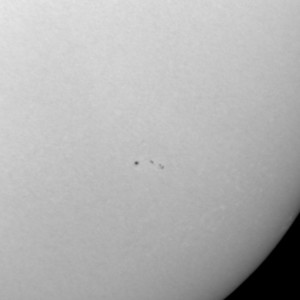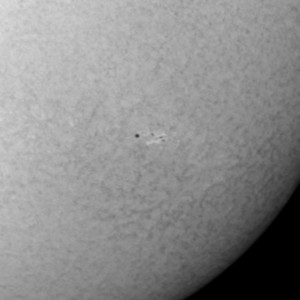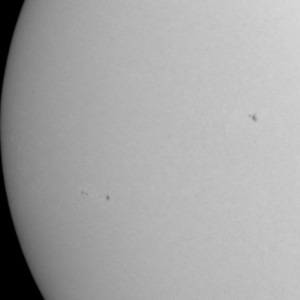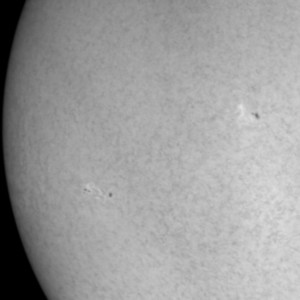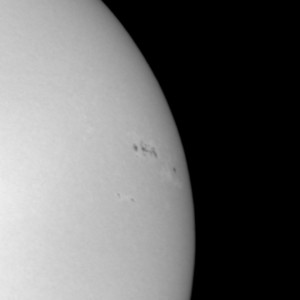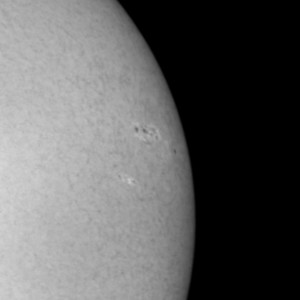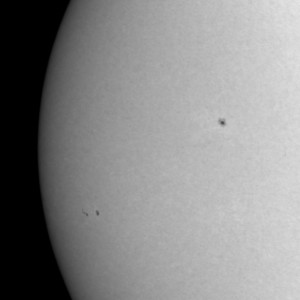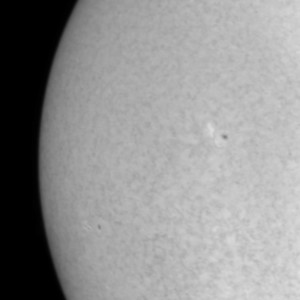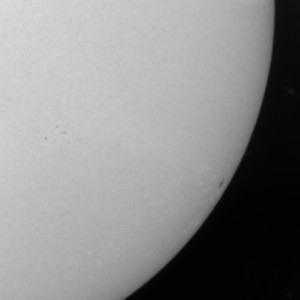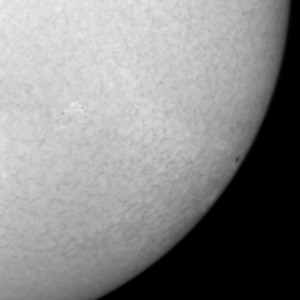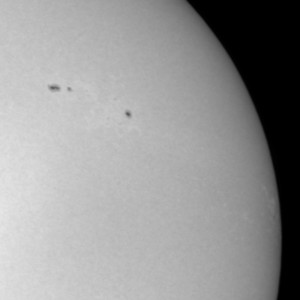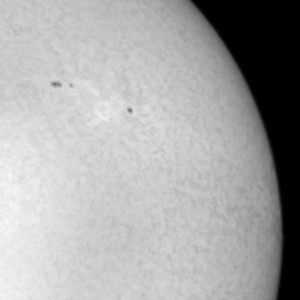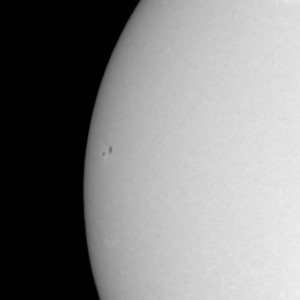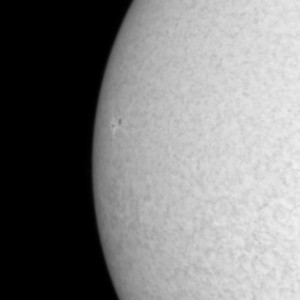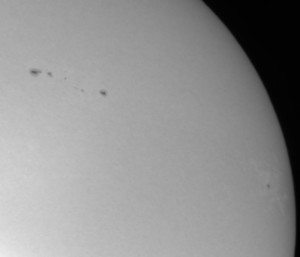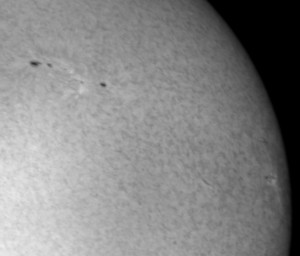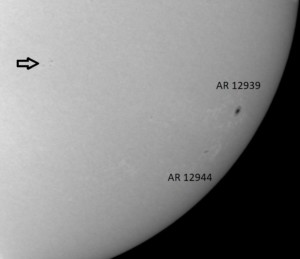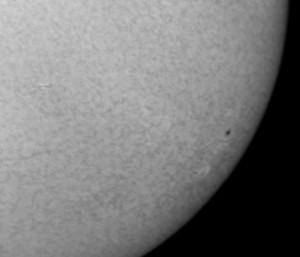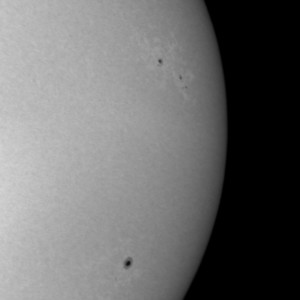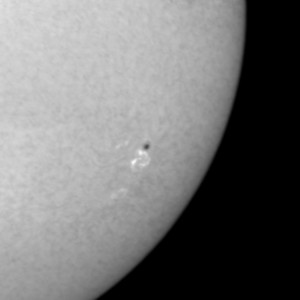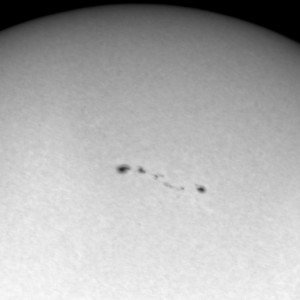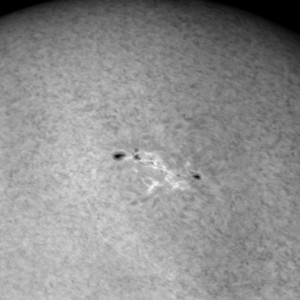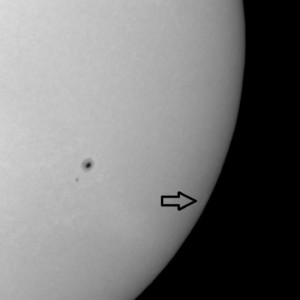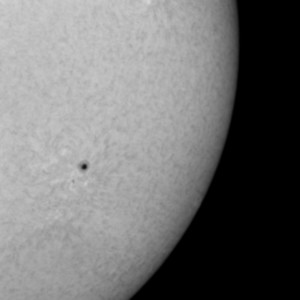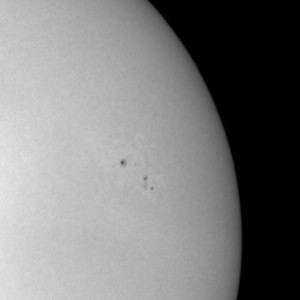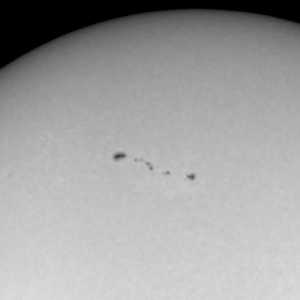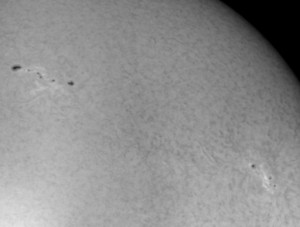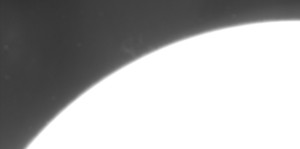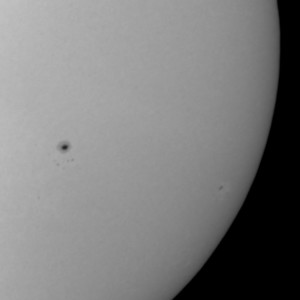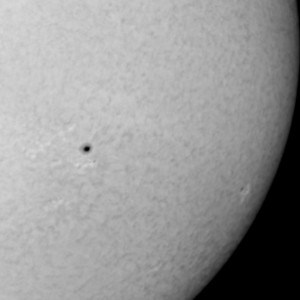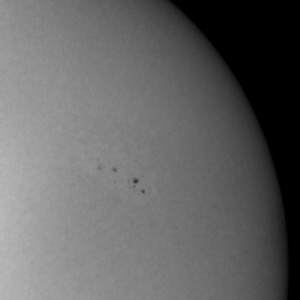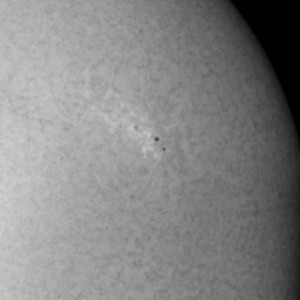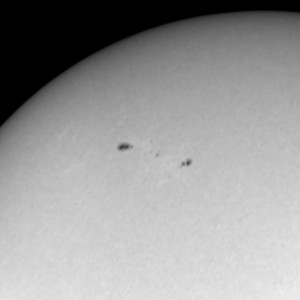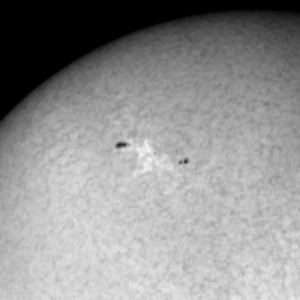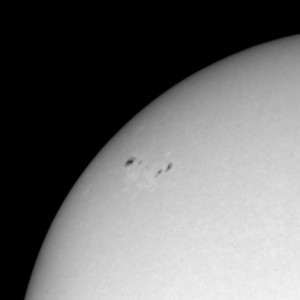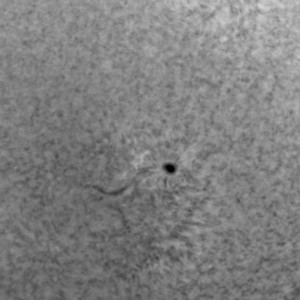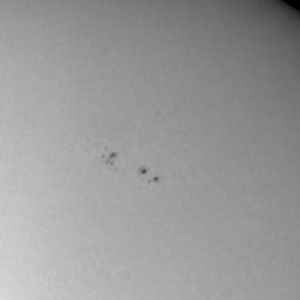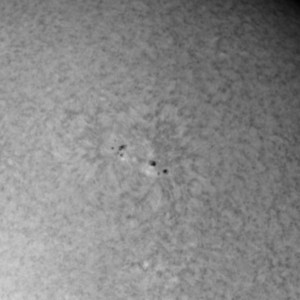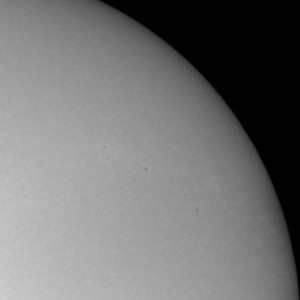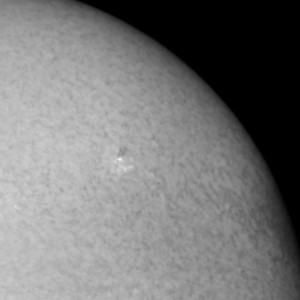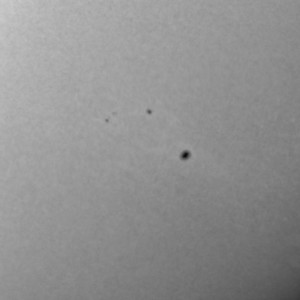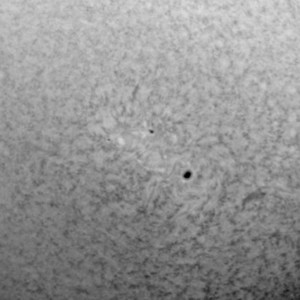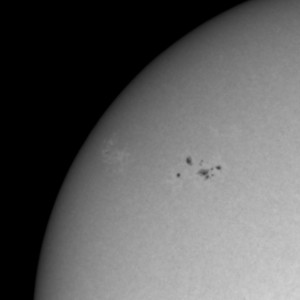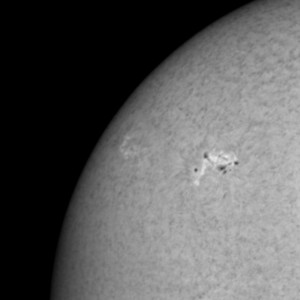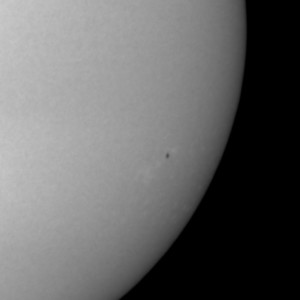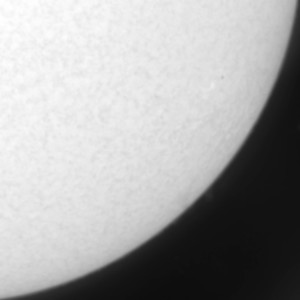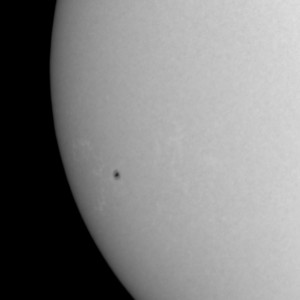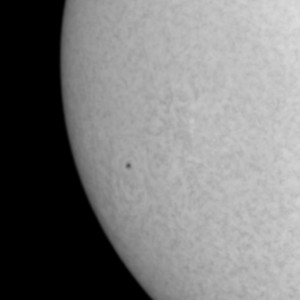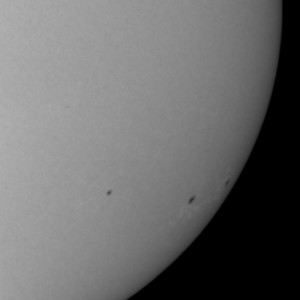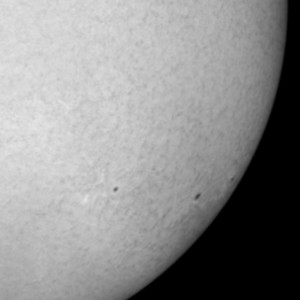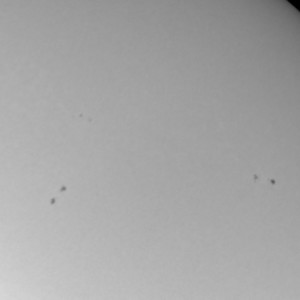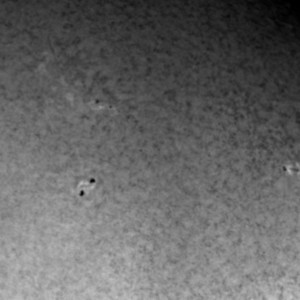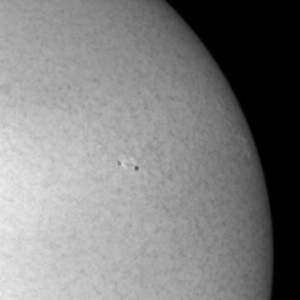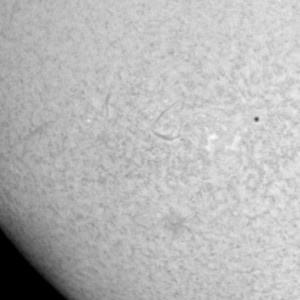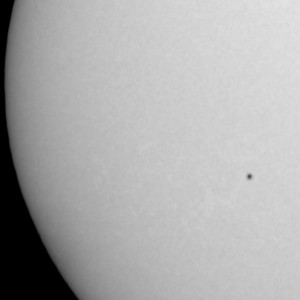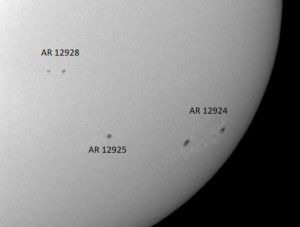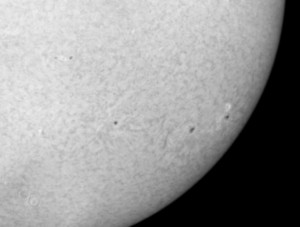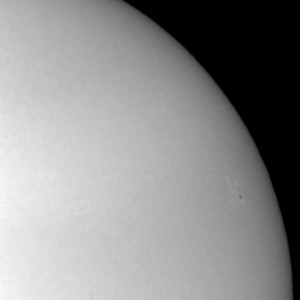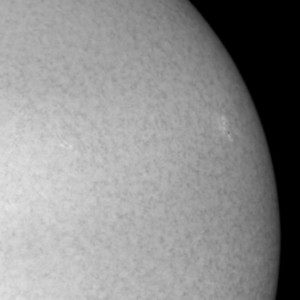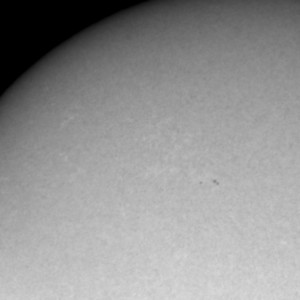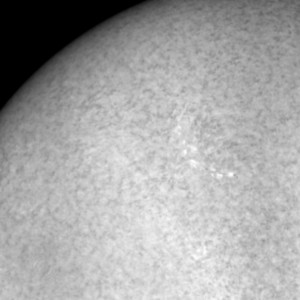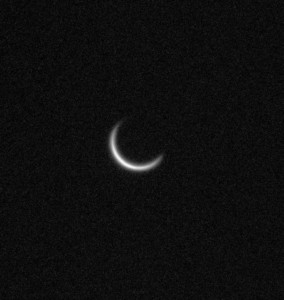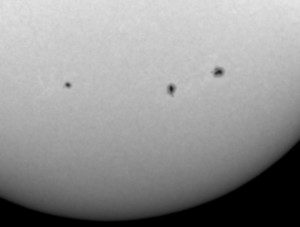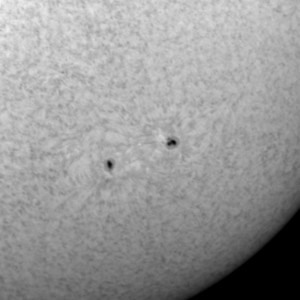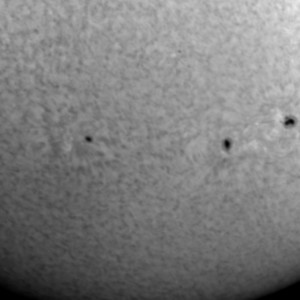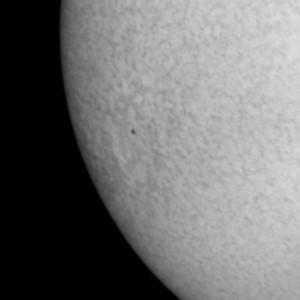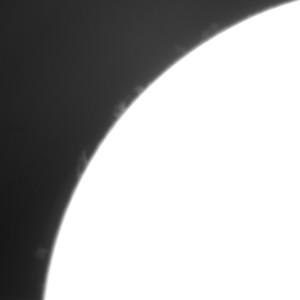Solar Images from 2022
Note: All images on this website © 2018-2023 by Brian Cudnik and Prairie View A&M Physics. All rights reserved.
Observations are happening daily, except for Saturday, Sunday, and holiday periods; and are governed by duty schedule, weather, and solar activity. When the Sun has very low activity (spotless), observations will be limited or non-existent. Whenever the Sun becomes active again, the observing program will become active as well, weather permitting.
One can monitor the Sun via several websites that provide real-time images of the Sun. The website, https://www.solarmonitor.org/, has such images in six different channels. The numbers are the NOAA designations for active regions (with the “1” at the start of the designation removed for convenience). Another website with up-t0-date information on solar activity and other goings-on in the skies is www.spaceweather.com. Additional information about the Sun’s current activity can be obtained from https://www.swpc.noaa.gov/, and real-time full-disk H-alpha images from observatories around the world can be viewed at http://halpha.nso.edu/.
A typical observing run may last from one to four hours, depending on seeing considerations, weather, and other work responsibilities, but will include active region monitoring of available active regions and the collection of frames for high-resolution solar mosaics in H-alpha. Each session includes at least one mosaic, which is a series of images made of all parts of the Sun’s disk that can later be stitched together to form a whole-disk image. At the very least, this ensures that all visible features such as prominences, filaments, and active regions (sunspot groups) are all captured in image form at least once per session. Usually observations are carried out in the late morning hours, but an additional session may occur in the mid-afternoon hours and it will include its own mosaic. If a sunspot group is expected to be active, then it becomes a main focus for observation for extended periods of time.
The solar images are recorded through a Meade 16-inch f/8 Cassegrain telescope equipped with a 0.3 Å Hydrogen-alpha filter and an SBIG STT-8300 CCD camera. The aperture of the scope is stopped to 4-7/8 inch by an energy-rejection filter, which renders the system an f/26. A neutral density filter is added to bring the sunlight intensity down by 90%. Each image is automatically dark-subtracted as it is saved and each exposure is 0.1 second long. Flat field images are taken at periodic intervals throughout the observing session and are obtained by training the telescope to focus near the center of the Sun’s disk. Five images are then taken while dithering the frame 1′ to 5′ N,S,E, and W. The idea is to try to get images that are slightly blurred (either due to seeing or scope motion) and off set from each other. A set of 30 bias images (0-second exposures with the dome closed and scope parked) are taken at the end of each observing session.
Select images are processed for further study and display. A program called MaxIM DL is used to do basic calibration (bias-subtraction and flat field correction), and the levels are adjusted for optimum display contrast. Choice images are then selected for online display. All of the images are archived in their raw FITS format, sorted by date, and backed up twice. At a later time we can mass process these and make them available for scientific use. Inquiries can be made of Brian Cudnik, at bmcudnik@pvamu.edu, or Premkumar Saganti, at pbsaganti@pvamu.edu.]
December 17, 2022
The Sun has become quieter as AR 13165 begins to rotate over the solar horizon. Only occasional C-flares are occurring as the remainder of the regions are quiet, including AR 13163, which has the potential to unleash some large flares. There was an M1 event at 19:50 UT from AR 13169, which is growing. This occurred prior to the opening of this afternoon session.
Each of the below images are 0.5 second exposures. The left column of the table contains red continuum images; the right column includes the H-alpha images. The images of AR 13160 and 13167 (top row) each are 7.8’x7.8′; the images of the multiple AR’s listed on the red continuum image are each 7.8’x11.4′.
Solar activity is likely to be moderate through at least 19 December, with a slight chance for an X-flare through 18 December due to the ongoing flare potential of of AR 13165. After this interval, low solar activity was expected through 21 December, with a chance of M-class flares and a slight chance of X-class flares.
December 16, 2022
Solar activity remains high as AR 13165 continues to produce frequent M-class flare, ten since 22:00 UT yesterday, 15 December. The flare that peaked at 22:40 UT was an M6 and the others were M1 to M4. AR 16163 looks like a potential source of big flares, but it has not been producing anything more than optical subflares.
Weather was not favorable for imaging today as a deck of altocumulus moved in ahead of schedule. Due to the excellent seeing absent of the clouds, and the ongoing elevated activity of the Sun, imaging took place through moving cloud breaks. Each of the below images was cropped to 7.8’x7.8′, with celestial north up, west right. The two red continuum images (left most column below) show artifacts due to the fact that no continuum flats were taken; the later H-alpha flats were used, and even these left faint cloud markings on the image. The two continuum images were 0.1 second exposures; the rest were 0.5 second exposures
Solar activity is expected to be moderate through at least 18 December, with a good chance of more M-flares and a slight chance of X-flares, mainly from AR 13165.
December 15, 2022
The Sun continues to be very active these days, with nine M-class flares yesterday (and 7 more today, as of 19:45 UT). We observed a double-peaked M-class flare from AR 13165; the first peak, an M1.1, was at 16:44, the second, an M2.0, was at 16:56. All of the M-flares came from AR 13165, including the largest one, an M6.3/2B at 14:42 UT on 14 December. AR 13165 also produced a number of C-class flares, as did AR 16163.
Each image was taken at the time indicated, and are cropped to 7.8’ squared on the sky, except where indicated otherwise. The Red Continuum images (top row) were each 0.1 second exposures; the H-alpha images (bottom row) were each 0.5 second exposures. Celestial north is up, west is right in each.
Solar activity is expected to be moderate through at least 17 December, with a good chance of more M-flares and a slight chance of X-flares.
December 14, 2022
Solar observations resumed after several days of inclement weather; the skies cleared at midday today allowing for resumption of observations with good seeing.
Solar activity became moderate in level as AR 13165 recently emerged and has grown rapidly. It produced an M2.4/1N event at 7:40 UT on 14 December. Regular flaring continues today. There is an additional 9 spotted regions visible on the Sun: AR 13167 is growing, and the remaining regions are either stable or in decline. AR 13153, watched closely last week, is now rotating over the western solar limb. It produced two M1 flares earlier, each with an associated Coronal Mass Ejection.
Each image was taken at the time indicated, and are cropped to 7.8’ squared on the sky, except where indicated otherwise. The Red Continuum images (top row) were each 0.5 second exposures; the H-alpha images (bottom row) were each 0.5 second exposures. Celestial north is up, west is right in each.
Solar activity is expected to be low through at least 16 December, with a chance for M-class flares.
December 9, 2022
As has been the case all week, a cloudy morning transitions into a partly to mostly sunny afternoon, with haze and warmth and excellent seeing. There are now ten regions on the visible disk but two of them have dissipated to spotless plages. Most of the regions are either stable or in decay, including the intermediate spots of 13153. There was some growth in AR 13157. Another region, soon to be called AR 13163, has produced a number of C-class flares today, from locations just beyond the SE limb. AR 13162 produced one of these flares.
The images are presented of eight of the ten regions currently visible. The left column of the below table of images are the red continuum images; the right column are the H-alpha images. Each image is cropped to 7.8′ square and has celestial north up, west right.
Solar activity is expected to remain low through at least 11 Dec, with a slight chance of M-class flares.
December 8, 2022
The sky transitioned from mostly cloudy to mostly sunny by early afternoon with excellent seeing. The Sun is now adorned with nine spotted active regions, but most of these have been inactive.
AR 13157 is the only region so far today (with the possible exception of 13152) that has produced any flares, and these are few/far between. It has experienced some minor growth. AR 13161 emerged in the trailing regions of AR 13156, the former is its own distinct active region. All of the regions, except for 13157, are either stable or in decay.
The images are presented of each of the nine regions currently visible. The left column of the below table of images are the red continuum images; the right column are the H-alpha images. Each image is cropped to 7.8′ square and has celestial north up, west right.
Solar activity is expected to remain low through at least 10 Dec, with a chance of M-class flares and a slight chance of X-class flares remaining in the forecast picture.
December 7, 2022
NOTE: Tonight, the Full Moon occults (covers up) Mars for much of North America. Check out www.spaceweather.com for more information and times.
Skies were mainly clear early on and stayed so much of the day, so an earlier session was had. Solar activity remains low, in spite of the complex-looking regions currently visible on the Sun’s disk. AR 13157 has been the source of all the flares so far today (through 18:10 UT): a c1.2/SF at 11:11 UT; a C1.2/SF at 12:07 UT; a C5.8/SF at 13:04 UT (the largest since the M-flare back on 3 December); a C1.1 at 15:23 UT; a c1.5/SF at 16:34 and 16:40 UT (we observed parts of this one), and a c1.3 / SF at 17:59 UT.
All the regions visible on the solar disk were all stable or in slight decay, including two more spot groups have rotated into view in the solar northern hemisphere.
Each of the seven visible active regions is depicted in red continuum (top row) and H-alpha (bottom row) below. Seeing was excellent for today’s observing sessions. The UTC of each image is indicated in the image or below each image, and the region number is indicated either within the image itself or below the image, in caption form. Each of the images covers 7.8’x11.4′ of sky, except for the two of AR 13153, each of which measure 7.8’x7.8′ on the sky; celestial north is up, west is right. The exposure times of each was 0.5 seconds.
Solar activity is expected to be low, with a chance for M-class flares and a slight chance of X-class flares, through at least 9 December 2022.
December 6, 2022
Clouds began to break up midday and stayed partly to mostly cloudy the remainder of the day. This allowed for more observations but not as many as yesterday due to increased overall cloud cover.
Solar activity remains low with the first C-level event occurring as of this writing (C1.2 at 21:47 UT from AR 13157) since 20:55 UT on 5 December. All the regions visible on the solar disk were all stable or in slight decay, except for AR 13158, which grew slightly. Two more spot groups have rotated into view in the solar northern hemisphere and have yet to receive designations.
Each of the seven visible active regions is depicted in red continuum (top row) and H-alpha (bottom row) below. Seeing was excellent for today’s observing sessions. The UTC of each image is indicated below each image, and the region number is indicated either within the image itself or below the image, in caption form. Each of the images covers 7.8’x11.4′ of sky, except for the two of AR 13153, each of which measure 7.8’x7.8′ on the sky; celestial north is up, west is right. The exposure times of each was 0.5 seconds.
Solar activity is expected to be low with C-class flare activity, with a chance for M-class flares and a slight chance of X-class flares, through at least 8 December 2022.
December 5, 2022
Clouds began to break up midday and stayed partly cloudy for the remainder of the day, which allowed us to resume observations.
Despite some impressive looking sunspot groups, there had been only low-level C-class events on the sun today. AR’s 13153 and 13158 produced nearly all of these. The last M-class flare so far was one that occurred at 17:41 UT on 3 December, an M1.2 event. All has been quiet since then.
Each of the five visible active regions is depicted in red continuum (top row) and H-alpha (bottom row) below. Seeing was excellent for today’s observing sessions. The UTC of each image is indicated on the image, and the region number is indicated either within the image itself or below the image, in caption form. Each of the images covers 7.8’x11.4′ of sky. The exposure times of each was 0.5 seconds.
Solar activity is expected to be low with C-class flare activity, with a slight chance for M-flares, through at least 7 December 2022.
December 1, 2022
The day started out clear and sunny and cold, but a deck of stratocumulus clouds was moving steadily toward the northeast from the west and southwest. This was low in the western and southwestern skies at the time of the observing session started. The clouds moved in later that morning. The seeing was not too good, fair at best. Two large active regions have come into view along the solar eastern limb. The larger of the two, on the east southeastern limb, was designated AR 13153, the one on the east northeastern limb is AR 13156.
AR 13152, which had been decaying the last several days, produced an M1.0/1N flare at 7:21 UT (overnight local time). It had been quiet up to that point, and continued to be quiet thereafter. The region due south of it, AR 13154, continues to grow slowly as it rotates toward the western disk.
Each of the four visible active regions is depicted in H-alpha below, with only the region 13152 being displayed in red continuum. The rather poor seeing resulted in rather poor continuum images, so only one of these is displayed. Each of the images, except for the AR 13153 image, covers 7.8’x7.8′ of sky; the latter covers 7.8’x11.4′ to include a filament. The exposure times of each was 0.5 seconds.
Solar activity is expected to be very low, with a chance of C-class flares, through at least 3 December 2022.
November 30, 2022
This morning’s cold front left the atmosphere unsteady, leading to rather poor seeing. Hence the images are not as clear as they usually are.
Solar activity remains low. AR 13151 continues to generate C-class flares and display some interesting limb activity. The region itself had rotated out of view. AR 13152 remains stable and another spot had appeared (it was visible as a tiny pore yesterday) and has gotten a bit larger and darker since yesterday, but has not received an AR designation number. The first image depicts some of the limb activity from AR 13151. The second image is a 0.1 second exposure continuum of AR 13152; the third is the H-alpha view of the same region. The H-alpha images used 0.5 second exposures. Each image covers 7.8’x7.8′ of the sky.
Solar activity is expected to be very low with a chance for C-class flares through at least 2 December.
November 29, 2022
Clouds gave way to a haze late afternoon when today’s images were recorded.
Solar activity remains low. There had been some C-class flares from departing region AR 13151, but the region is not visible otherwise. Thus, only one spot group is visible on the Sun currently. AR 13151 is portrayed in the first image near the maximum output of a “SN” flare (bright spot on edge). There is also surge activity from several additional small flares observed from this region. The second image is a continuum of AR 13152; the third is the H-alpha view of the same region. Each image is a one-second exposure, except for the red continuum image, a 0.5 second exposure. Each image measures 7.8’x7.8′ on the sky.
Solar activity is expected to be very low with a chance for C-class flares through 1 December.
November 28, 2022
Solar activity has been quiet since the last observation session eleven days ago. There are only three tiny sunspot groups on the visible disk today: the one near the solar CM is decaying and the two others are rotating out of view. Each of the below images were 0.5 second exposures. The first column contains red continuum images; the second column has H-alpha images. Each image measures 7.8’x7.8′ on the sky.
Solar activity is expected to be very low with a chance for C-class flares through at least 30 November.
November 17, 2022
Observations were made through a variable window of clear skies, which lasted less than one hour. Further imaging was done through the clouds. The white light/continuum session was done through clear skies, but the clouds varied for the H-alpha observations. AR 13147, 13148, 13145, and 13140 each produced C-flares today, the largest of which was a C6.1 at 9:28 UT.
The complex of active regions 13140/14141/13145 have mostly rotated over the limb, with only some plage and AR prominences visible in H-alpha (first image). AR 13147 is the large spot first seen yesterday, it is accompanied by AR 13148, a much smaller spot. AR 13146 has decayed to plage, and another rather bright plage area (AR 13149) has rotated into view along the east-northeast limb (second image below). This was the source of a C2.1/SF which occurred at 16:38 UT. The bottom row depicts AR 13147 and 13148 in continuum light (left) and H-alpha light (right). Each of the images cover 7.8’x7.8′ on the sky and are 0.5 second exposures.
Solar activity is expected to be low, with a chance of M-class flares through 18 November as AR 13145 rotates out of view; there is only a chance of C-flares on 19 November.
November 16, 2022
Clouds were very slow to clear out today; in fact much of the observations were done though a persistent veil of thin mid-level clouds, which actually acted more like a neutral density filter than clouds. They gradually thinned throughout the session, allowing a brief window of truly clear skies in the last 20 minutes or so of the session. The red continuum filtered images were obtained through the clouds; the H-alpha images displayed below were obtained through generally clear skies.
Since last observing session, AR 13140 grew significantly, with a new spot pair emerging below the existing old single spot. The 11 November images show the early stages of this emergence in the form of two spots that made a triangle with the pre-existing spot. The region became magnetically complex, with the potential to unleash X-class flares. This had not happened, only two M-flares occurred since the last session: an M1.1 flare at 0:18 UT on 12 November, and an M1.0 flare at 2:51 UT on 15 November. There were frequent C-class flares. The X-ray level had been above C-level since 11:05 UT 14 November, and frequent C-class flares have been happening.
The active region complex AR 13140/13141/13145 is rotating out of view. A small pair of spots is visible on the solar CM; this is AR 13146, which shows signs of decay. A large single spot has rotated into view in the southern hemisphere and has not yet been numbered, although it will likely be dubbed AR 13147.
The left column below are the red continuum images; the right column are the H-alpha images. Each red continuum image was a 0.5 second exposure; each H-alpha image was a 1.0 second exposure. Each image covers 7.8’x7.8′ on the sky.
Solar activity is expected to be low for the next three days with a chance of M-class flares on November 16 and a slight chance of M-class flares from November 17-18.
November 11, 2022
There was a burst of activity earlier today with a lot of C-flares and two M1 flares coming from AR 13141. Things had quieted down just in time for the morning observing session. Both this region and AR 13140 developed new spots in growth, but AR 13145 decayed since yesterday. All the other numbered regions were spotless.
The left column below are the red continuum images; the right column are the H-alpha images. Each image was a 0.5 second exposure. The AR 13141 images are each 7.8’x7.8′ and the plage images are each 7.8’x10.4′.
Solar activity is expected to be low for the next three days with a chance of M-class flares and a slight chance of X-class flares, each from AR 13141.
November 10, 2022
Solar activity continues to be low overall, with frequent low-level C-class flares today. The largest of these, over the last 24 hours, was a C4/SF flare at 20:05 UT on 9 November. We captured one of the C-flares today, a C1.4/SN that peaked at 21:41 UT.
AR 13141 (below) and 13140 (upper right) are the two largest spots/spot groups on the solar disk. The small cluster of spots left of image center, and above the trailing part of 13141 is AR 13145. The other visible active regions, AR 13137, 13143 and 14144 are mostly spotless, except for 13144 which has a single, tiny spot at its location.
Each of the images below covers 7.8’x7.8′ on the sky and are 0.5 second exposures. The first is in red continuum light, the other two are taken in H-alpha centerline light.
Solar activity is expected to remain low with a slight chance of M-class flares through at least 12 November.
November 9, 2022
Solar activity continues to be low overall, but some activity is happening in both AR 13140 and 13141 (pictured below). Each have produced many B- and C-class flares, the largest of which was a C4.3/SF that occurred at 20:05 today.
We imaged the C1.2/SF event from AR 13141. This event peaked at 18:05 UT. Six images show the changing appearance of this region below. Notice the dark surges or “ink streaks” coming from not only AR 13141 but also from AR 13140. The first image show the regions in red continuum light; the first of the six depict these regions before the flare event, which is documented in the latter five images. Each image measures 7.8’x7.8′ on the sky.
Above is the red continuum image, taken at 16:52:52 UT, showing AR 13140 (top) and 13141 (bottom). The below six images, taken at the times indicated, depict the changing appearance of these two regions, in H-alpha. The bright spots in the third and fourth images are the flares themselves.
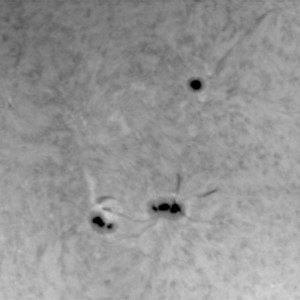 17:31:03 UT 17:31:03 UT |
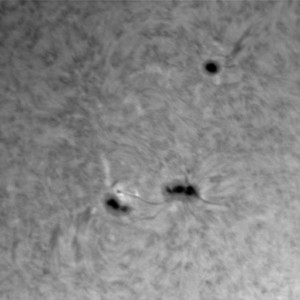 17:57:51 UT 17:57:51 UT |
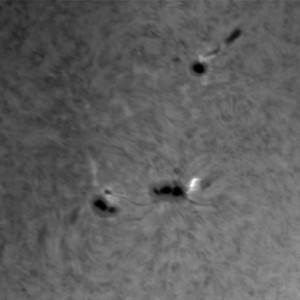 18:03:44 UT 18:03:44 UT |
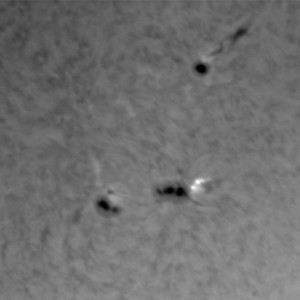 18:05:29 UT 18:05:29 UT |
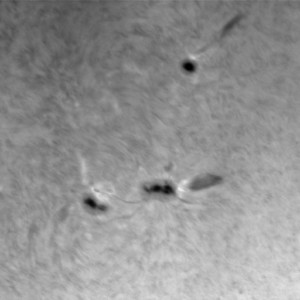 18:09:42 UT 18:09:42 UT |
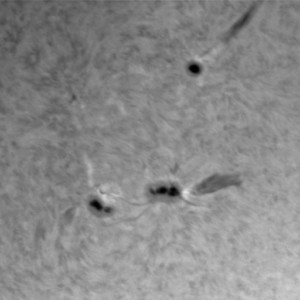 18:13:08 UT. 18:13:08 UT. |
Solar activity is likely to remain low, with a slight chance of an M-class flare, through at least 11 November.
November 8, 2022
Skies cleared by late morning and remained partly cloudy through early afternoon before clearing then becoming partly cloudy again closer to sunset. The seeing was excellent. The parade of sunspots continues across the northern hemisphere but the southern hemisphere remains nearly spotless. Two regions popped up yesterday but dissipated today. AR 13135 is preparing to rotate out of view carried along by the Sun’s rotation; this is being trailed by spotless plage regions leftover from prior spotted active regions. The complex of active regions 13140 13141, and 13142 are nearing the solar CM, with 13141 remaining the largest and most complex of the visible sunspot groups. AR 13142 is already decaying, containing a third of the number of small spots as yesterday. Today’s activity was low, with only a few low-level C-class flares.
Each image is 7.8′ x 11.4′ and is oriented so that celestial north is up, west is right. The red continuum images are in the left column and the H-alpha images are in the right.
Solar activity is expected to be low, with C-class flares expected and a slight chance of M-class flares through 10 November.
November 7, 2022
Skies cleared by late morning but remained partly cloudy throughout the day. The seeing was very good. The parade of sunspots continues across the northern hemisphere but the southern hemisphere is starting to show two small spot groups. AR 13135 is preparing to rotate out of view carried along by the Sun’s rotation. Following this are plage regions leftover from prior spotted active regions. Toward the northeast limb, three sunspot groups are visible, a small cluster of tiny spots, a large single spot and a pair of single spots with a few attending small spots. AR 13142 is the largest and most magnetically complex active region (sunspot group) visible on the solar disk currently. It produced an M5 flare at 0:11 UT on 7 November.
Each image is 7.8′ x 11.4′ and is oriented so that celestial north is up, west is right. The red continuum images are in the left column and the H-alpha images are in the right. The bright localized areas in some of the images below come from the processing and are not intrinsic to the Sun.
Solar activity is expected to be low, with a slight chance of M-class flares through 9 November.
November 3, 2022
Clouds once again interfered with observing but we were able to capture some images of visible features on the Sun. Things remain quiet with only occasional low-level C-class events from AR’s 13135 and 13137. There is a large spot that is starting to rotate into view. There are currently six spotted active regions visible on the solar disk, all of them quiet and unremarkable.
The top row of images are red continuum images, and the bottom row consists of H-alpha images, each 0.5 second exposure. Each image measures 7.8’x7.8′ on the sky.
Solar activity is expected to be low through at least 5 November.
November 2, 2022
Today was mainly a cloudy day with a sunny break lasting about two hours. During that time, an imaging session was able to be completed, monitoring the continued quiet Sun for various features. There are currently five spotted active regions visible on the solar disk, all of them quiet and unremarkable. Occasional C-class flares have come from AR 13135, but none were observed this session.
The top row of images are red continuum images, and the bottom row consists of H-alpha images, each 0.5 second exposure. Each image measures 7.8’x7.8′ on the sky.
Solar activity is expected to be low through at least 4 November.
October 31, 2022
The Sun continues to lack large sunspot groups as it continues an extended spell of quiet. Only occasional low-level C-class events occurred today, from AR’s 13133 and 13135. No such event was observed in today’s session. AR 13131 and 13135 are the two largest spot groups currently visible; AR 13133 and 13134 have lost their spots, and another region appears to be rotating into view following the AR 13131/13135 pair.
All of the visible spotted active regions are depicted below in both red continuum and H-alpha light. The red continuum images, each 7.8’x7.8′ on the sky, appear in the left column. The H-alpha images, each (7.8′ x 11.4′) corresponding image appear in the right column of the table. The seeing was excellent, despite high clouds passing in front of the Sun from time to time. Each of the below images is a 0.5 second exposure.
Solar activity is likely to be low through at least 2 November 2022.
October 27, 2022
Solar activity remains low. AR 13133 produced two low-level C-flares: a C2.3 at 1:26 UT, and a C2.2 at 1:57 UT, 27 October. AR 13130 has shown some growth since yesterday and was the source of a C1.7 at 1:03 UT, 27 October. The X-ray emission background had stayed relatively level and flat since these trio of small C-flares; it continues to be flat with low amplitude undulations as of 18:30 UT.
The other two visible regions on the solar disk today were all inactive or otherwise unremarkable. AR 13126 is very difficult to see on the western solar limb as it rotates out of view.
All of the visible spotted active regions are depicted below in both red continuum and H-alpha light. The red continuum images, each 0.5 second exposure, appear in the left column. The H-alpha images, each 0.5 second exposures, corresponding image appear in the right column of the table. The seeing was poor this morning but was somewhat improved with the use of H-alpha line center imagery. Each image measures 7.8’x7.8′ on the sky.
Solar activity is expected to be very low, with a slight chance for a C-class flare, through at least 29 October 2022.
October 26, 2022
Solar activity remains low. AR 13133 produced a C3.3 and a C4.9/SF yesterday and a C6.7 today at 12:43 UT. All has been quiet since with only a B8 level enhancement at 19:19 UT (as of 19:44 UT). The other visible regions on the solar disk today were all inactive or otherwise unremarkable. All of the visible spotted active regions are depicted below in both red continuum and H-alpha light. The red continuum images, each 0.1 second exposure, appear in the top row. The H-alpha images, each 0.5 second exposures, corresponding image appears in the bottom row of the table. The seeing was poor this morning but was somewhat improved with the use of H-alpha line center imagery. Each image measures 7.8’x7.8′ on the sky.
Solar activity is expected to be very low through at least 28 October 2022. There is a chance for C-flares from AR’s 13126 and 13133.
October 25, 2022
Overnight local time in North America, there was a partial solar eclipse in Europe, Africa, and parts of Asia, including India. The above partial eclipse image was captured at one of the GONG (Global Oscillation Network Group) solar observatories in Udaipur, India. More images can be viewed at this livescience website.
Solar activity remains low. A new active region, AR 13133, is the source of two flares so far today: a C3.3 event at 15:19 UT (while we were finishing the red continuum imaging), and a C4.9/SF at 19:03 UT (well after our observing session). The other visible regions on the solar disk today were all inactive or otherwise unremarkable. A new region, AR 13132, emerged north of AR 13130; the largest region currently visible on the solar disk is AR 13126, which is about to rotate out of view.
All of the spotted active regions are depicted below in both red continuum and H-alpha light. The red continuum images, each 0.1 second exposure, appear in the top row. The H-alpha images, each 0.5 second exposures, corresponding image appears in the bottom row of the table. The seeing was poor this morning but was somewhat improved with the use of H-alpha line center imagery. Each image measures 7.8’x7.8′ on the sky.
Solar activity is expected to remain low through at least 27 October 2022. AR 13126 is expected to be the main source of flaring activity.
October 21, 2022
Solar activity continues at low levels, but with lots of little C-class flares. Yesterday they were all coming from AR 13122 as it exited the visible solar disk via rotation; today no source region has been assigned to the seven C-flares between 0:00 and 7:20 UT. The two new spot groups that have been developing over the last few days have received designations: NOAA 13126 and 13127. They remain small and unremarkable, but 13127 seems to be growing a bit.
The left images are red continuum images of the indicated active regions, each a 0.1 second exposure. The right column images are 1.0-second exposures of the same regions, but in H-alpha. Each image covers 7.4’x7.4′ on the sky, with celestial north up, west right.
Solar activity is expected to be low, with a chance of C-flares through at least 23 October.
October 19, 2022
Solar activity has been at low levels the last few days, with only modest enhancements of the X-ray levels into the C-range. There was a C3.4 event that peaked today at 17:50 UT but the source of this had not yet been reported. A new active region/cluster of spots has emerged in the solar southern hemisphere near the meridian; this is followed by a smaller pair of tiny spots embedded in a facula field.
The left images are red continuum images of the indicated active regions, each a 0.1 second exposure. The right column images are 1.0-second exposures of the same regions, but in H-alpha. Each image covers 7.4’x7.4′ on the sky, with celestial north up, west right.
Solar activity is expected to be very low, with a chance of C-flares through at least 21 October.
October 18, 2022
Solar activity remains low with a few small spot groups visible on the nearly-blank solar disk. The largest of these is AR 13124 which formed the day after the last session and is about to rotate out of view. It has produced quite a few C1 and subflares today. The other regions are unremarkable.
The setup which includes the STT-1603 continues to perform with no technical issues, so it remains in use. The top image is a red continuum image of the AR’s 13124 and 13125 (labeled), a 0.1 second exposure. The bottom image is a 1.0-second exposure of the same regions, but in H-alpha. The images each cover 7.8’x11.4′ on the sky. Clouds delayed the start of the session until the afternoon.
Solar activity is expected to be very low, with a chance of C-class flares, through at least 20 October.
October 14, 2022
Solar activity is transitioning to low values, with the exception of a single M-class flare that elevated it to moderate. The flare came from AR 13112 and occurred at 9:44 UTC today. It was ranked as an M1.3/SF, an isolated event. Aside from a quick C1.3/SF from AR 13119, peaking at 14:49 UT, there has not been any flare events since, up through 21:20 UTC on 14 October. The active regions 13112 and 13116 are rotating out of view and should be completely invisible in a day or two. AR 13119 follows them and it should be gone from our view in another 3-4 days or so. All that is left are two tiny active regions, one of which is numbered and shown below. The other is a single dark spot amidst a lot of faculae/plage.
The setup which includes the STT-1603 continues to perform with no technical issues, so it remains in use. The left images are red continuum images of the indicated active regions, each a 0.1 second exposure. The right column images are 1.0-second exposures of the same regions, but in H-alpha. The images in the first column each cover 7.8’x11.4′ on the sky; those in the second column are 7.4’x7.4′.
Solar activity is expected to be low, with a decreasing chance of M-class flares as AR 13112 rotates over the limb, through at least 16 October.
October 13, 2022
Once again, solar activity is low, with the most recent M-flare happening today at 0:18 UT, an M1.5/SF from AR 13112. Since then only occasional C-class flares have happened from both regions 13112 and 13119. The strongest of these was a C47/SF from AR 13119 at 9:17 UT. NOAA Space Weather Prediction center gave a 45% probability for another M-class flare today from AR 13112; there was also a 10% chance of an X-flare from this region. The general trend in solar activity continues downward as the complex of regions AR 13112/13116/13119 continue to rotate toward the western limb. The former two are starting the process of rotating out of view.
The setup which includes the STT-1603 continues to perform with no technical issues, so it remains in use. The top image is a red continuum image of the AR 13112/13116/13119 complex, a 0.1 second exposure. The bottom image is a 0.5-second exposure of the same spot complex, but in H-alpha. The images each cover 7.8’x11.4′ on the sky. Clouds delayed the start of the session until the afternoon.
Solar activity is expected to be low, with a chance of M-class flares, through at least 15 October.
October 12, 2022
Once again, solar activity is low, with the most recent M-flare happening yesterday at 10:50 UT. Since then only C-class flares, the strongest a C8.8 event at 14:15 UT today from AR 13112. The general trend in solar activity currently is downward as the more prominent regions have become stable or have begun to decay. Two new small spots/spot groups have rotated into view on the eastern limb.
The setup which includes the STT-1603 continues to perform with no technical issues, so it remains in use. The top image is a red continuum image of the AR 13112/13116/13119 complex, a 0.1 second exposure. The bottom image is a 1.0-second exposure of the same spot complex, but in H-alpha. The images each cover 7.8’x11.4′ on the sky.
Solar activity is expected to remain low through at least 14 October 2022, with a slight chance of M-class flares.
October 11, 2022
Activity has been more on the low side over the past 7 days, but has picked up some over the last two days with more frequent M-class flares from AR 13112. The largest flare over the last week was an M3.9 at 8:40 UT on 11 October. We captured part of a C3.6/SF event this morning; this peaked at 16:45 UT. This region also produced several more C-flares. AR 13119 (to the left of each image below) also produced a few C-flares, the most recent peaking at C3.9 at 21:21 UT.
The setup which includes the STT-1603 continues to perform with no technical issues, so it continues to be in use. The top image is a red continuum image of the AR 13112/13116/13119 complex, a 0.1 second exposure. The bottom image is a 1.0-second exposure of the same spot complex, but in H-alpha. The images each cover 7.2’x10.8′ on the sky.
Solar activity is expected to remain low through at least 13 October 2022. There is a chance of M-class flares from AR 13112.
October 6, 2022
The Sun is once again quiet today with only occasional low-level C-class flares. AR 13112 produced three C1 flares so far today, and everyone else is quiet. AR 13110 had been a productive flare-producing region but it has quieted down and rotated out of view.
We continue to work with the STT-1603 camera, which offers a smaller field of view. The top images are red continuum images, 0.1 sec. exposure each. The bottom images are H-alpha images, 1.0 sec. exposure each. The camera was oriented with the long axis of the CCD aligned with celestial east-west; north is up in each image. Each image was cropped to 7.4′ square on the sky to emphasize the region(s) imaged.
Solar activity is likely to remain at moderate levels, with a continuing likelihood of M-class flares, and a slight chance of X-class flares through at least 8 October. However, this likelihood is diminishing with AR 13112 being much quieter than expected and AR 13110 rotating out of view.
October 5, 2022
The Sun became active as a new, large active region complex rotated into view. 13 M-class flares and 1 X-class flare erupted from the Sun between 30 September and 4 October, mainly from the large active region complex AR 13112. Since early yesterday, however, the trend in activity seems to be declining as some decay has occurred in some of the spots of 13112. Skies were mainly cloudy on 3 October, and again for the first half of the day 4 October; but other commitments kept us from taking advantage of clearer conditions later that day.
A filament that had been gracing the disk of the Sun launched itself into space yesterday (image below, also visit the 05 October 2022 edition of spaceweather.com).
We continue to work with the STT-1603 camera, which offers a smaller field of view. The top images are red continuum images, 0.1 sec. exposure each. The bottom images are H-alpha images, 1.0 sec. exposure each. The camera was oriented with the long axis of the CCD aligned with celestial east-west; north is up in each image.
Solar activity is likely to remain at moderate levels, with a continuing likelihood of M-class flares, and a slight chance of X-class flares through at least 7 October. AR 13110 could be the source, as could 13112, but the former will rotate over the west limb by 7 October, leaving 13112 as the main flare source.
September 20, 2022
Solar activity is moderate due to an M1.0/1N flare that peaked at 11:22 UT today. Other than this, the region produced several C-class and optical subflares today.
Due to technical difficulties, we had to change back to the older SBIG STT-1603 camera. Each of the images from this camera is 11.4′ x 7.8′ with celestial north up, west right. The red continuum images are 0.1-sec exposures and the h-alpha images are 1.0 second exposures
Solar activity is expected to be low with a slight chance of M-class flares from AR 13102 and/or 13105 through at least 22 September.
September 19, 2022
Solar activity has been low overall with only C-class flares. A pair of M-flares occurred two days ago: an M1.9 at 13:35 UT on 17 September, and an M2.6 around 20:40 UT on 17 September. Today only C-class events have occurred, the largest being a C7.6/1F at 2:30 UT, 19 September. AR 3102 was the source of the other half-dozen C flares and optical subflares; newly emerged AR 3105 produced a C1.5 flare at 19:36 UT.
Currently there are three spotted groups visible, with a fourth rotating into view over the east-southeast limb. This new region, AR 13105, is likely the return of old AR 13089. All of the spot groups are in the solar southern hemisphere, with the northern hemisphere being spot-free. All of the below images are cropped 13.3’x13.3′ on the sky. The first is a red continuum image taken during a time of bad seeing; the seeing improved a bit later for the two H-alpha images presented below.
Solar activity is expected to remain low, with a chance for M-class flares from either AR 13102 or 13105, through at least 21 September.
September 16, 2022
Solar activity today reached high levels due to a pair of high M-class flares, both from departing AR 13089. The first happened overnight local time: an M7.9 flare that peaked at 9:49 UT, and an M6.2/SN flare that peaked at 15:59 UT (one minute earlier for the optical flare). This event was captured just after peak during a mosaic sweep of the Sun just after it had been obscured by clouds for 45 continuous minutes (today featured considerably more clouds and humidity versus the previous days which were mainly cloud-free). We also observed the event as it declined to below M1 level.
Currently there are four spotted regions with one exiting over the western solar limb, carried along by rotation. The newly emerged AR 13103 produced several subflares and C-class flares early in the day (UT). AR 13102 was the source of two optical subflares this morning, one at 9:38 UT (before sunrise) and one at 16:46 UT (was clouded out). AR 13098, besides the two M-class flares, produced four of C-class flares and optical subflares (through 20:00 UT today).
The first column contains red continuum images, 0.1 second exposure. The second column contains H-alpha emission line images, 1.0 second exposure. The images are each cropped 13.3’x13.3′ and are oriented so that celestial north is up, west is right.
Solar activity is expected to be low through 17 September, then drop to very low levels starting 18 September as AR 13098 rotates off the visible solar disk.
September 15, 2022
The Sun is quieter today than yesterday, with fewer flares. All of the flares were from AR 13098 (about to rotate out of view) and 13102 (remaining rather quiet); the largest flare today was a C6.4 from a source beyond the northwest limb of the Sun. A 10 degree long filament centered near S03W47 became active after 3:00 UTC today, lifting off the surface after 6:00 UTC. This produced a CME off the west limb. Overall, the four spotted active regions remain quiet, even though the background X-ray level remains elevated above C-level.
The first column contains red continuum images, 0.1 second exposure. The second column contains H-alpha emission line images, 1.0 second exposure. The images in the top row are each cropped 13.3’x13.3′; those in the bottom row cover 13.3’x18.0′ of skies; all four are oriented so that celestial north is up, west is right.
Solar activity is expected to remain at low levels, with a chance for M-class flares from ARs 13098 and/or AR 13102, through at least 17 September 2022.
September 14, 2022
Solar activity remained on the low side today with the exception of a single M1/SF event that occurred from AR 13098 at 10:19 UT. This same region produced most of today events, which were, besides this one event, all C-flares and subflares. Delays in starting observations due to mount and camera communications caused us to miss the C3.6 flare that peaked at 14:58 UT this morning. As of 20:51 UT today, only minor C-flares have occasionally happened. All of today’s solar events, except two subflares and a low level C-flare, came from AR 13098; the remaining events were from AR 13100 and 13102. AR 13098 was the target of one hour of monitoring this morning. A small C1.5 flare took place at 16:08 UT, this included a faint optical component south of the main spot group.
The first column contains red continuum images, 0.1 second exposure. The second column contains H-alpha emission line images, 1.0 second exposure. The images in the top row are each cropped 13.3’x13.3′; those in the bottom row cover 13.3’x18.0′ of skies; all four are oriented so that celestial north is up, west is right.
Solar activity is expected be low, with a chance for M-class flares, and a slight chance of X-class flares, from ARs 13098 and/or AR 13102, through at least 16 September 2022.
September 13, 2022
Today was marked by a number of C-class flares, mostly from AR 13098, but a few did come from AR 13101 and 13102. During this morning’s session, we observed a multipeaked C-flare which started around 14:50 UT and concluded around 16:15 UT. Four peaks came with this event: a C8 at 15:00 UT, a 9.2 at 15:16 UT, a C9.4 at 15:35 UT, and a C6.9 at 15:50 UT. These manifest themselves optically by a series of localized subflares in various locations throughout the spot complex. NOAA SWPC recorded this event as a single C9.2/SF event, peaking at 15:16 UT in the X-ray and 15:23 in the optical. Although the X-ray background remained well into the C-range, not much beyond random fluctuations and the occasional subflare occurred for the rest of the day (through 21:45 UT). A C-4.9 flare spike occurred at 17:28, but that was not observed by us, and no region has yet been assigned to it.
The first column contains red continuum images, 0.1 second exposure. The second column contains H-alpha emission line images, 1.0 second exposure. The images are each cropped 13.3’x13.3′ and are oriented so that celestial north is up, west is right.
Solar activity is expected be low, with a chance for M-class flares, and a slight chance of X-class flares, from ARs 13098 and/or the returning AR 13088 (now called AR 13102), through at least 15 September 2022.
September 12, 2022
Solar activity is picking up a bit with the growth of AR 13098. This region had been the source of several C-class flare recently. There was a nearly 15 degree long filament that launched itself off the disk center at 19:29 UT on 10 September. Several more filaments remained anchored to the Sun as of this morning’s observation session.
The session was over 2 hours due to a flare watch on AR 13098 (with newly emerged AR 13101 also active on the edge of the Sun in the same field as 13098). However, both regions were quiet during this session, w=except for two optical subflares from AR 13101 (imaged) at 15:46 and 15:47 UT. Prior to this session AR 13098 produced a couple of C-class flares today, while AR 13101 produced several more such events. The largest X-ray flares today so far (to 22:00 UT) were a C7.4/SF from AR 13101 at 12:58 UT; and a C6.3/1F from AR 13098 at 12:25 UT.
The first column contains red continuum images, 0.1 second exposure. The second column contains H-alpha emission line images, 1.0 second exposure. The images are each cropped 13.3’x13.3′ and are oriented so that celestial north is up, west is right.
Solar activity is expected be low, with a slight chance for M-class flaring from AR 13098 and/or the returning AR 13088, through at least 14 September 2022.
September 9, 2022
With six visible sunspot groups and a seventh rotating into view over the ESE limb, solar activity remains very low. All the regions are stable or deteriorating. AR’s 13094, 13096, and 13097 each produced a minor C-class flare. We observed the flare from AR 13097 as it began and peaked at C1.1 before quickly decaying.
The first column contains red continuum images, 0.1 second exposure. The second column contains H-alpha emission line images, 1.0 second exposure. The images in the top row are each cropped 13.3’x13.3′; those in the bottom row cover 13.3’x18.0′ of skies; all four are oriented so that celestial north is up, west is right.
Solar activity is expected be very low, with a ongoing chance for C-class flares, through at least 11 September.
September 8, 2022
Quiet continues to be the word to sum up the Sun’s activity for today. There are six visible sunspot groups on the solar disk currently, the largest of which are AR 13094 and 13096. All of these are either stable or in decay, except for AR 13098, which emerged east of AR 13094 yesterday. AR 13098 produced a few optical subflares and a C1 event (AR 13094 produced a subflare itself). There had been about five or six C1 flares, with a C2 event towering above them all. This notable event peaked at 17:10 UT, and no information as to the source region is available as of this writing.
The first column contains red continuum images, 0.1 second exposure. The second column contains H-alpha emission line images, 1.0 second exposure. Except where indicated otherwise, each image is cropped 13.3’x13.3′ and is oriented so that celestial north is up, west is right.
Solar activity is expected be very low, with a ongoing chance for C-class flares, through at least 10 September.
September 7, 2022
The Earth facing side of the Sun is very quiet with seven spotted regions visible on its disk. None of these has produced any flaring activity within the last 24 hours or so (up to 1800 UT, 7 September). Two new regions are in the process of developing (an unnumbered region and AR 13097); the rest are stable or declining.
The first column contains red continuum images, 0.1 second exposure. The second column contains H-alpha emission line images, 1.0 second exposure. Except where indicated otherwise, each image is cropped 13.3’x13.3′ and is oriented so that celestial north is up, west is right.
Solar activity is expected be very low, with a continuing chance for C-class flares, through at least 9 September.
September 6, 2022
The Earth facing side of the Sun is very quiet with only five small groups visible. The largest of these is AR 13092 and 13094. None are active, with AR 13089 (which had just rotated out of view) producing a c1.4 last evening, local time; and is the likely source of another C-class event, a C3.2 which peaked at 18:33 UT today. However, the far side of the Sun is a different story (click on the image to see the CME in action)…
A huge full halo CME erupted from the far side of the Sun yesterday, likely from AR 13088 that is crossing the far side of the Sun. This event sent this large cloud of charged particles straight toward Venus, which got hit by another major CME on 1 September. This active region is expected to return in 8 to 10 days. More information on today’s https://www.spaceweather.com/.
The first column contains red continuum images, 0.1 second exposure. The second column contains H-alpha emission line images, 1.0 second exposure. Except where indicated otherwise, each image is cropped 13.3’x13.3′ and is oriented so that celestial north is up, west is right.
Solar activity is expected to remain low, with a chance of an M-class flare and a slight chance of an X class flare on 6 September; and then very low activity is expected, with a chance of C-flares, on 7-8 September.
September 2, 2022
Solar activity continues on the low side. There were many low-level C-class flares today from various regions. AR 13089 produced nearly all of them, but AR’s 13093 and 13094 contributed 1 and 3 events, respectively. There are currently four spotted active regions on the visible solar disk, the largest of which is AR 13089.
The first column contains red continuum images, 0.1 second exposure. The second column contains H-alpha emission line images, 1.0 second exposure. Each image is cropped 13.3’x13.3′ and is oriented so that celestial north is up, west is right.
Solar activity is expected to remain low, with a chance of an M-class flare and a slight chance of an X class flare, through at least 4 September.
September 1, 2022
Solar activity continues on the low side. AR 13089, the largest visible spotted region now on the solar disk, has been mostly quiet. Since yesterday, there have only been occasional C-class flares. There are six such events reported by the NOAA Space Weather Prediction Center today so far: one from AR 13089, two from AR 13086, and three from newly-rotated-into-view AR 13092.
The small, lone spot in the northern hemisphere from yesterday received its own designation of AR 13091. It continues to slowly decay.
The first column contains red continuum images, 0.1 second exposure. The second column contains H-alpha emission line images, 1.0 second exposure. Each image is cropped 13.3’x13.3′ and is oriented so that celestial north is up, west is right.
Solar activity is expected to remain low, with a slight chance of an M-class flare or two, through at least 3 September.
August 31, 2022
Yesterday was cloudy with periods of rain – no observations. Today was cloudy for most of the day, but the mid-level clouds began to break up by mid-day, offering a clear window with which to view the Sun by early afternoon. In fact, there was about 30 minutes of cloud-free viewing that we took advantage of this afternoon.
Solar activity is back to low levels as the source of all the action the past week or so has rotated beyond the west limb so its activity is eclipsed by the sun’s main body. Only two spotted active regions are visible today: AR 13089 which appears large and complex but has been mostly quiet (just some small optical flares and some C-class events); and a new spot appearing near N14 on the solar meridian. The top image shows AR 13089 (left of center), along with the spotless regions AR 13087 (just above and right of image center) and 13086 (light spots upper right of image near limb). The bottom image depicts the new spotted region in the upper left corner and AR 13089 bottom center of image.
Each image covers 18.0’x13.3′ of sky and has celestial north up, west right.
Solar activity is expected to be low- to moderate with a chance for M-class flares through at least 2 September.
August 29, 2022
Despite a cloudy, rainy day, solar observations were able to be collected during two short sessions when the cloudiness cleared enough to observe. The first, shorter session was only long enough to obtain red continuum images. The second, somewhat longer session two hours later, allowed H-alpha data to be collected along with the limb activity associated with departed AR 13088. The initial phases of an M4 flare were imaged just as the next set of storm clouds moved in, clouding up the sky for the rest of the day. There were 5 M-flares today, the largest of which was an M8.6 that peaked at 11:08 UT from AR 13088. In fact, AR 13088 was the source of all of the M-flares today. An M-flare was ramping up when the X-ray signal cut off at 16:25 UT and resumed at 17:05 UT. This was probably another M8 or so event.
The top two images are H-alpha images of the west southwestern limb showing the activity. The first is mainly the remnants of the unseen X-ray event (features just off the limb), just before the M4.7 that peaked at 18:57 UT. The second was taken about three minutes prior to flare peak as the clouds began to obscure the Sun. The tiny spotted region (close pair of dark spots within a brighter spot, just below and left of each image center) is AR 13088. The lower two images show AR 13089 in red continuum (left) and H-alpha (right).
Solar activity was expected to remain moderate today with M-flares likely and a chance for X-flares. From tomorrow through at least 31 August, there’s a chance of M-flares from developing AR 13089 and a slight chance of X-flares from the same.
August 26, 2022
Solar activity is high today with frequent C-flares continuing and three M-class flares (two of which peaked within 17 minutes of each other). The first M-flare came from AR 13088 and peaked at 10:55 UT. The second and third came from AR 13089, and this was part of a long-duration event. The X-ray flux finally dripped below M1 level at 15:25 UT. Since then the frequent C-flares continue.
The left column of the table consists of red continuum images (0.1 second exposure) and the right column includes emission line center images (1.0 sec exposure) of each region shown. Each row in the table shows the same region(s) in continuum and H-alpha. The images are cropped to 13.3’x13.3′ on the sky except for the middle row, which covers 13.3’x15.0′. Celestial north is up and west is right in each image. Solar north is rotated 19.4 degrees right of celestial north.
Solar activity is expected to remain low, with a slight chance for M-class flares, and a very slight chance for X-class flares, through at least 28 August 2022.
August 25, 2022
Observations resumed today when a clear morning sky presented itself for the first time in a while. Due to various circumstances, observations were not made during the last two weeks. As long as the weather allows, solar observations will resume and continue.
Since the last observing session two weeks ago, several additional active regions and some notable events have taken place. AR 13079 developed and grew after the last session, and was the source of c-class flares. AR 13076 blasted dark material into space on 14 August 2022, starting at 11:30 UT. This material raced away from the sun at 1.3 million mph. Another active region, AR 13078, grew dramatically and produced a series of M-class flares on 15 August (two M1’s and an M3); it produced an M5 flare at 7:58 UT on 16 August. More flares followed on 17 August, including an M2 flare at 13:45 UT from AR 13078. AR produces at least one M1 per day on 18 and 19 August before rotating out of view. As a result of its departure, the Sun quiets down by the 20th. Another uptick in activity the following day as C-flares occurred.
AR 3085 develops and shows potential for growth on 22 August 2022; the growth continued on 23 August as the region produced frequent C-flares. Then a lull in the activity as the X-ray background drops and no C-class events or enhancements occur until early today, when the X-ray background continues an upward slope (which began around 8:00 UT on 24 August) as activity picks up once again. AR 13088 emerged on the solar disk on 23 August and grew rapidly, to be one of the largest regions visible today on the solar disk. So far, as of 19:55 UT, there had been 16 C-class enhancements and an M1.8 flare from active regions 13085, 13088, and 13086. The M1.8 came from AR 13088. Unfortunately our observing session was limited to this morning.
Six spotted active regions are currently visible on the solar disk, with three of them being larger and rather productive (as mentioned above). One of these is AR 13088, a rare vertical or “perpendicular” sunspot group. To read more of what this is, visit www.spaceweather.com (if you visit this site after 25 August, be sure to enter August 25 in the “archives” boxes upper right of website). Most of these regions are shown in image form below. The left column of the table consists of red continuum images (0.1 second exposure) and the right column includes emission line center images (1.0 sec exposure) of each region shown. Each row in the table shows the same region(s) in continuum and H-alpha.
Solar activity is expected to remain very low, with a good chance for C-class flares, and a slight chance of M-class flares, through at least 27 August 2022.
August 11, 2022
NOTE: Due to various circumstances, solar observations will be halted for the foreseeable future. This will be the last set of observations posted until observations resume.
Solar activity increased slightly from very low to low due to three C1 flares. The first was a pair of C1’s which made for a long duration flare lasting 1h 2om. The two peaks (C1.1 and C1.2) occurred at 6:17 and 6:58 UT, both from AR 13077. An optical sub-flare was also observed from Australia, this event peaked at 6:17 UT. There are five spotted active regions that remain visible on the solar disk. Each is small and inactive. AR 13077 appears to be decaying, even as it produced the long duration C1 flare. AR 13077 appears to be growing a bit; it produced a C1.1 flare that peaked at 16:24UT (after our observing session ended this morning). We did notice a microflare in the image, which is posted below.
The first column of images below are red continuum images taken at the indicated times. The second column of images are H-alpha images taken at the indicated times. The former are 0.1 second exposures, the latter 1.0 second exposures. Each image covers 13.3’x13.3′ on the sky, with celestial north up and west right in each image.
Solar activity is expected to remain very low, with a chance for C-class flares through at least 13 August 2022.
August 10, 2022
Five small spotted active regions are scattered across the solar disk this morning, all of them quiet and unremarkable. A sixth (AR 13075) has decayed to spotless plage/faculae. Several B-level enhancements in the X-ray field today, the largest of which is a B9.8 that peaked at 15:24 UT. Newly numbered AR 13077 is stable or in slight decline; the remaining regions are stable and unremarkable.
The first column of images below are red continuum images taken at the indicated times. The second column of images are H-alpha images taken at the indicated times. The former are 0.1 second exposures, the latter 1.0 second exposures. The top row images cover 18.0’x13.3′ on the sky and the bottom covers 13.3’x13.3′ of sky. Celestial north is up, west is right in each image.
Solar activity is expected to remain very low, with a chance for C-class flares through at least 12 August 2022.
August 9, 2022
Six small spotted active regions are scattered across the solar disk this morning, all of them quiet and unremarkable. No flare event has occurred since the C1.1 event a day and a half ago. One region, an unnumbered region between AR 13071 and 13074, appears to be growing slowly. It will likely be numbered 13077 and seems to match (in terms of position) a coronal dimming event reported in this morning’s Space Weather Prediction Center discussion
The first column of images below are red continuum images taken at the indicated times. The second column of images are H-alpha images taken at the indicated times. The former are 0.1 second exposures, the latter 1.0 second exposures. The top row images cover 18.0’x13.3′ on the sky and the bottom covers 13.3’x13.3′ of sky. Celestial north is up, west is right in each image.
Solar activity is expected to be very low, with a chance for C-class flares through at least 11 August 2022.
August 8, 2022
The Sun is now very quiet, with only a half dozen small spots or little groups visible on the solar disk. Flares are not happening either: the largest in the last 72 hours or so was a C1.1 from AR 13072 at 22:35 UT on the 7th of August. All of the visible spotted active regions visible today are shown in the below images. In the red-continuum images, left column, each active region is labeled. The corresponding view in H-alpha is shown in the right column. Each image measures 13.3’x18.0′.
Solar activity is expected to be very low, with a chance for C-class flares through at least 10 August 2022.
August 4, 2022
Solar activity has been low for over a week now. The two largest flaring events was a C9.1 that occurred at 23:10 UT on 31 July; and a C6.9 that occurred at 17:08 UT on 3 August; both occurring from AR 13068. This is the largest and most active region visible on the solar disk today and had been crossing the disk over the last week, after first appearing over the southeastern limb on 28 July and growing over the next week. Today it appears to have decayed some, but two new active regions appear to be emerging southeast of the region. Another region, AR 13071, remains inactive near the southeast limb. Other than these, the rest of the sun’s disk is spotless, with previous regions such as AR 13070 and 13069 decaying to plage.
There was a long, arching prominence over the eastern limb of the Sun that had been visible for the last three days. Today, much of it appears to have lifted away, as seen in the above H-alpha image (east up, north right), taken at 16:00:26.
Each image is 13.3’x13.3′ on the sky and oriented so that celestial north is up, west is right (except for the above prominence image), and each was taken at the indicated time. The red continuum images appear in the first column of the table, and the H-alpha line images are in the second column.
Solar activity is expected to be very low, with a chance for C-class flares and a slight chance for M-class flares (from AR 13068) through at least 6 August 2022.
July 21, 2022
The Sun continues to be quiet, with activity at the low level. The X-ray background has dropped into the B-range, but C-class flares are occurring fairly regularly again. The larges of these was a C5.6 from AR 13060 at 1:11UT. Other events came from Active Regions 3057 (the source for most of the events), 13056 and 13064.
A nice CME event occurred early today, UT. The animation can be viewed here.
Each image is 13.3’x13.3′ on the sky (unless indicated otherwise) and oriented so that celestial north is up, west is right, and each was taken at the indicated time. The red continuum images appear in the first column of the table, and the H-alpha line images are in the second column.
Solar activity is expected to be low with a slight chance for M-class flares through at least 23 July.
July 20, 2022
The Sun continues to be quiet, with activity at the low level. The X-ray background remains elevated at C1 levels, with only occasional low-level C-class activity. Departing AR 13056 produced a C2/SF at 16:06 UT just after we closed this session. There are lots of sunspot groups but most of the groups contain small spots. One region rotated into view yesterday (AR 13062) and two regions emerged yesterday. In fact they are shown in yesterday’s highlighted images as they began to emerge into view. These are active regions 13063 and 13064.
Each image is 13.3’x13.3′ on the sky (unless indicated otherwise) and oriented so that celestial north is up, west is right, and each was taken at the indicated time. The red continuum images appear in the first column of the table, and the H-alpha line images are in the second column.
Solar activity is expected to be low with a chance for M-class flares and a slight chance for X-flares through at least 22 July.
July 19, 2022
The Sun continues its decline in activity; its spots continue to decay and grow smaller and simpler. Only a handful of low-level C-class enhancements today, the largest of which (so far, through 18:07 UT today) was a C2.3/SF from AR 13061 (not shown below). AR 13056 and 13057 have produced occasional sub-flares. Overall, solar activity remains low as seen by the physical appearance of the spot groups and the level of the X-ray background.
Each image is 13.3’x13.3′ on the sky (unless indicated otherwise) and oriented so that celestial north is up, west is right, and each was taken at the indicated time. The red continuum images appear in the first column of the table, and the H-alpha line images are in the second column.
Solar activity is expected to remain low, with a chance for M-class flares (and even a slight chance of X-flares) through at least 21 July 2022.
July 18, 2022
Solar activity declined to low levels, with only occasional C-class activity. Six spotted active regions remain visible on the solar disk, and an additional two have rotated out of view. A seventh has rotated into view in the northern hemisphere but it remains small and unnumbered. Regions 13055, 13056 and 13057 were the sources of C-flares today, the largest of which was a c2.4/SF from AR 13057 at 16:14 UT. Delay in opening because of a persistent deck of altocumulus clouds resulted in our missing this event (we were imaging in continuum mode at the time of the event).
Each image is 13.3’x13.3′ on the sky and oriented so that celestial north is up, west is right, and each was taken at the indicated time. The red continuum images appear in the first column of the table, and the H-alpha line images are in the second column.
Solar activity is expected to be low with a chance for M-class flares and a slight chance for X-flares through at least 20 July.
July 16, 2022
Solar activity was moderate due to a two M1 flares that occurred at 6:28UT and 15:39 UT. These came from AR 13057 and 13055, respectively. Part of a C4/1F flare, the “afterglow” specifically, was observed east of the spots of AR 13053 at 17:15 UT. The frequency of C-class enhancements and optical subflares have decreased today and many of the filaments that had been visible on the solar disk the last several days have disappeared. There is one on the southwest limb of the Sun that has become a large prominence. Parts of this feature are lifting off into interplanetary space.
Each image is 18.0’x13.3′ on the sky (unless otherwise indicated) and oriented so that celestial north is up, west is right, and each was taken at the indicated time.
Solar activity is expected to be low with a chance for M-class flares and a slight chance for X-flares through at least 18 July.
July 15, 2022
Solar activity was moderate due to a single M2 flare at 21:48 UT on 14 July. There continues to be regular C-class enhancements and optical subflares today from all of the regions except 13057 and the new region, likely to be designated 13059. None of these was observed in the short morning session with the exception of a small SF from 13058 (arrowed in the image below, near its peak). There are now six spotted regions visible on the solar disk, along with several filaments, one of which has largely disappeared (a comparison between its appearance yesterday and today is provided in the bottom row of the below image table). The other filaments remain about the same as they were yesterday, except one is rotating over the southwestern limb, becoming a long prominence.
Each image is 18.0’x13.3′ on the sky and oriented so that celestial north is up, west is right, and each was taken at the indicated time.
Solar activity is expected to be low with a chance for M-class flares and a slight chance for X-flares through at least 17 July.
July 14, 2022
Solar activity was moderate today due to a single M1 flare at 4:31 UT. There were numerous C-class flares today as well, mainly from Regions 13053 and 13056. None of these was observed in the short morning session, but five regions and five filaments were imaged. The filaments remain about the same as they were yesterday.
The first two rows are active regions, and the third row are some of the visible filaments. Each image is 18.0’x13.3′ on the sky and oriented so that celestial north is up, west is right, and each was taken at the indicated time.
Solar activity is expected to be low with a chance for M-class flares and a slight chance for X-flares through at least 16 July.
July 13, 2022
Solar observations resume after a month-long break. These will continue only in the mornings and only with the purpose of capturing the day’s sunspots and other features through red continuum and H-alpha light. Today’s session involved imaging five sunspot groups or active regions, four of which are rather large (the largest, AR 13055, covers 800 millionths of the solar hemisphere). These four are show in image form below.
There are also several large filaments visible on the solar disk, several of which have been around for days. Some of these are captured in the images below.
Since an M2.5 flare on July 8 at 20:50 UT, the X-ray background as measured by GOES satellites has hovered around the C1 level, with frequent C-class flares and two more M-class flares. The activity has quieted down but with frequent low-level C-type events. Each of the four larger spotted active regions has produced at least one C-flare and/or optical SF event today.
The images below are shown with celestial and solar north up, celestial west right. They cover 13.3’x18.0′ on the sky. The first column display the red continuum images, taken at the indicated times, with 0.1 second exposures each. The second column contains the H-alpha images, each 1.0 second exposure.
Solar activity is expected to be low with a chance for M-class flares and a slight chance for X-flares through at least 15 July.
June 14, 2022
There are now seven spotted regions visible on the solar disk. The most active of these were AR 13030 and 13032. These produced numerous C-class flares, but no M-class flares (since the long duration event early on 13 June). Newly numbered AR 13036 produced three small optical flares and a C1.3 flare event (this reached maximum at 16:02UT). The largest flare today was a C8.6 by AR 13031 at 14:20 UT. Little flaring activity was observed during our short 1h 20m session today.
Solar activity is expected to be low, with a chance for M-class flares, and a slight chance for X-class flares through at least 16 June.
June 13, 2022
More spotted active regions rotated into view over the past weekend. One of them, AR 13030, is actually two regions: AR 13030 and 13032. The latter produced a long-duration M3/1N that peaked at 4:07 UT today. Today’s spaceweather.com has two beautiful animations of the flaring event and the coronal mass ejection that followed. There is also a nice review of the X-ray classification of solar flares at this website. So far, the strongest solar flare observed by PVSO was an X5.6 class event during the summer of 2000 (not the “Bastille-day event” that is described on the website).
Check out the CME from the M3 flare earlier today (from www.spaceweather.com and NASA/SOHO; click on the image for the animation):
All the spotted regions are imaged in two pairs of images: the AR 13030 complex (including an un-numbered region near the edge of the Sun) depicted in the top pair; and the AR 12031 region, along with two unnumbered regions (one of which is also shown in the top row) visible on the edge of the Sun. Only a C1 flare was witnessed during today’s short session, coming from AR 13031.
The first column are red continuum images of the two spotted regions currently visible on the Sun. The second column are the H-alpha line centered images of the same regions. The continuum images are 0.1 second exposures; the emission line images are 1.0 second exposures; and all are cropped 15.0’x13.3′ with celestial north up, west right.
Solar activity is expected to remain low with a chance for more M-class flares and a slight chance for X-flares through at least 15 June.
June 10, 2022
Solar activity has picked up considerably. Since 23:15 UT, 9 June, there had been 5 C-class flares and 1 M1 flare. All of the C-flares and the M1 flare came from new AR 13030, which has rotated into view.
On the opposite end of the Sun, AR 13029 decayed about as fast as it formed, having less than half the spots this morning as it did yesterday morning. The rest of the Sun has been quiet.
The first column are red continuum images of the two spotted regions currently visible on the Sun. The second column are the H-alpha line centered images of the same regions. The continuum image of AR 13029 shows quite a bit of faculae south and southwest of the spotted region. The continuum images are 0.1 second exposures; the emission line images are 1.0 second exposures; and all are cropped 13.3’x13.3′ with celestial north up, west right.
Solar activity is likely to remain low with C-class flare activity and a slight chance for M-flares through at least 12 June.
June 9, 2022
Some new magnetic flux has emerged at the site of AR 13029, which became a spotless plage region a day earlier. This appears rather unusual in that the new spots were initially circular and the magnetic field was initially oriented north-south (the magnetic fields of sunspots are normally east-west, roughly). The first image was taken by the Solar Dynamics Observatory satellite at around 5:00 UT on 9 June. The second overlays the image with the magnetogram taken around the same time. Both images came from today’s edition of spaceweather.com.
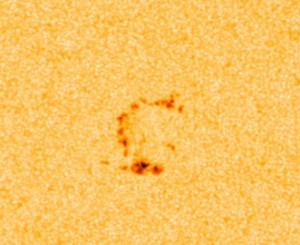 |
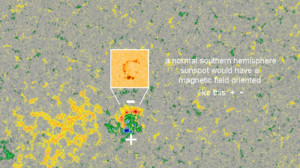 |
AR 13029 produced two C1 flares, one at 3:39 UT and one at 8:59 UT, both today (9 June). No further flares were observed from this region through at least 17:00 UT. By the time I observed this region, a leader and a trailing spot developed and became the dominant spots, while the active region itself lost it’s distinctive “C” shape.
AR 13029 is currently the only spotted region visible on the Earth-facing solar disk. There are several faculae/plage regions scattered across the sun. One such region is shown in the first image, a red continuum image of AR 13029 (left) along with a faculae field left over from some long gone active region (lower right). The right image centers on AR 13029 and shows its appearance in the light of H-alpha.
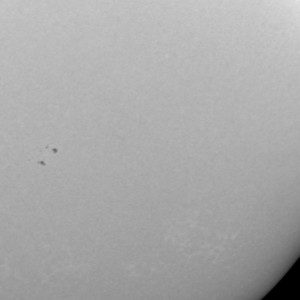 AR 13029 as imaged at 14:10:21 UT. AR 13029 as imaged at 14:10:21 UT. |
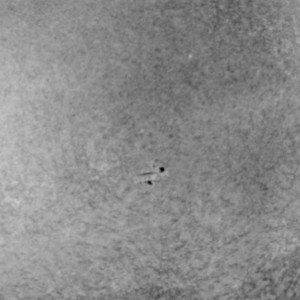 AR 13029 as imaged at 14:36:50 UT. AR 13029 as imaged at 14:36:50 UT. |
Solar activity is expected to remain very low through at least 11 June 2022, with a slight chance of C-class flares.
June 8, 2022
Solar activity continues to be very low, with the sun appearing spotless visually this morning during the visual sunspot count. One region has rotated out of view, leaving two regions which lost their spots earlier today. The image below is of a bright facula/plage region rotating into view along the eastern limb of the Sun. Each of the two images immediately below is 13.3’x13.3′ in size and oriented so that celestial north is up, west is right.
Solar activity is expected to remain very low through at least 10 June 2022. There is a slight chance of C-class flares over the next three days.
June 7, 2022
Solar activity continues to be very low. In fact, during this morning’s visual sunspot count, I found no spots on the Sun larger than about 2″ across, so the disk has gone spotless as far as we can see. The spots did not show on today’s images, either. The two image below are of the disk of the Sun adjacent to the east limb. The “x” marks the approximate location of AR 13029, which is not very distinct in either image. AR 13027, on the opposite side of the Sun, also has decayed from view. It is still viewable near the west southwestern limb but is very indistinct. The other regions we’ve been watching, AR 13023 and 13024 have rotated out of view. Each of the two images immediately below is 18.0’x13.3′ in size and oriented so that celestial north is up, west is right.
It is normal for the sun to go blank, or almost so, during solar maximum. While the overall number of spots increases and maxes out, over shorter time scales, the number can go up and down significantly. Overall, though, the sunspot number is increasing faster than predicted. Check out this update from NOAA SWPC on the progression of the current solar cycle.
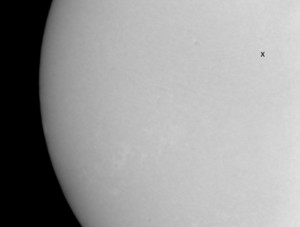 AR 13029 (“x”) along with some old faculae in this red continuum image taken at 15:31:56 UT. AR 13029 (“x”) along with some old faculae in this red continuum image taken at 15:31:56 UT. |
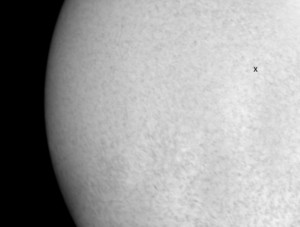 Same region of the Sun, but as seen in H-alpha. This image was recorded at 15:49:50 UT. Same region of the Sun, but as seen in H-alpha. This image was recorded at 15:49:50 UT. |
Solar activity is expected to remain very low through at least 9 June 2022.
June 6, 2022
Solar activity continues to be very low, as the small spots visible last week rotate out of view and one more rotates into view (there were two new groups, in the northern and southern hemisphere, but the northern hemisphere one decayed to spotless plage). The southern hemisphere group, now a single spot, produced a C1 flare at 12:00 UT on 5 June. Otherwise, all is quiet with a nearly featureless, spotless Sun.
Solar activity is expected to remain low until at least 8 June, with a chance for C-flares.
June 3, 2022
Solar activity continues to be very low, with only a B8.1 flare at 2:48 UT and a B6.7 flare at 7:20 UT today, both from AR 13024. Completely quiet otherwise (through 16:30 UT), as the four visible spotted regions on the Sun remain inactive, either stable or slowly decaying. No more spotted groups have rotated over the eastern limb, but this could change in a day or two. Not too many filaments are visible on the solar disk today.
The first image is a red continuum image of three of the four active regions; the second and third are H-alpha images of the regions. Each is cropped to 13.3’x13.3′, with celestial north up, east left.
Solar activity is expected to remain very low over the next three days, with a chance for C-flares and a slight chance for M-flares through at least 5 June.
June 2, 2022
Very low solar activity was interrupted by a C1 flare that erupted from a region behind the eastern edge of the Sun. This event occurred today at 6:21 UT and was the only such event to happen all day (through at least 19:25 UT). The large filament in yesterday’s image of the three active regions launched itself into interplanetary space around 5:00 UT. This produced a coronal mass ejection that is likely to miss the Earth.
Four small spotted regions are currently visible on the Sun, two of them stable, two of them in slight decay. AR 13027, the new region just noticed yesterday, has something unusual about it. The polarity is reversed from what it should be. More on this can be read from the www.spaceweather.com page, the page from June 2 (if you look after June 2, enter June 2, 2022 in the archives).
The images are presented in the usual manner for this website: the left column images are red continuum images, taken at the indicated time, 0.1 second exposures. The right column images are H-alpha emission line images, 1.0 second exposure. Each image is cropped to 13.3’x13.3′ and is shown so that celestial north is up, west is right. Solar north is currently tilted 15 degrees left of celestial north.
Solar activity is expected to be very low, with a chance for C-class flares, and a slight chance of M-class flares, through at least 4 June.
June 1, 2022
The extended stretch of low solar activity continues as the currently-visible spot groups are small and mostly inactive. Two new regions are growing on the solar disk: AR 13026, which has been the source of several B-class flares; and another region which I expect to be labeled 13027, east of the 13023/13024 pair. AR 13023 and 13024 remain quiet, and AR 13025 has rotated out of view.
There are three spot groups on the far side of the Sun, based on helioseismology. Check out the far side map image, which shows three possible spot groups. The largest of these is at least 10 days from rotating into view, but could provide a source of activity should it hold out until then.
Solar activity is expected to be very low, with a chance for C-class flares, through at least 3 June.
May 31, 2022
The extended stretch of low solar activity continues as the currently-visible spot groups are small and mostly inactive. A new region had developed over the weekend, AR 13025, but is preparing to rotate out of view. AR 13023 and 13024 remain quiet, and two new spots/spot groups have formed, one east of the AR 13023 / 13024 pair and one east of AR 13025. These two regions have not been numbered yet.
Solar activity is expected to be very low, with a chance for C-class flares, through at least 2 June.
May 26, 2022
Solar activity is trending back to a quiet phase as large AR 13014 rotates out of view. Despite its complex “beta-delta” magnetic configuration, it has been quiet except for a C2.9 flare at 2:20 UT. AR 13017 has been producing all of the activity today, a series of C-class flares. The largest event so far was a C7.2 from AR 13017. Once these regions rotate out of view, the Sun is nearly blank, with only 3 spotted regions, each with only one or two spots, dotting the disk. So we did a short survey type session to image all of the visible features on the solar disk this morning. The images below display all the visible spotted regions in two images. Each of the images includes two or three regions (labeled in each of the continuum images, left column). All the images are cropped to 13.3′ square.
Aside from a slight chance of an M-class flare from AR 13014/13017 complex before it rotates out of view, solar activity is expected to be low through at least 28 May 2022.
May 25, 2022
Despite some impressive regions on the solar disk, solar activity the last week has been low overall. Since the M3 of 20 May, there had been no M-flares until this afternoon, only lots of c-class activity. After a period of not-so-favorable weather, we resumed observations today and were surprised by the M1.3 flare we observed this afternoon. Although AR 13014 still looks impressive, it is about to rotate out of view, taking any activity with it. The other regions visible on the solar disk look quiet and un-remarkable.
The M1.3 was imaged by the Solar Dynamics Observer and can be seen here.
Solar activity is expected to be mainly low, with some chance for M-class flares, through at least 27 May.
May 19, 2022
There was a pause to the observing program to take care of various other needs with the ending of another semester. The pause will resume after today’s session as inclement weather is expected all next week and work in other areas pushes forward. The sun had been mildly active over the last week or so. The X-ray background has not dropped below C1.0 for over a week now; there are numerous C-flares and SF’s from various regions, and seven M-flares have occurred over the last week, with the strongest being in the overnight hours of North America. This was an M5.6 from AR 13017.
There are 11 labeled regions on the sun’s disk, with 8 of them observed to have spots this morning. These regions are depicted in images below: the ones in the left column are red continuum images, 0.1 second exposure each; the ones to the right are H-alpha images, 1.0 seconds each, of the same areas on the Sun’s disk.
Solar activity is expected to be low, with an ongoing chance of M-class flares and a slight chance of X-class flares (mainly from AR 13014), through at least 21 May.
May 13, 2022
After yesterday’s M1 flare, which elevated solar activity to moderate levels, activity has been low with only C-class flares from several active regions. The X-ray background has been above C1.0 continuously since 17:09 UT yesterday and continues to at least 22:11 UT today. Active Region 13007 continues to grow but has not produced anything more than C-class flares. AR 13006 has decayed some, but had experienced some growth, and hasn’t produced any flares today.
Each of the below images have been cropped to 13.3’x15.3′. The first column contains red continuum images; the second includes H-alpha images. Most of today’s images were made through cirrostratus of varying thicknesses; the clouds were somewhat thicker during the continuum imaging phase so these exposures were 1.0 seconds, like the H-alpha images. The purpose of today’s brief session was to gather follow-up images of the solar features we had been following all week.
Solar activity is expected to be low through at least 15 May. There is a chance for M-flares and a slight chance for X-flares during this period.
May 12, 2022
Today was quieter than yesterday in terms of solar activity, with fairly frequent C-class activity and only a single M-class event as of 22:40 UT, 12 May. AR 13006 and 13007 continue to be the main targets of monitoring today as the latter had the potential of an M-class or a slight potential of an X-class flare event. The M1.3 event did not have a defined source, but both 13006 and 13007, along with newly-visible region 13010 were the sources of most of the C-class activity.
The first two images are red continuum images of the regions indicated at the times stated. Each image is a 0.1 second exposure and measures 13.3’x13.3′ on the sky. The third is a 15.0’x13.3′ H-alpha image, 1.0 second exposure. Celestial north is up, west is right in each of these images.
C-class flares are expected, with a chance of M-class flares and a slight chance of X-class flares through at least 14 May.
May 11, 2022
Numerous small flares happened today between AR 13006 and AR 13007, mostly with AR 13307. They included lots of “SF’s” (small, faint optical flares), C-class events and M-class events. There were three M-class events: an M1.6 from 13007 at 16:49 (just after we closed down due to high clouds thickening), an M2.6 at 18:58 UT (about 30 minutes after we re-opened after skies cleared) and an M2.2 at 19:31 UT.
C-class flares are expected, with a chance of M-class flares and a slight chance of X-class flares through at least 13 May.
May 10, 2022
AR 13004 has rotated out of view, leaving two spotted active regions. AR 13006 developed a tight delta configuration in its central region (an interesting read about this can be obtained here, ensure it is the May 10 “issue” of this page). AR 13007 shows some development in its trailing regions also. Solar activity remained low through the early hours of this morning until an x1.5/1B flare erupts out of AR 13006, peaking in intensity at 13:55 UT (before we started observations, with mostly cloudy skies in place at that time). Prior to that, the X-ray flux abruptly rose to C3.7 level and plateaued for nearly a half-hour before the X-flare occurred. After the X-flare subsided, the X-ray background rose back to M1 level then slowly decayed, taking until 18:48 (some five hours later) to reach and drop below C1.0 level. Since then, not much in the way of significant activity.
Technical issues delayed the start of this morning’s observations, and a camera issue resulted in an unused STT-8300 camera being switched in for the one in use for the last year-and-a-half. This camera had some issues midday which resulted in a three hour gap in observations, but the system is operational as of this writing. The images below show the two spotted regions: the first two are red continuum images, 0.1 second exposure each, of AR 13006 (top) and 13007 (center, with some of 13006 visible lower right). The bottom is an H-alpha image of both regions in one frame, a 1.0 second exposure. Except for the first image, which spans 13.3’x13.3′, each image covers 15.0’x13.3′; celestial north is up, west is right in each image.
Solar activity is expected to remain low, with s chance of M-class flares through at least 12 May 2022.
May 9, 2022
The Sun has been at low activity levels since 14:16 UT May 5, the last M-class flare that has occurred to date. Since them only C-class flares have been occurring from three active regions (AR 13004, 13006 and 13007). So today we moved into quiet sun mode with only a short session in the morning hours. During this session, the Sun remained quiet with no flares. Today only three low level C- and one B-class event occurred. The spotted active regions of today are depicted in images below.
Each image below is cropped to 13.3′ squared, with celestial north up, west right. The first column are red continuum images, each 0.1 second exposures. The second column are H-alpha images, each 1.0 second exposures.
Solar activity is expected to remain low, with a chance for an M-class flare or two, through at least 11 May.
May 6, 2022
Since the pair of M-class flares yesterday during the predawn local time, solar activity has remained low until the present (22:00 UT). There were numerous low-level C-class flares, the greatest of which was a C4.8/SF at 16:22 UT, We observed this event with AR 13004, which was the prime target for monitoring today and yesterday.
Each image below is cropped to 13.3′ squared, with celestial north up, west right. The first column are red continuum images, each 0.1 second exposures. The second column are H-alpha images, each 1.0 second exposures.
Solar activity is likely to be moderate with a chance of an X-class flare through at least 8 May. There’s indications of another active spot group just behind the SE limb of the Sun. This group is expected to rotate into view this weekend.
May 5, 2022
The day started with 2 M-class flares less than an hour apart. AR 13004 produced an M2.2/SN at 13:16UT; AR 13006 produced an M2.7/SF that peaked at 14:10 UT (during both it was cloudy at PV Solar Observatory). Many C-class flares have come from mostly AR 13004 (22 of them from AR 13004 from 1:36 to 19:09 UT). Skies surprisingly cleared enough to get a full session in, for about an hour we imaged and looked for flare activity from the busy active region. Weather was expected to be cloudy ahead of storms later today.
Each image below is cropped to 13.3′ squared, with celestial north up, west right. The first column are red continuum images, each 0.1 second exposures. The second column are H-alpha images, each 1.0 second exposures. The crater-like ghost images in the red continuum images are processing artefacts.
Solar activity is expected to remain at moderate levels through at least 7 May, due to likely M-class flares , from AR 13006, along with AR 13004.
May 4, 2022
Six Flares Observed in One Day
In a 24 hour period, AR 13004 produced more than 18 solar flares (15+ C-class and 3 M-class, which includes an M5 at 8:59 UT.) and a half dozen were captured in today’s observing session. AR 13006 (second image from right) was also a source for flaring activity. Each of the below images are 5’x5′ crops, centered on the source active region, taken within minutes of the flare’s optical or X-ray peak output. The M and C prefixes signify the X-ray strength of the flare, the number that follows further refines the strength. Sometimes one may see “SF” or “1N” next to the X-ray class. This indicates the optical importance of the optical component of a flare (the S, 1, 2, 3 specify the size; the F, N, B denotes the surface brightness in three parameters: “Faint”, “Normal”, and “Bright”).
The two AR’s are expected to remain active through at least the 7th of May.
Daily Solar Observations Highlight
Solar activity reached high levels after an X1.1/SF yesterday. There was also an M5 flare that happened after the conclusion of yesterday’s session. Both of these originated from a region just behind the southeast limb. Some of this region has become visible this morning, but it may be a different region with the actual source region yet to rotate into view. The new region, as of yet unnumbered. does not appear too impressive.
However, AR 13004 is growing and looking more impressive as it crosses the center of the solar disk It produced an M5.7/1B flare at 8:59 UT. It also produced 9 C-flares (C1.0 to C8.6), one B-flare (a B8.9) and another M-flare (M1.1/1N/1F at 16:31), which we were able to observe in part. AR 13004 is one of four spotted regions visible on the solar disk. The first pair of images below show three of the four. AR 13004 dominates at upper left, with AR 13001 directly below it, and AR 12999 toward the right edge, near the Sun’s edge.
Each image below is cropped to 13.3′ squared, with celestial north up, west right. The first column are red continuum images, each 0.1 second exposures. The second column are H-alpha images, each 1.0 second exposures.
The forecast calls for the likelihood of M-class flares through at least 6 May, from the southeastern quadrant of the Sun, along with AR 13004.
May 3, 2022
There was a series of flares of increasing magnitude overnight as an active region is about to rotate over the southeastern limb of the Sun. Meanwhile, AR 13004 is developing and was responsible for several flares today, including an X1.1 that happened at 13:25 UT today. An extreme UV image of this event can be seen here. The same unseen region was responsible for an M1.3 at 8:001 UT. Since the X1.1 flare, through at least 22:00 UT, solar activity has remained low, with only a C1.5 event from an unspecified location.
During the imaging session the southeastern limb did not appear to be too active, so the focus was on the active region 13004. The below images show three of the spotted active regions. Each image is 14.3’x13.3′ and is set so that celestial north is up, west is right.
Solar activity is expected to remain low through at least May 5, though it could be moderate to high given the active region rotating into view over the SE limb. This was AR 12992 during its last visible passage across the visible disk of the Sun.
May 2, 2022
Skies were variably cloudy all day, Since Friday, AR 12994 became even more active. It produced five M-class flares and an X1.1 on 30 April. It continued putting out C-class flares on 1 May and is the source for at least one low-level C flare this morning. The Solar Dynamics Observatory observed the X-flare.
Four spotted regions are visible on the Sun today, down from eight last week. All of these are small and quiet, but AR 13003 seems to be resurging as new growth is seen where a day earlier all that existed there was plage. (NOTE: What was thought to be AR 13003 was designated 13004, an apparently new active region.) We did a short session today to image all the spots and features in red continuum and H-alpha. Outside the session, there had been some C-class events, including a C3.2 that peaked at 19:20 UT, but with no assigned region as of this writing.
Each image below is cropped to 13.3’x13.3′ to include the relevant details. The first column below contains red continuum images, each 0.1 second exposure. The second column includes H-alpha line center images, 1.0 second exposure each. The time each was taken is indicated as well.
Solar activity is expected to be low through at least May 4.
April 29, 2022
Skies were variably cloudy all day, with fewer clouds overall during the afternoon hours. We decided to follow the AR complex for the entire day after an overnight (Houston time) M1 flare from spotless region 12996 (which can be viewed in a still image here) at 7:30 UT.
There are seven spotted regions visible on the Sun today: one is very difficult to see as it rotates out of view, and one is unnumbered. The one rotating out of view is actually a pair: AR 12993 and 12994. AR 12994 produced an M1.2/SF at 18:10 UT (X-ray peak), with the optical component peaking four minutes earlier. A complete sequence was not possible, nor was an extra set of flats needed to properly calibrate available due the the abundant cloud cover. The three images below are cropped to 10.5’x6.7′ and oriented so that celestial west is up, north is left in each image.
As this page goes to post, it seems that AR 12994 is at it again. There is an X-ray event underway and GONG images show some activity on the limb near where the below flare took place. This new event is not as powerful, registering a C3 and peaking at 22:56UT, 29 April. It shows the long decay as the previous M1 flare showed.
Each image below is cropped to 13.3’x13.3′ to include the relevant details. The first column below contains red continuum images, each 0.1 second exposure. The second column includes H-alpha line center images, 1.0 second exposure each. The time each was taken is indicated as well.
Solar activity is expected to be mainly low, with a slight chance of M-class flares through at least May 1.
April 28, 2022
More clouds were present to hinder observations. After a cloudy start, the skies ranged from partly to mostly cloudy and only a short two-hour session was held in the late morning. This was to provide follow-up images of regions and features and look for the occasional C-flare that has been happening regularly from many of the eight visible active regions seen on the Sun today.
The spotless region AR 12996 produced a C6.7 flare event that peaked at 3:06 UT. AR 12994 was the source of three other flares (C1, C2, and C1) that all peaked before 12:15 UT today. It just released another flare, a C3.7 which peaked at 18:12 UT today after the daily session closed. No significant events were observed during our session from 15:30 to 17:00 UT.
Each image below is cropped to 13.3’x13.3′ to include the relevant details. The first column below contains red continuum images, each 0.1 second exposure. The second column includes H-alpha line center images, 1.0 second exposure each. The time each was taken is indicated as well.
NOAA continues to forecast a slight chance of M-class flares from the active region complex through 29 April. Overall, solar activity is expected to remain low through at least 30 April.
April 27, 2022
It has been a beautifully sunny day all day today, with excellent seeing (steadiness) and transparency (clarity of air). Our active regions continue their steady march across the Sun’s disk, with the complex of four regions dropping by one as AR 12996 decays to plage. Even in its plage state, the region produced a long duration C7.6 flare that started around 14:20 UT and peaked at 14:54 UT. The event took two hours to decay back to pre-flare x-ray levels. The flare started and peaked before we started observing today, but we were able to catch some of the decay of this flare (second image, bright spots, below). Prior to this there had been five lesser events, ranging from C1.2 to C3.3 and coming from regions 12994, 12996, and 13001. Nothing significant has occurred since the long duration C7 event (as of 21:00 UT).
Each image below is cropped to 13.3’x16.3′ to include the relevant details. The first column below contains red continuum images, each 0.1 second exposure. The second column includes H-alpha line center images, 1.0 second exposure each. The time each was taken is indicated as well.
NOAA continues to forecast a chance of M-class flares from the active region complex through 29 April.
April 26, 2022
Breaks in the clouds for a short time allowed for a short session to image the regions we’ve been following over the last week or so. The active region complex that have been the focus of much observations last week is starting to rotate toward the western limb of the Sun. It continues to generate flares at fairly high frequency: between 8:00 and 17:00 UT today, there had been seven low-level C-class events. Outside of this sequence, the Sun had been mainly quiet. The last significant events have been two M-class events one right after the other, yesterday overnight North American time. Since then it’s been a pattern of short, frequent C-class flares, punctuated by longer-duration events. NOAA forecasted a 40% chance of M-class flares and a 10% chance of X-class flares today but at of 22:27 UT, 26 April, none of these has materialized.
NOAA continues to forecast a chance of M-class flares from the active region complex; there is a slight chance of C-class flares from the same complex through at least 28 April.
April 25, 2022
Solar activity reached moderate levels this morning thanks to a pair of M-class flares from AR 12993. The Sun had been quiet over the weekend but has just begun to ramp up the activity level lately. Today’s observing was an attempt (or several attempts) to capture some followup images of the large complex of active regions under a mostly cloudy sky with some breaks. The opportunities were brief, but we were able to capture some imaged. Unfortunately these weren’t the best but we did capture the C3 flare from 12993 (visible as two faint arcs below the middle sunspot). The first two images below are of AR’s 12993, 12994, and 12995. The first of these was in red continuum, the second in H-alpha. The third is an image taken in red continuum of AR 12999 (it was not possible, due to weather, to get an H-alpha image of this region).
Solar activity is expected to be low to moderate thru at least 27 April.
April 22, 2022
Solar activity remains in the moderate range as periodic C-class flares continue, with two M-class events since yesterday’s short session. AR 12993 was the source of both M-flares: an M1.1 at 5:14 UT and an M3.4/2B flare at 13:25 UT. Since these events, all has been quiet during today’s watch, except for a C3.6 at 13:45 UT and a C2.0 (observed as a “SF”) at 15:08.
The first set of images are of the “AR Complex”, four regions that include AR’s 12993, 12994, 12995, and 12996. These images are cropped to 13.3’x15.0′ to include the entire region. The second set of 13.3’x13.3′ images are of AR 12991, whose spots have decayed two days ago, but more have re-emerged. It is essentially a quiet region. The first column are red continuum images, the second are H-alpha line center images.
Solar activity is expected to remain at moderate levels with M-class flares expected and a chance for an X-flare through at least 24 April 2022.
April 21, 2022
High solar activity continues. AR 12933 produced an M9.6/1N flare, whose X-ray peak happened at 1:59 UT and the optical peak was at 2:24 UT. This region produced 5 SF’s (small flares) beside the large one. AR 12994 produced a C5.4/1F flare at 12:55 UT. Since then the Sun has been quiet with the X-ray background around the C1.5 to C2.0 level with a very slow decline.
Solar imaging was much briefer than anticipated due to much cloudier conditions than anticipated (even by most weather forecasting entities). We only obtained a few continuum images, along with calibration images. Solid overcast remained for the rest of the day.
This image was recorded at 17:31:29 UT (four minutes after the peak of a C3.1 flare), and it shows four active regions. The 12993/12994 pair is in the lower right of the image. The larger single spot, left-center, is AR 12995. The smaller spot almost directly above it is AR 12996.
Solar activity is expected to remain at moderate levels through at least 23 April, with M-class flares expected and a chance for an X-class flare from AR’s 12993 and 12994
April 20, 2022
The Sun continues to be rather active today with 14 C-class flares, 3 M-class flares and an X2.2 flare. The X-flare was from AR 12992, which was just over the solar horizon, having rotated out of view yesterday. Regions 12992, 12993, and 12994 produced these flares, with an M7.2 at 1:36 UT from AR 12992, an M 1.2 from AR 12994 at 1:14 UT, and an M1.9 at 12:53 UT from AR 12993. Skies unexpectedly became partly cloudy by mid-day, enabling observations of these active regions. Clouds were variable, so coverage was variable, occurring mainly between 17:00 and 20:15 UT. We observed a C7.7/SF at 17:57 UT from AR 12993 and a C8.9/SF at 18:40 UT. The only other region outside of the complex of regions shown below is AR 12991, in the southern solar hemisphere, which continues to decay.
The first image below is a 0.1-second exposure in red-continuum light taken at the indicated time. It shows AR 12993, 12994, 12995 (the single spot far left) and yet another region (smaller single spot above 12995 right on the edge). These same regions are depicted in the two H-alpha images below center and right, each 1.0 second exposure taken at the times indicated. The second H-alpha shows the C8.9 flare near the X-ray peak intensity. Each image is 13.3’x13.3′ with celestial north up, west right.
Solar activity is expected to remain at moderate levels through at least April 22 with M-flares expected and a chance for X-flares.
April 19, 2022
The Sun has declined in activity over the last day or so. Since 24 hours ago (21:00 on 18 April) only one M-class flare occurred, from AR 12993 at 4:50 UT. The X-ray background has been above C1.0 level since 1:30 UT today, after a brief dip into “B” territory following four full days of being continuously at or above C1.0 level. Today there have been five C-class events and one M1.0 event. The C-events came from AR 12993 or 12992; the M1.0 event, which peaked at 4:50 UT, was from AR 12993. There had been three further C-class events, a C3.3 at 14:06 UT, a C3.3 at 17:00 UT and a C4.4 at 18:42 UT. Further to these was an M3.7 from departing AR 12992 at 20:49UT and an M1.6/SN from AR 12994 at 21:13 UT.
The complex of large spots in the northeastern part of the Sun’s disk, dominate the Sun’s appearance. Other regions have either become quieter and simpler, or have rotated out of view. AR’s 12993, 12994 and 12995 make up the complex in the northeastern part of the solar disk. the images below are of these regions, with a 0.1 second red continuum exposure in the first frame and a 1.0 second H-alpha exposure in the second frame. Observing lasted into the later part of the morning, when clouds moved in and rendered the sky overcast.
Solar Activity is expected to reach high levels from now until the 21st of April. M-flares are expected with a chance for X-flares.
April 18, 2022
Solar activity has increased over the last weekend and remains moderate today. Some larger active regions have rotated into view: they first became visible Saturday (16 April) as two large spots on the edge; the third spot appeared a day later. The entire complex has come into better view and had produced an X1 flare that peaked at 3:35 UT on 17 April.
Several M- and C-class flares have occurred since but most were from AR 12992, which recently formed and is now rotating out of view. Indistinguishable now from 12992 is 12987, which produced an M1.9/SF today at 17:24 UT (the flare in its decay phase is shown below). There is the potential for more activity in the days ahead as the AR 12993/12994 complex rotates more into view and possibly another large spot complex rotates right behind this one.
The first column’s images are red-continuum images, 0.1 second exposure each, taken at the time indicated. The second column’s images are H-alpha line center images, 1.0 second exposure each, taken at the times indicated. Each image is cropped to 13.3′ square and is oriented so that Celestial north is up, west is right.
Solar Activity is expected to remain high with a good chance for another X-flare and with M-flares expected, through at least 20 April.
April 14, 2022
Solar activity has been low to very low for the last week, with the Sun becoming spotless on one of the days. However, there had been at least one C-class flare each day (except the 13th), the largest of which was a C4.9 at 2:40 UT on 10 April. A notable event was when a “dead sunspot” region, plage region 12987 produced a C1.5 flare on 11 April at 5:30 UT. This event hurled debris into space toward Earth (the video of this explosion, taken with the SDO satellite, can be seen here). The CME has impacted the Earth’s magnetic field and as of this writing (18:25UT), a moderately strong G2 geomagnetic storm is happening now.
A long duration C1 X-ray event occurred today, lasting nearly 4 hours and peaking at 13:22 UT. This was from one or more of some sunspots beyond the eastern limb that are poised to return in a few days. This may include old AR 12975, the source of an X-flare last month, which could reappear in the next 2-3 days or so. There has been much activity happening on the farside of the Sun, including this CME which is set to impact Mercury. This was from a large sunspot complex which is expected to rotate over the Sun’s eastern limb in less than a week.
The first column’s images are red-continuum images, 0.1 second exposure each, taken at the time indicated. The second column’s images are H-alpha line center images, 1.0 second exposure each, taken at the times indicated. Each image is cropped to 13.3′ square and is oriented so that Celestial north is up, west is right.
Solar activity is expected to be low through at least April 16, with an increasing chance of C-flares as these three days progress.
April 8, 2022
There has been a bit of an uptick in activity today, with low-lever C-class flares happening fairly regularly since 11:21 UT today. AR 12983 decayed to plage a few days ago, but new spots have re-emerged and has been the source of a C1.0 flare at 11:21 UT and another C1.0 flare at 17:29 UT (this event is shown below). AR 12978 and 12981 were the source of aC2.4/SF (actually 2 SF’s) between 14:55 and 15:14 UT. Otherwise, solar activity has been low, with only four small active regions visible on the solar disk.
AR 12978 and 12981 have continued to decay together and are about to rotate out of view.
The first column’s images are red-continuum images, 0.1 second exposure each, taken at the time indicated. The second column’s images are H-alpha line center images, 1.0 second exposure each, taken at the times indicated. Each image is cropped to 13.3′ square and is oriented so that Celestial north is up, west is right.
Solar activity is expected to get to very low levels through at least 10 April, with a slight chance of another C-flare or two today.
April 7, 2022
Solar activity remains low with the occasional C-class flare. AR 12985 produced one such event, a C1.2/SF at 1:31 UT on 7 April, but otherwise everything has been quiet. Only 12985 and the pair 12978/81 remain as visible spots on the solar disk. The latter is about to rotate out of view in a few days and are in the process of decaying.
The filament that was observed yesterday launched itself from the Sun at 6:11 UT on 7 April. It is not clear yet whether this is headed toward Earth or not.
The first column’s images are red-continuum images, 0.1 second exposure each, taken at the time indicated. The second column’s images are H-alpha line center images, 1.0 second exposure each, taken at the times indicated. Each image is cropped to 13.3′ square and is oriented so that Celestial north is up, west is right.
SWPC still forecasts a slight chance of an M-class flare through 9 April, though the Sun is most likely to remain quiet during this time.
April 6, 2022
The Sun continues to become more and more quiet. Active Regions 12978 and 12981 are generating an occasional C1/SF, but have been quiet otherwise. Several long dark filaments are also visible, a few of which are imaged below.
The first two images are AR 12978; the first is red continuum and the second is H-alpha. The accompanying region, AR 12981 has decayed to only a few tiny spots. The third image shows several prominent filaments. The one near the upper left corner of the image seems a bit active and could erupt at some time in the near future.
Solar activity is expected to remain low, with a slight chance for an M-class flare through April 8.
April 5, 2022
The Sun has quieted down considerably since last week. Active regions 12975 and 12976 have rotated out of view, leaving AR 12978 the largest region visible. Today it has decreased in size and has become quiet. Only two other small regions are visible on the visible disk. There are signs that more large active regions may be just over the eastern limb, ready to rotate into view in the next day or two.
Several long dark filaments are also visible, a few of which are imaged below. Two have affected the flat field images and have left their marks as bright streaks near the bottom of the second and third images.
The first two images are AR 12978, with 12981 below it, forming a triangle with the leading and trailing spots of the former. The third image depicts AR 12985 as a single dark spot devoid of place above image center. Note the dark filament in the bottom right part of the image.
Solar activity is expected to remain low, with a slight chance for an M-class flare through April 7.
April 1, 2022
Solar activity has quieted down considerably since yesterday, with the greatest event in the last 24 hours (prior to 20:35 UT) being a C5. Of note is that the X-ray background has been continuously above C1.0 level since 10:15 UT, 30 March. Since yesterday’s M9 flare, there have been many minor C-class flares, entirely from AR’s 12978 and 12981. They seem to be trending less and less in intensity, but have been occurring from multiple times per hour to once every hour or two. The two larger active region pairs have dominated the solar disk. There is an unnumbered spot, a single spot near N24E58, and another trailing the 12978/81 pair.
The images in the first column are red continuum images, 0.1 second exposure each; those in the second column in the table below are H-alpha line images, 1.0 second exposures. Each image covers 13.3’x13.3′ of sky with celestial north up, west right.
Solar activity is expected to be low to moderate through at least 3 April. There is a chance of X-class flares during this time, and AR’s 12975, 12978, and 12981 have the potential to produce M-class or greater events.
March 31, 2022
Solar activity was high today due to an M9.6 flare from AR 12975. This region had produced a couple of C-class flares before the large flare. It had been mostly quiet since. AR 12978, the other large active region, has produced several C-class flares. A newly-emerging region, AR 12981, located below 12978, produced some C-flare activity as well. But the highlight for the day was the M9.6 / 1B flare from AR 12975, shown below. Also, check out an animation of this event in extreme UV at this link.
The images in the first column are red continuum images, 0.1 second exposure each; those in the second column in the table below are H-alpha line images, 1.0 second exposures. Each image covers 13.3’x13.3′ of sky with celestial north up, west right.
We observed today’s M9.6 flare in its entirety. The event peaked optically at 18:37 UT and is shown in the below image.
Solar activity is expected to be low overall, with a chance of M-class flares and a slight chance of X-class flares through at least 2 April.
March 30, 2022
Solar activity was high today due to an X1.3 flare from AR 12975. This region had produced 11 C-class and 6 M-class flares on 28 March 2022 alone. These produced at least two coronal mass ejections (CME’s), the second of which is expected to overtake the first. The first was generated by the M4 flare at 11:29 UT (28 Mar.) and the second by the M1-flare at 19:24 UT (also 28 Mar.). Check out the CME’s here.
Some of the smaller active regions have decayed to plage regions; at least late this morning, no spots were observed at AR 12974, 12977, and 12979. There may be two small AR’s following AR 12978 onto the visible solar disk.
The images in the first column are red continuum images, 0.1 second exposure each; those in the second column in the table below are H-alpha line images, 1.0 second exposures. Each image covers 13.3’x13.3′ of sky with celestial north up, west right.
We observed today’s X1.3 flare in its entirety. The event began at 17:21UT, peaked at 17:37UT, and ended at 17:46 UT. The images below shows the event near the X-ray peak as observed by two instruments, the PVSO telescope (left) and the Solar Dynamics Observatory satellite (right).
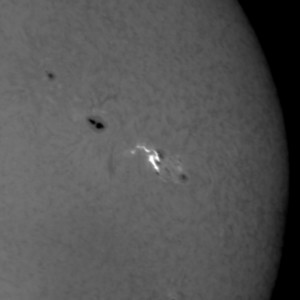 X1.3 in H-alpha light X1.3 in H-alpha light |
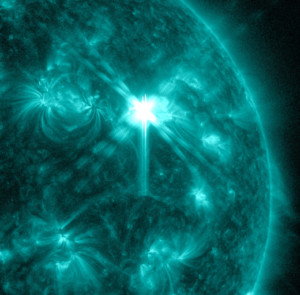 NASA’s Solar Dynamics Observatory extreme ultraviolet image of the flare. NASA’s Solar Dynamics Observatory extreme ultraviolet image of the flare. |
The event produced a full-halo CME, as can be seen in these newly released SOHO images.
Solar activity is expected to be low, with a chance of M-class flares through at least 1 April.
March 28, 2022
The Sun has become much more active in the last 24 hours or so as new magnetic flux in the form of many small spots clustered in the trailing end of AR 12975. This region produced an M4 flare which peaked at 11:29 UT; in fact the X-ray flux moved into the C-range at 11:00 UT and remained their continuously through this posting (21:35 UT).
A large new active region (AR 12978) rotated into view and has produced a number of C-class flare events yesterday and earlier today, but since the M4 event, AR 12975 has been the source of a number of events, including another M1 at 17:32 and another at 20:59 UT. Observations started late this morning and will continue through 22:30 UT today to document this very active region.
The images in the first column are red continuum images, 0.1 second exposure each; those in the second column in the table below are H-alpha line images, 1.0 second exposures. Each image covers 18.0’x13.3′ of sky with celestial north up, west right.
We observed six solar flares in one afternoon. Each of the below images was cropped to 10.5’x8.4′ centered on each flare and were taken in H-alpha line center. The first image was taken with the filter 0.9 Angstroms blueward of H-alpha line center and shows a component of this flare that was moving straight toward the Earth. The flare peak times are those of the X-ray flare peak; the optical flare peak is normally several minutes different than the X-ray peak.
Solar activity is expected to remain low through at least 30 March 2022, with a chance for M-class flares each day.
March 25, 2022
Solar activity became moderate due to an M1.4/1F flare that peaked at 5:26 UT. This came from Active Region 2974. Several B-class events have taken place today, but none have been attributed to an active region, except for a B5.5 that peaked at 15:53 UT and was accompanied by brightening in AR 12974. AR 12975 actually is two regions: 12975 and 12976; both were quiet all day today. These three regions are the only spotted regions currently visible on the solar disk.
The images in the first column are red continuum images, 0.1 second exposure each; those in the second column in the table below are H-alpha line images, 1.0 second exposures. Each image covers 13.3’x13.3′ of sky with celestial north up, west right.
Solar activity is expected to remain very low through at least 27 March 2022, with a chance for C-class flares each day.
March 24, 2022
Solar activity remains low, due a few C-class flares: AR’s 12974 and 12975 each produced several C-flares yesterday; today 12975 generated a C8.1 flare at 1:45 UT and 12974 produced a C1.9/SF at 21:15 UT. These are the only spotted regions currently visible on the solar disk. AR 12975 may actually be two active regions right next to each other, but this should become clearer tomorrow.
The images in the first column are red continuum images, 0.1 second exposure each; those in the second column in the table below are H-alpha line images, 1.0 second exposures. Each image covers 13.3’x13.3′ of sky with celestial north up, west right.
Solar activity is expected to remain very low through at least 26 March 2022, with a chance for C-class flares each day.
March 23, 2022
Solar activity remains low, due to a series of C-class flares: AR 12972 produced a C1 flare yesterday then decayed to a single small spot as of this morning; AR 12974 produced a C1 and C4 flare yesterday, then a C2.5 and C3 flare today. The new active region, or the one still unseen behind it, produced a C7 flare event yesterday-the source of this was at or just beyond the northeast limb of the Sun.
The images in the top row are red continuum images, 0.1 second exposure each; the one in the second row in the table below is an H-alpha line image, a 1.0 second exposure. Each image covers 13.3’x13.3′ of sky with celestial north up, west right.
Solar activity is expected to remain very low through at least 25 March 2022.
March 22, 2022
The Sun is nearly a blank disk today as observations have resumed. Only three small spotted groups are visible on the sun today, all in the solar northern hemisphere. These are depicted in images below.
AR 12974 was the source of seven B- and C-class X-ray events between 0:00 UT and 20:25 UT. AR 12972 produced a C1.1 at 1:32 UT, and 12968 was the source of a B4.6 event an hour later. So solar activity is at low levels today.
The images in the first column are red continuum images, 0.1 second exposure each; those in the second column in the table below are H-alpha line images, 1.0 second exposures. Each image covers 13.3’x13.3′ of sky with celestial north up, west right.
Solar activity is expected to remain very low through at least 24 March 2022.
March 15, 2022
Solar activity reached moderate levels again today, thanks to an M1.4/SN flare from active region 12965. In fact, through 21:00 UT this region was responsible for 4 C-class, 1 M-class and 1 B-class event, along with an optical “SF” event with no X-ray counterpart. Hence we decided to monitor this region for the entire day today (will total over 8 hours of coverage) for additional flares. So far, the C1.0 and the B4.5 were the only events documented thus far. The region was mostly quiet during this period (through 21:00 UT, with two more hours to go).
The other visible regions on the Sun were unremarkable. AR 12960 is in the process of rotating out of view today, and AR 12968 decayed to plage while 12970 appeared as a small cluster of a half-dozen tiny spots.
The images in the first column are red continuum images, 0.1 second exposure each. The images in the second column in the table below are H-alpha line images. These are 1.0 second exposures. The images of AR 12960 cover 13.3’x13.3′; and those of 12965 (with 12967 visible left edge) are 18.0’x13.3′ in size; celestial north up, east left.
Solar activity is expected to remain very low, with a slight chance of M-class flare activity, through at least 17 March 2022.
March 14, 2022
Solar activity reached moderate levels today. Active region 12965 appears as a long stretch of spots and was the source of an impulsive M2 flare at 8:40 UT today. The other visible regions on the Sun were unremarkable. AR 12960 appears as a rather large single spot, nearing the edge of the Sun. The complex of active regions that led this across the disk have all rotated out of view.
The images in the first column are red continuum images, 0.1 second exposure each. The images in the second column in the table below are H-alpha line images. These are 1.0 second exposures. The images of four active regions cover 13.3’x13.3′ with celestial north up, east left.
Solar activity is expected to remain very low, with a slight chance of M-class flare activity, through at least 16 March 2022.
March 10, 2022
Solar activity remains at low levels. The spot groups remain visible on the solar disk, with AR 12965 looking more impressive as it rotates into view. The complex of five active and plage regions, followed by AR 12960, continues to rotate toward the western solar limb. A pair of flare ribbons appeared and lingered for a long time in the vicinity of AR 12962; these began around 18:25 and peaked (so far) at 20:33 UT at C2.8 level.
The images in the first column are red continuum images, 0.1 second exposure each. The images in the second column in the table below are H-alpha line images. These are 1.0 second exposures. The images of four active regions cover 18.0’x13.3′ with celestial north up, east left. The images of AR 12965 in the bottom row are cropped to 13.3’x13.3′, celestial north up, east left.
Solar activity is expected to remain very low, with a slight chance of M-class flare activity, through at least 12 March 2022.
March 9, 2022
Solar activity remains at low levels. There are six spot groups visible on the solar disk today, but most of these are unremarkable, meaning not much activity from them. Observations resumed today through breaks in the clouds.
The images in the first column are red continuum images, 0.1 second exposure each. The images in the second column in the table below are H-alpha line images. These are 1.0 second exposures. The images of four active regions cover 18.0’x13.3′ with celestial north up, east left. The images of AR 12965 in the bottom row are cropped to 13.3’x13.3′, celestial north up, east left.
Solar activity is expected to remain very low, with a slight chance of M-class flare activity, through at least 11 March 2022.
March 3, 2022
Today was a much quieter day on the Sun, with hardly a “peep” since yesterday’s large, unexpected M2 flare event The last C-class event was a c1.0 at 23:20 UT on 2 March. Today, only five B-class events from AR’s 12959 and 12960 (the former is newly formed near 12957; the latter just rotated into view) occurred. So solar activity has been very low today.
The spotted regions are depicted in images below, each taken at the indicated time. AR 12958 (bottom right) has become essentially spotless, showing only some plage in the H-alpha image.
Solar activity is expected to remain very low through at least 5 March 2022.
March 2, 2022
Solar activity reached moderate levels today thanks to an M2/1B flare that came from an unexpected source: AR 12958. This event peaked at 17:39 UT (optical peak at 17:35 UT). This region was responsible for a C1.0 flare at 11:43 UT. AR 12957 had grown significantly since yesterday (compare images between yesterday and today) and was the source of seven flares between 1:30 UT and 9:42 UT today. These were small flares, B- and C-class in the X-ray component and “SF” in the optical component.
Today’s spotted active regions are shown below, with red continuum images (each 0.1 second exposure) in the left hand column; and H-alpha line center images (each 1.0 second exposure) are in the right hand column. The images are cropped to 13.3′ square, with celestial north up, west right.
Solar activity is expected to remain very low through at least 4 March, with the slight chance of isolated C-class activity.
March 1, 2022
Today’s session was meant to provide a daily documentation of the regions and features of the Sun in red continuum and H-alpha light. AR 12957 and 12958 were monitored continuously for 30 minutes in the event of unexpected activity (there was none). There have since the session been three low amplitude, long duration B-class events: no reports are yet available as to the source, but it seems likely they are from AR 12957. Two earlier events came from this region: a B2.9/SF peaking at 2:30 UT and a B6.7/SF peaking at 13:08 UT. We monitored for such events from 16:42 to 17:15 and did not observe any. The subsequent events peaked at 18:02, 19:55 and 20:59 UT. NOAA SWPC’s outlook calls for a slight chance of C-class flares through at least March 3.
The table below depicts the current spotted active regions, with red continuum images (each 0.1 second exposure) in the left hand column; and H-alpha line center images (each 1.0 second exposure) are in the right hand column. The images are cropped to 13.3′ square, with celestial north up, west right.
Solar activity has been very low and is expected to remain very low through at least 3 March.
February 28, 2022
After a ten-day hiatus due to travel and bad weather, observations have resumed once again. The eagerly-anticipated return of AR 12936 ( = AR 12954) ended up being a dud as it, along with a second, twin spot, rotated into view last week, entirely unremarkable. These were the only two regions visible on the Sun for several days before some additional, small active regions began to develop and rotate into view a couple days ago. The Sun’s disk now sports five spotted regions, with more possibly to come.
Today’s session was short, meant to provide a daily documentation of the regions and features of the Sun in red continuum and H-alpha light. The table below depicts the current spotted active regions, with red continuum images (each 0.1 second exposure) in the left hand column; and H-alpha line center images (each 1.0 second exposure) are in the right hand column. The images in the first two rows are full-sized 18.0’x13.3′ images with celestial north up, west right. The last row of images are cropped to 13.3′ square. The images with multiple active regions are labeled in the first column.
A c5/SF erupted from the spotless plage region left and below (as seen in the bottom images) of the spotted region AR 12957. Other than this, all has been quiet the entire day.
Solar activity is expected to remain very low through at least 2 March with a slight chance of C-class flare events.
February 18, 2022
The decline in activity and spot number continues. AR 12948 is the largest visible active region on the Sun, with the other six regions either invisible or little more than one or two spots. Most of the regions are in states of decay, AR 12948 is stable. AR 12950 produced a C1 flare yesterday at 20:51 UT, and two B-class flares today prior to this afternoon’s observing session. Each image below is cropped to 13.3′ square and is oriented so celestial north is up, west is right.
Solar activity is expected to be at very low levels through at least 19 February. There is a chance for C-class flares during this time. Old AR 12936 could be about to return on 20 February, which brings a slight chance of M-class flares.
February 17, 2022
The Sun now contains a half dozen small spot groups on its visible disk. The largest of these is AR 12948, which also has the most complex X-ray configuration of any of the visible spots. Yet it remains inactive as far as solar flares are concerned. Minor flares came from three of the active regions: a C2 from AR 12941 (which is just beyond the western limb), several B-class flares from AR 12946, and a C1 flare from AR 12950. Assorted filaments and prominences are also visible on the solar disk.
It appears that AR 12936, now on the far side of the Sun, has grown to become a very large sunspot complex. It is expected to rotate into view in four days or so.
Solar activity is expected to remain low through at least the 19th of February, with a decreasing chance of M-class flares through the 18 and decreasing C-class flare frequency throughout the period. This all could change with the return of AR 12936 on the 21st or 22nd.
February 16, 2022
Solar activity is back to low levels after yesterday’s M1 flare from departing region 12941. Today, this region is largely invisible as it rotates out of view, leaving a smattering of small active regions scattered across the face of the Sun. There are five numbered regions and one un-numbered region visible on the Sun’s disk. Three more regions, AR 12941, 12945, and 12947, have all rotated out of view.
There is much activity on the farside of the Sun. Late on the 15th, a huge coronal mass ejection erupted from the side of the sun facing away from us. It was likely from a large solar flare from a large sunspot group. The STEREO-A satellite (which can see partway around the sun, revealing things we cannot see directly from Earth) shows a long stream of plasma over 400,000 km long rising from the active region. This was the second such energetic event from the solar farside since September 2017. The active region responsible for this will rotate into view in 4 to 5 days and we will be watching, weather permitting.
Mostly cloudy conditions limited todays observations. We did have some relatively clear skies for long enough to get follow up images of the active regions currently visible as well as other solar features.
Solar activity is expected to remain very low through at least 18 February. AR 12941 may produce another detectible M-class flare through the 17th before it rotates too far over the solar horizon.
February 15, 2022
Solar activity remains at moderate levels as another M-class flare, an M1.3 that peaked at 18:15 UT, from AR 12941 that is getting close to the west limb of the Sun. This flare has a similar X-ray profile as yesterday’s flare but the pre-flare plateau was much longer and the second peak (the first leveled at C9) a bit more pronounced over that of yesterday’s M-flare. All the visible spot groups are small. AR 12943 was spotless for a short while, but new spots emerged yesterday and grew today. It produced a C5 and several B-class flares prior to this morning’s observing session. AR 12947 has become difficult to discern as it gets closer to the western limb of the Sun. AR’s 12946 and 12948 remain un-remarkable as they rotate toward the disk center. And appearing just over the northeast limb (not shown below) is a new unnumbered spot.
The images at left are red-continuum images, 0.1 second exposure each. The images in the right column are H-alpha line-centered images, 1.0 second exposure each. The images are each cropped to 13.3′ square on the sky and are oriented so that celestial north is up, west is right.
Solar activity is expected to remain low through at least 17 February, with a chance of another M-class flare from 12941 before it rotates out of view.
February 14, 2022
The Sun maintains a low to moderate level of activity. In fact, two days ago, the Sun experienced a flurry of activity as AR’s 12939, 12940, 12941, and 12944 all produced solar flares ranging from C6 to M1. A filament also exploded in the Sun’s southern hemisphere. All of this action sent multiple CMEs into space. Some of this activity continued into the next day and today, there had been a C5 and an M1 event, both from AR 12941. Today’s session focused primarily on AR 12941 and documented the M1.0/SF that occurred. Monitoring of this region, which is accompanied by AR 12947 just to its south, began and 17:02 UT and continued through 18:20 UT.
The X-ray component of the event began at 17:02 UT, peaked at 17.31 UT (there was a first peak at C9.7 at 17:24 UT), then lasted until 17:51 UT (although the X-ray flux did not return to pre-flare levels until 19:45 UT). There was an optical counterpart observed, which began at 17:20 UT, reached maximum (“SF” status) at 17:32 UT, and ended by 17:36 UT.
There were four other spotted active regions visible. Plage region 12943 appears to be resurging as spots were noted at or near its position. A number of prominences and filaments were also noted.
Three images from the sequence of the M1.0 flare are shown below.
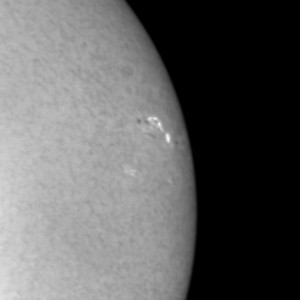 Start of optical flare, at 17:20:27 UT. Start of optical flare, at 17:20:27 UT. |
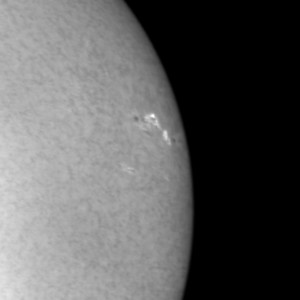 Near X-ray flare maximum, at 17:31:02 UT. Near X-ray flare maximum, at 17:31:02 UT. |
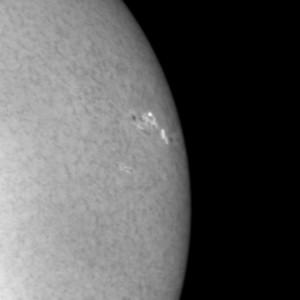 Near end of optical flare, at 17:36:19 UT. Near end of optical flare, at 17:36:19 UT. |
Solar activity is expected to remain low, with a chance of M-class flares from AR 12941, through February 16.
February 11, 2022
Solar activity remained low as the visible spotted regions continue to decay or rotate out of view. Although everything appears quiet at quick glance, there had been some low level events today. AR 12939 was responsible for a B9.7/SF and B7.6 flare event at 1:28 and 6:57 UT, respectively. AR 12941, as of this writing (19:36 UT) only produced one B7.6/SF event, peaking at 00:12 UT yesterday evening local time. AR 12940 produced a C1.1 event at 12:50 UT and a C2.5 event at 17:42 UT (just after the 17:15 UT conclusion of today’s short session). An unnumbered spotless region south of AR 12945 produced a C1.2 flare at 10:20 UT.
The visible active regions are shown below. Each image, cropped to 13.3’x13.3′, is oriented so that celestial north is up, west is right. The left column includes red continuum images, each 0.1 second exposure. The right column features H-alpha line center images, each 1.0 second exposure.
Solar activity is expected to remain low with more C-class flares likely, through at least February 13. There remains a slight chance of an M-class flare during this period.
February 10, 2022
Solar activity remained low with the occasional C-class flare from one of four significant active regions visible on the Sun’s disk these days. AR 12941 continues to be the most prominent region visible, and the most magnetically complex, but it is also in a decay phase and today it looked less impressive than it did yesterday. Another region formed south of AR 12939, this is AR 12944, shown below. To the east of both, it appears another active region is forming: it may be designated AR 12945 if its growth continues.
Each of the images below is cropped to 15.4’x13.0′ to accommodate two or more active regions. The images in the left column are red-continuum; those in the right column are H-alpha.
Solar activity is expected to remain low, with a slight chance of an M-class flare, through at least February 12.
February 9, 2022
A bit more activity today as a number of B- and C-class events took place between 4:38 UT and 19:39 UT. We caught two of the events: a C5.7/SF that peaked at 17:36 and a longer-duration C3.1/SF that peaked at 19:39 UT. The former was another unexpected event from AR 12939; the latter was from AR 12941. AR 12941 has developed significantly over the last couple of days, as indicated by this animation.
The three larger regions continue to be present on the solar disk, with two of them getting ready to rotate out of view. The third has shown some signs of growth and development. A fourth region, AR 12943, has decayed to a single spot.
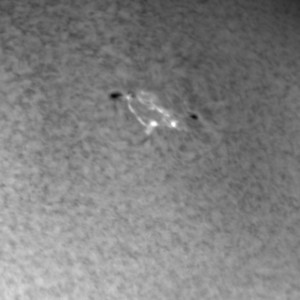 AR 12941 at 19:38:28 UT, near the peak of the C3 flare.
AR 12941 at 19:38:28 UT, near the peak of the C3 flare.
Solar activity is expected to be very low through at least 11 February, with more C-class flares likely, and a slight chance of an M-class flare.
February 8, 2022
Solar activity remained low today with not too much changing with the visible active regions. The large prominence we’ve been watching for the last several days did launch itself into interplanetary space just after local midnight, CST, last night ( = 6:00 UT). This morning, only some remnants were left, which disappeared completely by 17:00 UT. A minor flare kernel was observed in AR 12939 near the end of the event; this was a C1.2 flare that peaked at 16:38, observations made at 16:45 UT.
The region AR 12936, which rotated out of view a few days ago, continues to produce measurable flare activity. A number of B- and C-class events were observed yesterday, into today, and these were thought to have come from just over the west limb, where 12936 is located.
Solar activity is expected to remain very low, with C-class flares likely (and a slight chance for an M-class flare) through at least 10 February.
February 7, 2022
A generally quiet Sun presents itself today, with all of the visible active regions rather small and mostly stable. AR 12939, appearing a little more than a simple spot with attendants immediately south of it, was the source of four flares (2 B9, 2 C1) between 0:00 and 12:00 UT today. AR 12939 was the source of a long-duration C3/SF flare that peaked at 13:41 UT on 6 February. This flare caused a 10-degree long filament, suspended over the region, to lift off and produced two CME’, which are expected to impact the Earth late 9 Feb to early 10 Feb.
AR 12940 and 12941 both produced occasional low-C-class flares. The large prominence on the southeast limb remains, and as of 22:06 UT (7 Feb) remains anchored to the sun. A new, small active region developed since the last observation session. AR 12942 is already nearing the edge of the Sun and will rotate out of view in two days.
The image that features the prominence is rotated so that celestial east is up, north is right; it is cropped to 13.3′ x 6.7′. The remainder of the images were cropped to 13.3’x13.3′ and oriented so that celestial north is up, east is left. The images in the left column are red continuum images, 0.1 second exposures; the images in the right column are 1.0 second H-alpha exposures.
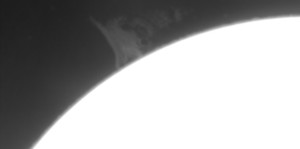 SE Limb Prominence at 16:28:20 UT
SE Limb Prominence at 16:28:20 UT
Solar activity is expected to remain very low, with C-class flares likely (and a slight chance for an M-class flare) through at least 9 February.
February 5, 2022
Observations resume today with the large active region 12836 rotating out of view. This region grew significantly, quadrupling in size over a 48 hour period after the January 27 observing session and became more complex by 29 January (check out the sunspot growth animation from spaceweather.com). By then it had the potential to produce major flares but it was largely quiet for the remainder of its journey across the solar disk. It had been producing C-class solar flares every 4 to 5 hours along with a long duration M1 flare (23:49 UT, 29 Jan 2022) which generated a coronal mass ejection. The large active region quickly resumed a bi-polar configuration, displaying a large leader spot and a large trailing spot. The CME arrived late on February 1 but failed to produce any significant geomagnetic storm.
This region is in the process of rotating out of view, but a few more regions have sprung up. These are pictured below. One feature of note is a large prominence off the southeast limb of the Sun. It has the potential of lifting off the Sun at any time. The image that features the prominence is rotated so that celestial east is up, north is right; it is cropped to 13.3′ x 6.7′. The remainder of the images were cropped to 13.3’x13.3′ and oriented so that celestial north is up, east is left. The images in the left column are red continuum images, 0.1 second exposures; the images in the right column are 1.0 second H-alpha exposures.
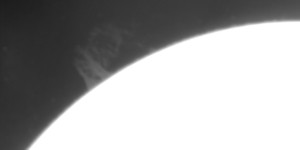 Prominence, as imaged at 17:19:06 UT.
Prominence, as imaged at 17:19:06 UT.
Solar activity is expected to remain very low through 7 February.
January 27, 2022
Weather and other factors have limited observations this month. Solar activity is picking up a bit, with an M1 flare occurring at 23:45 UT on 25 January. Since then, a C7 event occurred at 7:30:00 UT on 26 January, then only minor C-class flares after that. The most recent of these events was at 12:20:00 UT today, a C1.4 event from AR 12836.
All the images below are cropped to 13.3′ square and oriented so that celestial north is up, east is left. The left column contains red continuum images, each a 0.1 second exposure at the indicated time. The right column contains H-alpha images, each 1.0 second at the indicated time.
Solar activity is expected to remain low through at least 29 January. There is a slight chance for an M-class flare, most likely from 12936.
January 21, 2022
The sunspot group AR 12929 had been active over the past week since observations were last taken at our Observatory. It generated an M1.5 class solar flare at 17:44 UT on 18 January. The same active regions erupted again at 6:01 UT on 20 January, producing a strong M5.5-class solar flare. Since then the sunspot group had just rotated out of view. It had been quiet since. The other spot groups that have peppered the sun’s face have either rotated out of view or dissipated.
Solar Activity is expected to remain very low through at least 23 January 2022. There is a slight chance of a C-Class activity early on.
January 14, 2022
Overnight (local time, central U.S.) the Sun unleashed an M-1 class flare with enough potency to ionize the top of Earth’s atmosphere on the dayside of the planet. This event caused a shortwave radio blackout over Australia, where the ionization was strongest. The region that produced this flare lies just over the northeast limb of the Sun, so the flare was likely closer to an X-class event due to the Sun eclipsing most of the event.
Three new spot groups/active regions have emerged on the Earth-facing disk of the Sun. Two of these, near the disk center, were observed yesterday in their early stages of formation. These are AR 12929 (the southern one) and 12930 (the northern one). In addition, another AR, appearing little more than a white spot in H-alpha yesterday, has become a full-blown active region today. These are shown in the images below.
With the long weekend and the start of Spring 2022 semester, this may be the last imaging session for several days.
Solar activity is expected to remain very low, with a likely chance of C-class flare activity, through at least January 16. Around then or shortly afterward, activity could increase as the region just out of view over the northeast limb rotates into view.
January 13, 2022
After two cloudy days, the skies clear again to allow the observations of a speckled Sun. There are many sunspots visible, mostly quiet groups, with two more emerging. Activity is low, with three C-class flares occurring from a region just over the northeastern limb of the Sun. Of the visible regions, only AR 12924 has shown any activity, with a B7.4 flare at 17:17 UT.
More activity could be literally around the solar corner: with the unseen region producing measurable X-ray flares, it also produced at least two coronal mass ejections. The region responsible for this activity should be rotating into view in the next several days or so.
In addition to the images presented below (left column includes red continuum images, right column are H-alpha images), a status check chart of the current sunspot cycle is presented.
Solar activity is expected to remain low, with a chance of more C-class flare activity through at least January 15.
January 10, 2022
Solar observations resumed today. The Sun currently displays four active regions, all of which are quiet and either stable or in slow decay.
Venus passed inferior conjunction on Saturday, January 8, and is still 5.9 degrees from the Sun as it transitions into the morning sky. The first image below is Venus, taken with the camera, through the neutral density filter and red energy rejection filter. The crescent was 62.6″ across and 0.5% illuminated when this image was taken. The dome blocked part of the aperture to prevent stray sunlight from entering the system.
Seeing (atmospheric steadiness) varied through today’s short session, being rather poor during the continuum image acquisition, but improving some during the H-alpha acquisition. The red continuum image below shows two active regions: AR 12924 includes the two spots right of center; and AR 12925 is the single spot left of center. The continuum image covers 18.0’x13.3′ of the sky and was made with a 0.1 second exposure at the time indicated. The remaining four images are H-alpha, 13.3’x13.3′ in size and 1.0 second exposure. Prominences were visible in many locations including along the northeast limb (last picture).
Solar activity is expected to remain very low through at least January 12. There is a chance for C-flares-and a slight chance of M-flares (mainly from AR 12925) during this period.

